Are you seeking one-on-one college counseling and/or essay support? Limited spots are now available. Click here to learn more.

54 Most Interesting Technology Research Topics for 2023
May 30, 2023
Scrambling to find technology research topics for the assignment that’s due sooner than you thought? Take a scroll down these 54 interesting technology essay topics in 10 different categories, including controversial technology topics, and some example research questions for each.
Social technology research topics
Whether you have active profiles on every social media platform, you’ve taken a social media break, or you generally try to limit your engagement as much as possible, you probably understand how pervasive social technologies have become in today’s culture. Social technology will especially appeal to those looking for widely discussed, mainstream technology essay topics.
- How do viewers respond to virtual influencers vs human influencers? Is one more effective or ethical over the other?
- Across social media platforms, when and where is mob mentality most prevalent? How do the nuances of mob mentality shift depending on the platform or topic?
- Portable devices like cell phones, laptops, and tablets have certainly made daily life easier in some ways. But how have they made daily life more difficult?
- How does access to social media affect developing brains? And what about mature brains?
- Can dating apps alter how users perceive and interact with people in real life?
- Studies have proven “doomscrolling” to negatively impact mental health—could there ever be any positive impacts?
Cryptocurrency and blockchain technology research topics
Following cryptocurrency and blockchain technology has been a rollercoaster the last few years. And since Bitcoin’s conception in 2009, cryptocurrency has consistently showed up on many lists of controversial technology topics.
- Is it ethical for celebrities or influential people to promote cryptocurrencies or cryptographic assets like NFTs ?
- What are the environmental impacts of mining cryptocurrencies? Could those impacts ever change?
- How does cryptocurrency impact financial security and financial health?
- Could the privacy cryptocurrency offers ever be worth the added security risks?
- How might cryptocurrency regulations and impacts continue to evolve?
- Created to enable cryptocurrency, blockchain has since proven useful in several other industries. What new uses could blockchain have?
Artificial intelligence technology research topics
We started 2023 with M3GAN’s box office success, and now we’re fascinated (or horrified) with ChatGPT , voice cloning , and deepfakes . While people have discussed artificial intelligence for ages, recent advances have really pushed this topic to the front of our minds. Those searching for controversial technology topics should pay close attention to this one.
- OpenAI –the company behind ChatGPT–has shown commitment to safe, moderated AI tools that they hope will provide positive benefits to society. Sam Altman, their CEO, recently testified before a US Senate He described what AI makes possible and called for more regulation in the industry. But even with companies like OpenAI displaying efforts to produce safe AI and advocating for regulations, can AI ever have a purely positive impact? Are certain pitfalls unavoidable?
- In a similar vein, can AI ever actually be ethically or safely produced? Will there always be certain risks?
- How might AI tools impact society across future generations?
- Countless movies and television shows explore the idea of AI going wrong, going back all the way to 1927’s Metropolis . What has a greater impact on public perception—representations in media or industry developments? And can public perception impact industry developments and their effectiveness?
Beauty and anti-aging technology
Throughout human history, people in many cultures have gone to extreme lengths to capture and maintain a youthful beauty. But technology has taken the pursuit of beauty and youth to another level. For those seeking technology essay topics that are both timely and timeless, this one’s a gold mine.
- With augmented reality technology, companies like Perfect allow app users to virtually try on makeup, hair color, hair accessories, and hand or wrist accessories. Could virtual try-ons lead to a somewhat less wasteful beauty industry? What downsides should we consider?
- Users of the Perfect app can also receive virtual diagnoses for skin care issues and virtually “beautify” themselves with smoothed skin, erased blemishes, whitened teeth, brightened under-eye circles, and reshaped facial structures. How could advancements in beauty and anti-aging technology affect self-perception and mental health?
- What are the best alternatives to animal testing within the beauty and anti-aging industry?
- Is anti-aging purely a cosmetic pursuit? Could anti-aging technology provide other benefits?
- Could people actually find a “cure” to aging? And could a cure to aging lead to longer lifespans?
- How might longer human lifespans affect the Earth?
Geoengineering technology research topics
An umbrella term, geoengineering refers to large-scale technologies that can alter the earth and its climate. Typically, these types of technologies aim to combat climate change. Those searching for controversial technology topics should consider looking into this one.
- What benefits can solar geoengineering provide? Can they outweigh the severe risks?
- Compare solar geoengineering methods like mirrors in space, stratospheric aerosol injection, marine cloud brightening, and other proposed methods. How have these methods evolved? How might they continue to evolve?
- Which direct air capture methods are most sustainable?
- How can technology contribute to reforestation efforts?
- What are the best uses for biochar? And how can biochar help or harm the earth?
- Out of all the carbon geoengineering methods that exist or have been proposed, which should we focus on the most?
Creative and performing arts technology topics
While tensions often arise between artists and technology, they’ve also maintained a symbiotic relationship in many ways. It’s complicated. But of course, that’s what makes it interesting. Here’s another option for those searching for timely and timeless technology essay topics.
- How has the relationship between art and technology evolved over time?
- How has technology impacted the ways people create art? And how has technology impacted the ways people engage with art?
- Technology has made creating and viewing art widely accessible. Does this increased accessibility change the value of art? And do we value physical art more than digital art?
- Does technology complement storytelling in the performing arts? Or does technology hinder storytelling in the performing arts?
- Which current issues in the creative or performing arts could potentially be solved with technology?
Cellular agriculture technology research topics
And another route for those drawn to controversial technology topics: cellular agriculture. You’ve probably heard about popular plant-based meat options from brands like Impossible and Beyond Meat . While products made with cellular agriculture also don’t require the raising and slaughtering of livestock, they are not plant-based. Cellular agriculture allows for the production of animal-sourced foods and materials made from cultured animal cells.
- Many consumers have a proven bias against plant-based meats. Will that same bias extend to cultured meat, despite cultured meat coming from actual animal cells?
- Which issues can arise from patenting genes?
- Does the animal agriculture industry provide any benefits that cellular agriculture may have trouble replicating?
- How might products made with cellular agriculture become more affordable?
- Could cellular agriculture conflict with the notion of a “ circular bioeconomy ?” And should we strive for a circular bioeconomy? Can we create a sustainable relationship between technology, capitalism, and the environment, with or without cellular agriculture?
Transportation technology research topics
For decades, we’ve expected flying cars to carry us into a techno-utopia, where everything’s shiny, digital, and easy. We’ve heard promises of super fast trains that can zap us across the country or even across the world. We’ve imagined spring breaks on the moon, jet packs, and teleportation. Who wouldn’t love the option to go anywhere, anytime, super quickly? Transportation technology is another great option for those seeking widely discussed, mainstream technology essay topics.
- Once upon a time, Lady Gaga was set to perform in space as a promotion for Virgin Galactic . While Virgin Galactic never actually launched the iconic musician/actor, soon, they hope to launch their first commercial flight full of civilians–who paid $450,000 a pop–on a 90-minute trip into the stars. And if you think that’s pricey, SpaceX launched three businessmen into space for $55 million in April, 2022 (though with meals included, this is actually a total steal). So should we be launching people into space just for fun? What are the impacts of space tourism?
- Could technology improve the way hazardous materials get transported?
- How can the 5.9 GHz Safety Band affect drivers?
- Which might be safer: self-driving cars or self-flying airplanes?
- Compare hyperloop and maglev Which is better and why?
- Can technology improve safety for cyclists?
Gaming technology topics
A recent study involving over 2000 children found links between video game play and enhanced cognitive abilities. While many different studies have found the impacts of video games to be positive or neutral, we still don’t fully understand the impact of every type of video game on every type of brain. Regardless, most people have opinions on video gaming. So this one’s for those seeking widely discussed, mainstream, and controversial technology topics.
- Are different types or genres of video games more cognitively beneficial than others? Or are certain gaming consoles more cognitively beneficial than others?
- How do the impacts of video games differ from other types of games, such as board games or puzzles?
- What ethical challenges and safety risks come with virtual reality gaming?
- How does a player perceive reality during a virtual reality game compared to during other types of video games?
- Can neurodivergent brains benefit from video games in different ways than neurotypical brains?
Medical technology
Advancements in healthcare have the power to change and save lives. In the last ten years, countless new medical technologies have been developed, and in the next ten years, countless more will likely emerge. Always relevant and often controversial, this final technology research topic could interest anyone.
- Which ethical issues might arise from editing genes using CRISPR-Cas9 technology? And should this technology continue to be illegal in the United States?
- How has telemedicine impacted patients and the healthcare they receive?
- Can neurotechnology devices potentially affect a user’s agency, identity, privacy, and/or cognitive liberty?
- How could the use of medical 3-D printing continue to evolve?
- Are patients more likely to skip digital therapeutics than in-person therapeutic methods? And can the increased screen-time required by digital therapeutics impact mental health
What do you do next?
Now that you’ve picked from this list of technology essay topics, you can do a deep dive and immerse yourself in new ideas, new information, and new perspectives. And of course, now that these topics have motivated you to change the world, look into the best computer science schools , the top feeders to tech and Silicon Valley , the best summer programs for STEM students , and the best biomedical engineering schools .
- College Success
- High School Success
Mariya holds a BFA in Creative Writing from the Pratt Institute and is currently pursuing an MFA in writing at the University of California Davis. Mariya serves as a teaching assistant in the English department at UC Davis. She previously served as an associate editor at Carve Magazine for two years, where she managed 60 fiction writers. She is the winner of the 2015 Stony Brook Fiction Prize, and her short stories have been published in Mid-American Review , Cutbank , Sonora Review , New Orleans Review , and The Collagist , among other magazines.
- 2-Year Colleges
- Application Strategies
- Best Colleges by Major
- Best Colleges by State
- Big Picture
- Career & Personality Assessment
- College Essay
- College Search/Knowledge
- Costs & Financial Aid
- Data Visualizations
- Dental School Admissions
- Extracurricular Activities
- Graduate School Admissions
- High Schools
- Homeschool Resources
- Law School Admissions
- Medical School Admissions
- Navigating the Admissions Process
- Online Learning
- Outdoor Adventure
- Private High School Spotlight
- Summer Program Spotlight
- Summer Programs
- Teacher Tools
- Test Prep Provider Spotlight
“Innovative and invaluable…use this book as your college lifeline.”
— Lynn O'Shaughnessy
Nationally Recognized College Expert
College Planning in Your Inbox
Join our information-packed monthly newsletter.
MIT Technology Review
- Newsletters
10 Breakthrough Technologies

The end of passwords
For decades, we’ve needed passwords to do things online. New forms of authentication will finally let us get rid of them for good. Instead, we’ll use a link sent via email, a push notification, or a biometric scan. Not only are these methods easier—you don’t have to remember your face—but they tend to be more secure.
Covid variant tracking
The pandemic brought unprecedented investment in genomic sequencing and dramatically expanded the capacity for this type of monitoring around the world. Better surveillance has allowed scientists to track the spread of the covid virus and to quickly spot and warn about new variants.
A long-lasting grid battery
We’re using more renewable power than ever. But what happens when the sun sets or the wind stops? Grid operators need a way to store electricity for later. New iron-based batteries may be up to the task. They’re made using abundant materials and could be cheaper and more practical than other types of grid storage.
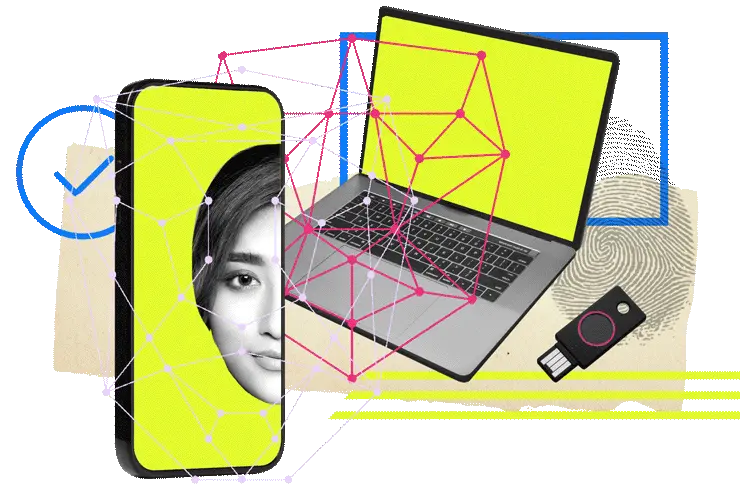
Break down the breakthroughs
Explore the promising, the elusive, and the unexpected with MIT Technology Review.
AI for protein folding
Nearly everything your body does, it does with proteins. And the way a protein folds determines its activity. But figuring out proteins’ structure can take months. Now an AI called AlphaFold2 has solved this longstanding biological puzzle, which could make it possible to quickly design drugs for a wide range of diseases.
Malaria Vaccine
Malaria kills more than 600,000 people a year, most of them children younger than five. A new malaria vaccine approved by the World Health Organization could help save hundreds of thousands of lives every year. It’s also the world’s first vaccine for a parasitic infection.
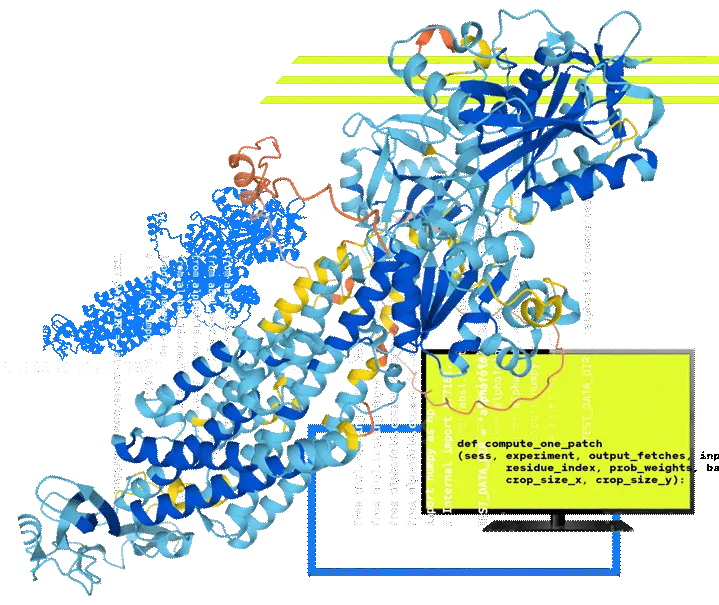
Never miss a breakthrough
Sign up for our daily newsletter, the Download .
By signing up, you agree to our Privacy Policy .
Thank you for submitting your email!
Something went wrong, try again., proof of stake.
Cryptocurrencies like Bitcoin use huge amounts of electricity. This is due to the way transactions are verified, which now requires significant computing power. Proof of stake offers a way to verify transactions without using so much energy. Ethereum plans to transition to the system this year, cutting energy use by 99.95%.
A pill for covid
A new drug from Pfizer provides effective and broad protection against the covid-19 virus, including the newest variants. Now other companies are developing similar medicines. Combined with vaccines, these pills could provide a way for the world to finally exit the pandemic.
Practical fusion reactors
The promise of limitless, carbon-free electricity has for decades inspired researchers to try to make fusion power work. Now one startup plans to deliver it to the grid by the early 2030s. Its design relies on a powerful new magnet that shattered records and should allow the company to build smaller, less expensive reactors.
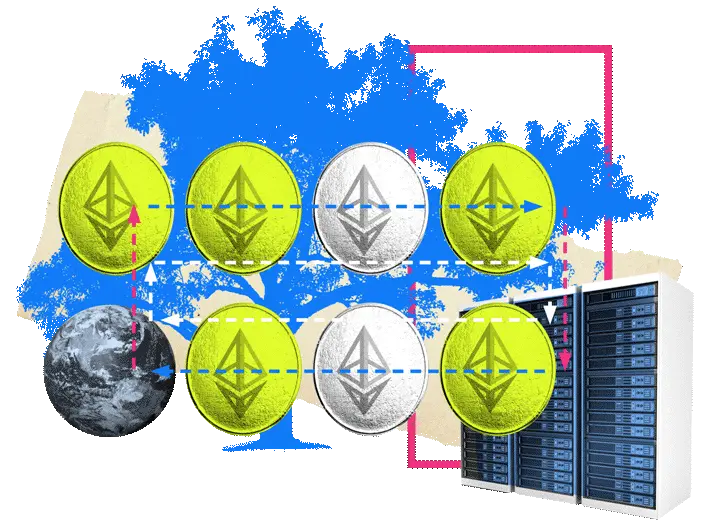
Synthetic data for AI
Training AI requires vast amounts of data. Oftentimes, though, that data is messy or reflects real-world biases, or there are privacy concerns around the information included. Some companies are starting to create and sell synthetic data to avoid these problems. It’s not perfect, but it could be a better way to train AI.
A carbon removal factory
Reducing emissions is a key step to mitigating climate change. But it’s not enough, according to the UN. To avoid catastrophic future warming, we must also remove carbon dioxide from the air. The world’s biggest carbon removal factory recently opened in Iceland to do just that.
you Voted for the 11th breakthrough
Presenting the winner of the 11th breakthrough poll:
Back to top
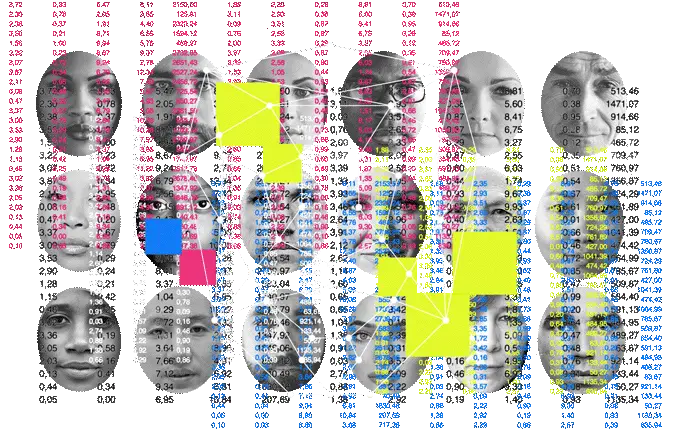
Learn about the winner
Aging clocks.
DNA markers are making it possible to track the aging process in real time, and helping scientists understand why people age at different rates.
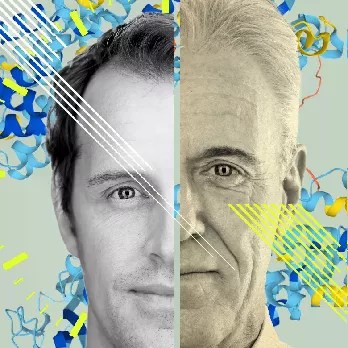
About the list
10 breakthrough technologies 2022.
Our annual list of 10 Breakthrough Technologies highlights the technological advances that we think will have the biggest impact on the world in the years to come. Every year, our reporters and editors survey a wide range of topics, from medicine to energy to digital technologies, to select advances that will affect our lives in meaningful ways. Some have already started to change the way we live and work, while others are poised to do so soon. This is the 21st year we’ve published this list. We hope you enjoy this glimpse into the future.
Editing: Rachel Courtland, Mat Honan, Amy Nordrum, Michael Reilly, and David Rotman Copy editing: Linda Lowenthal Design: Rachel Stein, Solomon Henry Roh Art direction: Eric Mongeon, Rachel Stein Illustration: Andrea D’Aquino Additional images: protein model courtesy of Deepmind, practical fusion reactors photography by Tony Luong, carbon removal factory photography by Kristján Maack Engineering: Jack Burns, Andre Vitorio Analytics: Danielle Golds Engagement: Abby Ivory-Ganja Product: Mariya Sitnova

- Services Paper editing services Paper proofreading Business papers Philosophy papers Write my paper Term papers for sale Term paper help Academic term papers Buy research papers College writing services Paper writing help Student papers Original term papers Research paper help Nursing papers for sale Psychology papers Economics papers Medical papers Blog

177 of the Finest Technology Research Topics in 2023
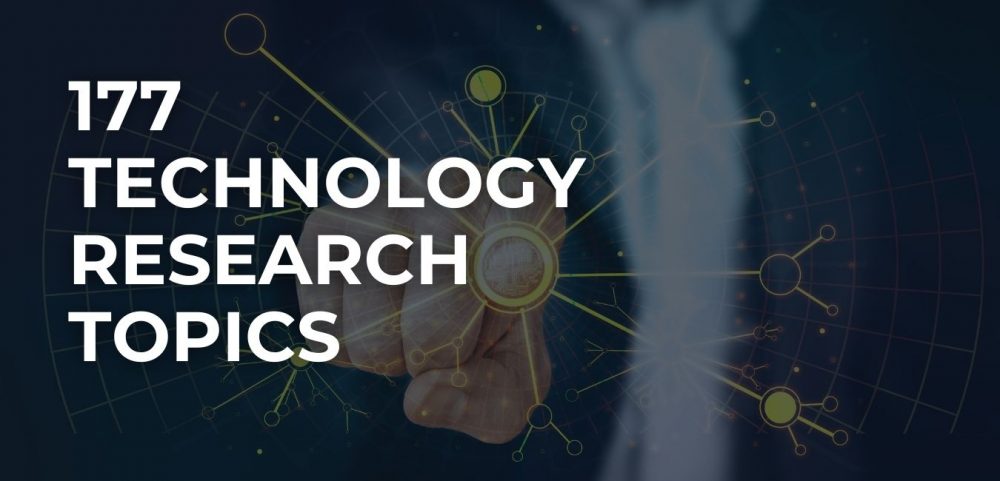
We live in a technological era, and you can be sure of being asked to write a technology-oriented paper. Despite the contrary opinion that this is one of the most complicated tasks, students can comfortably develop a professional topic about technology for writing a research paper . In a technology research paper, students are tasked with exploring the various aspects of technology, such as inventions, their impacts, and emerging challenges. Since almost every sphere of life encompasses technology, it is nearly impossible to miss out on a technology topic or two.
High-quality technology research paper topics should: Demonstrate your understanding of various technological concepts Portray your ability to apply these concepts to real-life situations Show how technology impacts society.
The task of coming up with technology topics involves the following stages:
- Extensively reading on technology
- Identifying distinct technological aspects
- Brainstorming on potential technology titles for your paper
- Consulting your supervisor
The last step is essential in ensuring that your topic aligns with the academic standards of your institutions. Have a look at the following writing prompts for your inspiration:
Medical laboratory Technology Research Topics
- The role of technological innovations in the medical laboratories
- Cost-saving technologies in the field of medical laboratory
- A comparative analysis of the current techniques in the microbial examination
- The role of technology in the isolation and identification of nematodes
- The effects of 5G on the study of cancerous cells
- Evaluating the concentration of electrolytes using technology
- Describe the various parameters used in biochemical reactions
- A comparative analysis of the activities of cells under a light microscope
- Assess the various technologies used to view microscopic organisms
- An evaluation of the role of technology in combating COVID-19
Interesting Information Technology Topics
- Challenges facing cloud computing and virtualization
- Various Federal information standards that affect information technologies
- Discuss the various identity and access management practices for information technologies
- Why the male dominates the field of computational science
- Analyze the various cybersecurity issues arising
- Evaluate the various challenges associated with software research
- Why is the field of networking prone to attacks?
- Health issues arising from the use of biometrics in companies
- Why data entry is attracting a large number of interested parties
- The role of the Internet of Things is transforming the world.
Argumentative Technology Topics
- Why mobile devices can be both instruments and victims of privacy violations
- Why PINs and passwords for mobile devices are a security threat
- The impact of downloading malware disguised as a useful application
- Reasons why out-of-date operating systems are a threat to your computer’s security
- Why it is not advisable to use wireless transmissions that are not always encrypted
- Changes in workflow and project management arising from technological advancements
- The best method to develop and implement cloud solutions for companies
- The cost of having cloud engineers and support professionals
- The role of workplace monitoring in interfering with people’s privacy
- Why information technology laws vary from one country to another
Trending Topics in Technology
- Why technology is essential for an informed society
- The impact of freedom of speech on social networking sites
- Was Facebook justified in blocking Donald Trump from its platform?
- Ethical challenges arising from the new technological innovations
- Why it is not possible to achieve social media privacy
- The impact of online learning sites on the quality of workplace professionals
- Are electric cars the future of the world
- Reasons why technology is essential in developing coronavirus vaccines
- Discuss the various aspects of the Internet of Behaviours (IoB)
- Strides made in the development of intelligent process automation technologies
Hot Research Proposal Topics in Information Technology
- Discuss the considerations in developing human augmentation technologies
- Will big data analytics survive in the future?
- Is it possible to achieve a paper-free world?
- Long-term effects of over-dependence on technology
- Is technology solving world problems or creating more of them?
- What is the impact of children growing up in a technology oriented world?
- How was social media responsible for the chaos at the US Capitol?
- Is it right for governments to monitor and censor citizen’s access to the internet?
- The impact of texting and calling on family relationships
- What are the implications of depending on online thesis help?
Want to get an A+ grade? Try our college paper writing service and discover the benefits of high-quality and cheap paper writing help.
Top-notch Research Paper Topics on Technology
- The impact of Genetically Modified organisms on the health of a population
- Compare and contrast the functioning of the human brain to that of a computer.
- The role of video games on a person’s problem-solving skills
- Where is technology taking the world in the next ten years?
- What digital tools make people less productive?
- What censorship mechanisms are needed to control people’s behavior on the internet?
- The impact of digital learning on schools
- Why is genetic testing essential for couples?
- Discuss the ethical implications of mechanical reproduction
- Discuss the role of innovations in finding treatment for terminal diseases
Latest Research Topics About technology
- The impact of computers in academic research
- Why artificial intelligence may not be the best option for our daily lives
- Should parents restrict the amount of time spent on the internet by their kids?
- What are the legal and moral implications of digital voting?
- Is augmented reality the new way of online shopping?
- Discuss the challenges that arise from game addiction
- Evaluate the safety of VPNs in a global enterprise
- Why is streaming becoming the best option for church services?
- Discuss the efficiency of working from home versus physically going to the workplace
- The effects of computer-generated imagery in films and games
Controversial Technology Topics
- Does online communication make the world bigger or smaller?
- What is the ethical implication of having ID chips in our brains?
- Should families use gene editing for coming up with children of desirable qualities?
- Are the cybersecurity laws punitive enough?
- Is cryptocurrency turning around the financial industry for the worst?
- Are self-driving vehicles safe on our roads?
- Is it possible to attain self-awareness using Artificial Intelligence technologies?
- The risk of x-rays on a person’s health
- Is it possible for robots to live peacefully with humans?
- Compare and contrast between machine learning and natural language processing
Impressive Technology Topic Ideas for High School
- The impact of developing autonomous cars using computer vision applications
- Discuss the interconnection between the internet of things and artificial intelligence
- The effects of ultra-violet technologies in the health industry
- The impact of communication networks on people’s attitudes
- The role of internet technologies on marketing and branding
- How has the world of music changed with the emergence of video editing technologies?
- Describe the psychology behind video blog communication
- Effective ways of maintaining privacy in social media
- Is it possible to live without mass media in the world?
- The impact of technology on the morality of the world in the 21 st century
Educational Technology Topics
- Why is technology relevant in advancing scientific research?
- Discuss how computational thinking is shaping critical thinking among students
- What is the effect of professional learning for college students?
- The role of virtual reality in helping students understand complex concepts
- Is global learning through technology watering down education standards?
- Discuss various energy sources to support technology use in education
- Is the architecture of learning systems inclusive enough?
- Discuss the impact of connectivity for schools & learning, esp. in rural environments
- The role of data centers in education
- Is it possible to develop sufficient national capacities related to science, technology, and innovation?
Updated Technology Related Topics in Agriculture
- The role of soil and water sensors in improving crop yields
- Why farmers rely on weather tracking technologies for their farming activities
- The significant role of satellite imaging in agricultural activities
- How do farmers use pervasive automation technologies for their farms?
- The effect of mini-chromosomal technologies on agriculture
- Why vertical agriculture is the future of agriculture
- Conditions necessary for hydroponics in developed nations
- The impact of agricultural technologies in ensuring stable food supply
- How agricultural technologies can be used to ensure decreased use of water
- Using agricultural technologies to enhance worker safety on the farm
Top Technology Persuasive Speech Topics
- An analysis of digital media outreach and engagement in workplaces
- What are the challenges experienced in distance learning
- Describe personalized and adaptive learning platforms and tools
- Should computer viruses count as life?
- Describe the connection between human perception and virtual reality
- What is the future of computer-assisted education in colleges?
- Analyze the high dimensional data modeling procedure
- Evaluate the imperative and declarative languages in computer programming
- Analyze how the machine architecture affects the efficiency of the code
- What are the discrepancies in different languages for parallel computing?
Latest Controversial Topics in Technology
- Do you think computational thinking affects science?
- An overview of the phishing trends in the recent past
- How are sensor networks a threat to one’s privacy?
- Compare and contrast lithium-ion and lithium-air batteries.
- Can hydrogen replace all other energy sources in the future?
- Discuss the future of tidal power: Will it persist or become extinct?
- Why robots are a threat to the survival of humanity
- Analyze the effectiveness of small nuclear reactors in the wake of climatic change
- An overview of the different types of renewable energy technologies in the world
- Are drones a threat to security or a potential security mechanism?
Hot Topics in Technology
- Discuss the impacts of new technologies on food production and security
- The effectiveness of 3D printing for medical products
- What is the ethical argument behind the production of artificial body organs?
- Discuss the role of genetic engineering in medicine
- Challenges associated with the development of telemedicine
- Conduct a case study analysis on the effectiveness of genome editing
- Discuss the role of nanotechnology in cancer treatment
- The role of virtual reality in medical schools
- Discuss the effectiveness of wireless communication technologies for teenagers
- How safe are you when connected to a wireless network?
Science and Technology Topics
- Analyze the security threats associated with pharmaceutical technologies
- An overview of the chip technology in the practice of medicine
- Compare and contrast between electric cars and hybrid cars
- Why are personal transportation pods the future of transport
- Threats and solutions to cell phone use during driving
- Effects of scientific innovations on the world
- Are water-fueled cars a future fantasy or reality?
- The role of robotics in food packaging
- Modern solar system innovations
- The role of smart energy in combating global warming
Top-Notch Research Topics on Technology
- An overview of the different operating systems
- The role of theoretical computer science
- Discuss the development of computer graphics
- What are the loopholes in block-chain technology?
- Why banking systems need extra security measures
- What is the future of cyber systems?
- Ways of protecting your password from hackers
- The role of ICT in new media technologies
- How to deal with cyberbullying from Twitter
- The future of interpersonal communication with the rise of social media
Researchable Topics About Technology
- Factors that lead to viral messages on Twitter
- Freedom of speech and social media
- Activism in the wake of new media
- Discuss the psychology behind advertising techniques
- Interactive media technologies
- How has the internet changed communication networks?
- Role of media during pandemics
- Ethics in internet technologies
- The persistence of newspapers in the digital age
- Impact of technology on lifestyle diseases
Bonus Technology Topic Ideas
- Agricultural biotechnology
- Gene therapy
- Development of vaccines
- Genome sequencing
- Food processing technologies
- Technology and drugs
- Recommended systems
Are you stuck and need a sample paper to jumpstart your writing? Our help with the research paper service is all you need! Get your college paper done by experts at affordable rates today.

Leave a Reply Cancel reply
Your email address will not be published. Required fields are marked *
Save my name, email, and website in this browser for the next time I comment.
Terms & Conditions Loyalty Program Privacy Policy Money-Back Policy
Copyright © 2013-2024 MyPaperDone.com
Research Topics & Ideas: CompSci & IT
50+ Computer Science Research Topic Ideas To Fast-Track Your Project
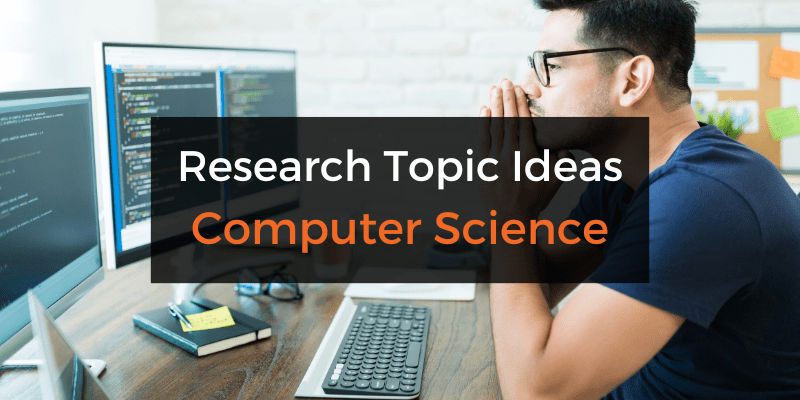
Finding and choosing a strong research topic is the critical first step when it comes to crafting a high-quality dissertation, thesis or research project. If you’ve landed on this post, chances are you’re looking for a computer science-related research topic , but aren’t sure where to start. Here, we’ll explore a variety of CompSci & IT-related research ideas and topic thought-starters, including algorithms, AI, networking, database systems, UX, information security and software engineering.
NB – This is just the start…
The topic ideation and evaluation process has multiple steps . In this post, we’ll kickstart the process by sharing some research topic ideas within the CompSci domain. This is the starting point, but to develop a well-defined research topic, you’ll need to identify a clear and convincing research gap , along with a well-justified plan of action to fill that gap.
If you’re new to the oftentimes perplexing world of research, or if this is your first time undertaking a formal academic research project, be sure to check out our free dissertation mini-course. In it, we cover the process of writing a dissertation or thesis from start to end. Be sure to also sign up for our free webinar that explores how to find a high-quality research topic.
Overview: CompSci Research Topics
- Algorithms & data structures
- Artificial intelligence ( AI )
- Computer networking
- Database systems
- Human-computer interaction
- Information security (IS)
- Software engineering
- Examples of CompSci dissertation & theses
Topics/Ideas: Algorithms & Data Structures
- An analysis of neural network algorithms’ accuracy for processing consumer purchase patterns
- A systematic review of the impact of graph algorithms on data analysis and discovery in social media network analysis
- An evaluation of machine learning algorithms used for recommender systems in streaming services
- A review of approximation algorithm approaches for solving NP-hard problems
- An analysis of parallel algorithms for high-performance computing of genomic data
- The influence of data structures on optimal algorithm design and performance in Fintech
- A Survey of algorithms applied in internet of things (IoT) systems in supply-chain management
- A comparison of streaming algorithm performance for the detection of elephant flows
- A systematic review and evaluation of machine learning algorithms used in facial pattern recognition
- Exploring the performance of a decision tree-based approach for optimizing stock purchase decisions
- Assessing the importance of complete and representative training datasets in Agricultural machine learning based decision making.
- A Comparison of Deep learning algorithms performance for structured and unstructured datasets with “rare cases”
- A systematic review of noise reduction best practices for machine learning algorithms in geoinformatics.
- Exploring the feasibility of applying information theory to feature extraction in retail datasets.
- Assessing the use case of neural network algorithms for image analysis in biodiversity assessment
Topics & Ideas: Artificial Intelligence (AI)
- Applying deep learning algorithms for speech recognition in speech-impaired children
- A review of the impact of artificial intelligence on decision-making processes in stock valuation
- An evaluation of reinforcement learning algorithms used in the production of video games
- An exploration of key developments in natural language processing and how they impacted the evolution of Chabots.
- An analysis of the ethical and social implications of artificial intelligence-based automated marking
- The influence of large-scale GIS datasets on artificial intelligence and machine learning developments
- An examination of the use of artificial intelligence in orthopaedic surgery
- The impact of explainable artificial intelligence (XAI) on transparency and trust in supply chain management
- An evaluation of the role of artificial intelligence in financial forecasting and risk management in cryptocurrency
- A meta-analysis of deep learning algorithm performance in predicting and cyber attacks in schools

Topics & Ideas: Networking
- An analysis of the impact of 5G technology on internet penetration in rural Tanzania
- Assessing the role of software-defined networking (SDN) in modern cloud-based computing
- A critical analysis of network security and privacy concerns associated with Industry 4.0 investment in healthcare.
- Exploring the influence of cloud computing on security risks in fintech.
- An examination of the use of network function virtualization (NFV) in telecom networks in Southern America
- Assessing the impact of edge computing on network architecture and design in IoT-based manufacturing
- An evaluation of the challenges and opportunities in 6G wireless network adoption
- The role of network congestion control algorithms in improving network performance on streaming platforms
- An analysis of network coding-based approaches for data security
- Assessing the impact of network topology on network performance and reliability in IoT-based workspaces

Topics & Ideas: Database Systems
- An analysis of big data management systems and technologies used in B2B marketing
- The impact of NoSQL databases on data management and analysis in smart cities
- An evaluation of the security and privacy concerns of cloud-based databases in financial organisations
- Exploring the role of data warehousing and business intelligence in global consultancies
- An analysis of the use of graph databases for data modelling and analysis in recommendation systems
- The influence of the Internet of Things (IoT) on database design and management in the retail grocery industry
- An examination of the challenges and opportunities of distributed databases in supply chain management
- Assessing the impact of data compression algorithms on database performance and scalability in cloud computing
- An evaluation of the use of in-memory databases for real-time data processing in patient monitoring
- Comparing the effects of database tuning and optimization approaches in improving database performance and efficiency in omnichannel retailing
Topics & Ideas: Human-Computer Interaction
- An analysis of the impact of mobile technology on human-computer interaction prevalence in adolescent men
- An exploration of how artificial intelligence is changing human-computer interaction patterns in children
- An evaluation of the usability and accessibility of web-based systems for CRM in the fast fashion retail sector
- Assessing the influence of virtual and augmented reality on consumer purchasing patterns
- An examination of the use of gesture-based interfaces in architecture
- Exploring the impact of ease of use in wearable technology on geriatric user
- Evaluating the ramifications of gamification in the Metaverse
- A systematic review of user experience (UX) design advances associated with Augmented Reality
- A comparison of natural language processing algorithms automation of customer response Comparing end-user perceptions of natural language processing algorithms for automated customer response
- Analysing the impact of voice-based interfaces on purchase practices in the fast food industry

Topics & Ideas: Information Security
- A bibliometric review of current trends in cryptography for secure communication
- An analysis of secure multi-party computation protocols and their applications in cloud-based computing
- An investigation of the security of blockchain technology in patient health record tracking
- A comparative study of symmetric and asymmetric encryption algorithms for instant text messaging
- A systematic review of secure data storage solutions used for cloud computing in the fintech industry
- An analysis of intrusion detection and prevention systems used in the healthcare sector
- Assessing security best practices for IoT devices in political offices
- An investigation into the role social media played in shifting regulations related to privacy and the protection of personal data
- A comparative study of digital signature schemes adoption in property transfers
- An assessment of the security of secure wireless communication systems used in tertiary institutions
Topics & Ideas: Software Engineering
- A study of agile software development methodologies and their impact on project success in pharmacology
- Investigating the impacts of software refactoring techniques and tools in blockchain-based developments
- A study of the impact of DevOps practices on software development and delivery in the healthcare sector
- An analysis of software architecture patterns and their impact on the maintainability and scalability of cloud-based offerings
- A study of the impact of artificial intelligence and machine learning on software engineering practices in the education sector
- An investigation of software testing techniques and methodologies for subscription-based offerings
- A review of software security practices and techniques for protecting against phishing attacks from social media
- An analysis of the impact of cloud computing on the rate of software development and deployment in the manufacturing sector
- Exploring the impact of software development outsourcing on project success in multinational contexts
- An investigation into the effect of poor software documentation on app success in the retail sector
CompSci & IT Dissertations/Theses
While the ideas we’ve presented above are a decent starting point for finding a CompSci-related research topic, they are fairly generic and non-specific. So, it helps to look at actual dissertations and theses to see how this all comes together.
Below, we’ve included a selection of research projects from various CompSci-related degree programs to help refine your thinking. These are actual dissertations and theses, written as part of Master’s and PhD-level programs, so they can provide some useful insight as to what a research topic looks like in practice.
- An array-based optimization framework for query processing and data analytics (Chen, 2021)
- Dynamic Object Partitioning and replication for cooperative cache (Asad, 2021)
- Embedding constructural documentation in unit tests (Nassif, 2019)
- PLASA | Programming Language for Synchronous Agents (Kilaru, 2019)
- Healthcare Data Authentication using Deep Neural Network (Sekar, 2020)
- Virtual Reality System for Planetary Surface Visualization and Analysis (Quach, 2019)
- Artificial neural networks to predict share prices on the Johannesburg stock exchange (Pyon, 2021)
- Predicting household poverty with machine learning methods: the case of Malawi (Chinyama, 2022)
- Investigating user experience and bias mitigation of the multi-modal retrieval of historical data (Singh, 2021)
- Detection of HTTPS malware traffic without decryption (Nyathi, 2022)
- Redefining privacy: case study of smart health applications (Al-Zyoud, 2019)
- A state-based approach to context modeling and computing (Yue, 2019)
- A Novel Cooperative Intrusion Detection System for Mobile Ad Hoc Networks (Solomon, 2019)
- HRSB-Tree for Spatio-Temporal Aggregates over Moving Regions (Paduri, 2019)
Looking at these titles, you can probably pick up that the research topics here are quite specific and narrowly-focused , compared to the generic ones presented earlier. This is an important thing to keep in mind as you develop your own research topic. That is to say, to create a top-notch research topic, you must be precise and target a specific context with specific variables of interest . In other words, you need to identify a clear, well-justified research gap.
Fast-Track Your Research Topic
If you’re still feeling a bit unsure about how to find a research topic for your Computer Science dissertation or research project, check out our Topic Kickstarter service.
You Might Also Like:

Investigating the impacts of software refactoring techniques and tools in blockchain-based developments.
Steps on getting this project topic
I want to work with this topic, am requesting materials to guide.
Information Technology -MSc program
It’s really interesting but how can I have access to the materials to guide me through my work?
That’s my problem also.
Investigating the impacts of software refactoring techniques and tools in blockchain-based developments is in my favour. May i get the proper material about that ?
BLOCKCHAIN TECHNOLOGY
I NEED TOPIC
Submit a Comment Cancel reply
Your email address will not be published. Required fields are marked *
Save my name, email, and website in this browser for the next time I comment.
- Print Friendly
- IEEE CS Standards
- Career Center
- Subscribe to Newsletter
- IEEE Standards
- For Industry Professionals
- For Students
- Launch a New Career
- Membership FAQ
- Membership FAQs
- Membership Grades
- Special Circumstances
- Discounts & Payments
- Distinguished Contributor Recognition
- Grant Programs
- Find a Local Chapter
- Find a Distinguished Visitor
- About Distinguished Visitors Program
- Find a Speaker on Early Career Topics
- Technical Communities
- Collabratec (Discussion Forum)
- My Subscriptions
- My Referrals
- Computer Magazine
- ComputingEdge Magazine
- Let us help make your event a success. EXPLORE PLANNING SERVICES
- Events Calendar
- Calls for Papers
- Conference Proceedings
- Conference Highlights
- Top 2024 Conferences
- Conference Sponsorship Options
- Conference Planning Services
- Conference Organizer Resources
- Virtual Conference Guide
- Get a Quote
- CPS Dashboard
- CPS Author FAQ
- CPS Organizer FAQ
- Find the latest in advanced computing research. VISIT THE DIGITAL LIBRARY
- Open Access
- Tech News Blog
- Author Guidelines
- Reviewer Information
- Guest Editor Information
- Editor Information
- Editor-in-Chief Information
- Volunteer Opportunities
- Video Library
- Member Benefits
- Institutional Library Subscriptions
- Advertising and Sponsorship
- Code of Ethics
- Educational Webinars
- Online Education
- Certifications
- Industry Webinars & Whitepapers
- Research Reports
- Bodies of Knowledge
- CS for Industry Professionals
- Resource Library
- Newsletters
- Women in Computing
- Digital Library Access
- Organize a Conference
- Run a Publication
- Become a Distinguished Speaker
- Participate in Standards Activities
- Peer Review Content
- Author Resources
- Publish Open Access
- Society Leadership
- Boards & Committees
- Local Chapters
- Governance Resources
- Conference Publishing Services
- Chapter Resources
- About the Board of Governors
- Board of Governors Members
- Diversity & Inclusion
- Open Volunteer Opportunities
- Award Recipients
- Student Scholarships & Awards
- Nominate an Election Candidate
- Nominate a Colleague
- Corporate Partnerships
- Conference Sponsorships & Exhibits
- Advertising
- Recruitment
- Publications
- Education & Career
IEEE Computer Society 2022 Report
Tech trends: what will be the biggest innovations by 2022.
Predicting the future is hard and risky. Predicting the future in the computing industry is even harder and riskier due to dramatic changes in technology and limitless challenges to innovation. Only a small fraction of innovations truly disrupt the state of the art. Some are not practical or cost-effective, some are ahead of their time, and some simply do not have a market. There are numerous examples of superior technologies that were never adopted because others arrived on time or fared better in the market. Therefore this document is only an attempt to better understand where technologies are going. The book The Innovator’s Dilemma and its sequels best describe the process of innovation and disruption.
In 2014, a team of technical leaders from the IEEE Computer Society joined forces to write a technical report, entitled IEEE CS 2022 , surveying 23 technologies that could potentially change the landscape of computer science and industry by the year 2022. In particular, this report focused on 3D printing, big data and analytics, the open intellectual property movement, massively online open courses, security cross-cutting issues, universal memory, 3D integrated circuits, photonics, cloud computing, computational biology and bioinformatics, device and nanotechnology, sustainability, high-performance computing, the Internet of Things, life sciences, machine learning and intelligent systems, natural user interfaces, networking and inter-connectivity, quantum computing, software-defined networks, multicore, and robotics for medical care.
What Is the Future of Tech: 23 Technologies by 2022
- Security Cross-Cutting Issues The growth of large data repositories and emergence of data analytics have combined with intrusions by bad actors, governments, and corporations to open a Pandora’s box of issues. How can we balance security and privacy in this environment?
- Open Intellectual Property Movement From open source software and standards to open-access publishing, the open IP movement is upon us. What are the implications?
- Sustainability Can electronic cars, LED lighting, new types of batteries and chips, and increasing use of renewables combat rising energy use and an explosion in the uptake of computing?
- Massively Online Open Courses MOOCs have the potential to transform the higher-education landscape, siphoning students from traditional universities and altering faculty and student roles. How significant will their impact be?
- Quantum Computing Constrained only by the laws of physics, quantum computing will potential extend Moore’s Law into the next decade. As commercial quantum computing comes within reach, new breakthroughs are occurring at an accelerating pace.
- Device and Nanotechnology It is clear that MEMS devices, nanoparticles, and their use in applications are here to stay. Nanotechnology has already been useful in manufacturing sunscreen, tires, and medical devices that can be swallowed.
- 3D Integrated Circuits The transition from printed circuit boards to 3D-ICs is already underway in the mobile arena, and will eventually spread across the entire spectrum of IT products.
- Universal Memory Universal memory replacements for DRAM will cause a tectonic shift in architectures and software.
- Multicore By 2022, multicore will be everywhere, from wearable systems and smartphones to cameras, games, automobiles, cloud servers, and exa-scale supercomputers.
- Photonics Silicon photonics will be a fundamental technology to address the bandwidth, latency, and energy challenges in the fabric of high-end systems.
- Networking and Interconnectivity Developments at all levels of the network stack will continue to drive research and the Internet economy.
- Software-Defined Networks OpenFlow and SDN will make networks more secure, transparent, flexible, and functional.
- High-Performance Computing While some governments are focused on reaching exascale, some researchers are intent on moving HPC to the cloud.
- Cloud Computing By 2022, cloud will be more entrenched and more computing workloads run on the cloud.
- The Internet of Things From clothes that monitor our movements to smart homes and cities, the Internet of Things knows no bounds, except for our concerns about ensuring privacy amid such convenience.
- Natural User Interfaces The long-held dreams of computers that can interface with us through touch, gesture, and speech are finally coming true, with more radical interfaces on the horizon.
- 3D Printing 3D printing promises a revolution in fabrication, with many opportunities to produce designs that would have been prohibitively expensive.
- Big Data and Analytics The growing availability of data and demand for its insights holds great potential to improve many data-driven decisions.
- Machine Learning and Intelligent Systems Machine learning plays an increasingly important role in our lives, whether it’s ranking search results, recommending products, or building better models of the environment.
- Computer Vision and Pattern Recognition Unlocking information in pictures and videos has had a major impact on consumers and more significant advances are in the pipeline.
- Life Sciences Technology has been pivotal in improving human and animal health and addressing threats to the environment.
- Computational Biology and Bioinformatics Vast amounts of data are enabling the improvement of human health and unraveling of the mysteries of life.
- Medical Robotics From autonomous delivery of hospital supplies to telemedicine and advanced prostheses, medical robotics has led to many life-saving innovations.
What Are the Drivers and Disruptors Behind Tech Innovations
The 2022 Report team surveyed several thousand IEEE members about the forces behind the technology changes. Desire for sustainable energy, the availability of wireless/broadband connectivity, and use of technology for medical procedures ranked highest as drivers, while 3D printing, the use of robots for labor, and cloud computing were ranked most highly as major disruptors.
- Increases in average life expectancy
- Increasing ratio if retirees to workers
- Public concern over control over access/amount of personal information
- Desire for sustainable energy sources
- Reduction in availability of grants and philanthropic resources
- Widening economic inequality worldwide
- Reduced job security in a global market economy
- Climate change
- Global terrorism
- Use of big data and analytics
- Reduction in cost of data collection and retention (for use in analytics)
- Quickening pace of knowledge transfer
- Long-term availability of certain energy sources
- Alternative distribution chains (such as manufacturers selling directly to consumers)
- Use of technology for medical procedures
- Wireless/broadband connectivity
- Crowdsourcing/open-sourcing of hardware development
- Changes in educational structure/design (e.g. MOOCs)
- Virtual/alternative currencies (such as Bitcoin)
- Smartphone use as a device for payment
- Cloud computing
- Use of robots as a source of labor
- Nonvolatile memory influencing big data accessibility and portability
- Quantum/nondeterministic computing
- Use of 3D printing
- Green computing
- New user interfaces (e.g. Siri, Kinect, instead of traditional keyboards)
Want more tech news? Subscribe to ComputingEdge Newsletter Today!
How Seamless Intelligence Will Drive 23 Tech Innovations by 2022
Computing devices — from wearable devices and chips embedded under the skin, to the computers inside our mobile devices, laptops, desktops, home servers, TV sets, and refrigerators, to the computing cloud that we reach via the Internet—will together form an intelligent mesh, a computing and communication ecosystem that augments reality with information and intelligence gathered from our fingertips, eyes, ears, and other senses, and even directly interfaced to our brain waves.
At the heart of this revolution is seamless networking, with transparent and uninterrupted transitions between devices made possible by Near-Field Communication, Bluetooth, and Wi-Fi, as well as intelligent coordination software, standardized identity technologies, cloud-based APIs.
The combination of powerful voice and facial recognition, massive identity databases, and powerful tracking will likely result in a new norm that potentially translates into a significant loss of privacy compared to today.
Who Are the Authors of IEEE Computer Society’s 2022 Tech Forecast
This document was a team effort, spearheaded by a core team of authors who formulated the overall text and process. This team, organized by Dejan Milojicic, met twice in face-to-face meetings and had a few phone conferences. In addition, other people contributed to various parts of the document; the rest of this section lists all contributors.
The Core Team of Authors
The core team of authors included Hasan Alkhatib, Paolo Faraboschi, Eitan Frachtenburg, Hironori Kasahara, Danny Lange, Phil Laplante, Arif Merchant, Dejan Milojicic, and Karsten Schwan.
Major Contributors of Individual Sections
In addition to the core team, a few individual contributed to substantial parts of the document.
These valuable contributors include Mohammed AlQaraishi, Angela Burgess, Hiroyasu Iwata, Rick McGeer, and John Walz.
Ready for more technology predictions? Read how COVID is reshaping innovation in this special edition of Computer magazine!
Recommended by IEEE Computer Society

Real-time Performance Analysis: Understanding K8s Environments

Master Data Management: Unlocking the Power of Data Excellence

User Management in the Enterprise: Technologies and Best Practices

7 Benefits of Adopting an Environmental Management System

How to Identify and Avoid ESG Greenwashing in Your Reports

What Is DevOps and How to Make It Work in an Organization

Mapping Out Culture Change Management for Sustainable Transformations

5 Advanced Social Engineering Techniques and How to Mitigate Them
Suggestions or feedback?
MIT News | Massachusetts Institute of Technology
- Machine learning
- Social justice
- Black holes
- Classes and programs
Departments
- Aeronautics and Astronautics
- Brain and Cognitive Sciences
- Architecture
- Political Science
- Mechanical Engineering
Centers, Labs, & Programs
- Abdul Latif Jameel Poverty Action Lab (J-PAL)
- Picower Institute for Learning and Memory
- Lincoln Laboratory
- School of Architecture + Planning
- School of Engineering
- School of Humanities, Arts, and Social Sciences
- Sloan School of Management
- School of Science
- MIT Schwarzman College of Computing
MIT’s top research stories of 2022
Press contact :, media download, *terms of use:.
Images for download on the MIT News office website are made available to non-commercial entities, press and the general public under a Creative Commons Attribution Non-Commercial No Derivatives license . You may not alter the images provided, other than to crop them to size. A credit line must be used when reproducing images; if one is not provided below, credit the images to "MIT."
Previous image Next image
The dizzying pace of research and innovation at MIT can make it hard to keep up. To mark the end of the year, MIT News is looking back at 10 of the research stories that generated the most excitement in 2022.
We’ve also rounded up the year’s top MIT community-related stories .
- Designing a heat engine with no moving parts . In April, engineers at MIT and the National Renewable Energy Laboratory (NREL) designed a heat engine that might someday enable a fully decarbonized power grid. In demonstrations, the engine was able to convert heat to electricity with over 40 percent efficiency — a performance better than that of traditional steam turbines.
- Creating a lightweight material stronger than steel . In February, MIT chemical engineers used a new polymerization process to form a material that that is stronger than steel and as light as plastic, and can be easily manufactured in large quantities. The material could be used as a coating for car parts or as a building material for bridges and other structures.
- Enabling portable desalination at the push of a button . MIT researchers developed a suitcase-sized device that can remove particles and salts to generate drinking water. Unlike other desalination units that rely on filters, this device uses electrical power to purify the water. It requires less power to operate than a cell phone charger and can be driven by a small solar panel. Just push start.
- Linking human genes to function . A team of researchers created the first map tying every gene expressed in human cells to its job in the cell. The map, which is available for other scientists to use, makes it easier to study a range of biological questions. The map was created using a CRISPR-based single-cell sequencing method known as Perturb-seq.
- Improving supercomputing with a new programming language . A team of researchers based mainly at MIT invented a faster and more reliable programming language for high-performance computing. The language, which was tested on a number of small programs, could one day help computers with a number of deep learning tasks like image processing.
- Lifting people out of extreme poverty . A study co-authored by an MIT economist showed that a one-time capital boost (in this case, a cow) helped poor people in rural Bangladesh improve their lives in the long run. The study suggests the very poor are in a poverty trap, in which an initial lack of resources prevents them from improving their circumstances, and implies that large asset transfers are an effective way to reduce global poverty.
- Helping robots fly . Inspired by fireflies, MIT researchers created tiny actuators that emit light to allow insect-scale robots to communicate. Weighing barely more than a paper clip, the robots are too small to make use of traditional means of sensing and communication. Instead, the actuators that control the robots’ wings light up in different colors and patterns, which could enable them to do things like share their location and call for help.
- Detecting a radio signal in a far-off galaxy . In July, astronomers at MIT and elsewhere were surprised to find a periodic fast radio burst (FRB) originating billions of light-years from Earth. It is the longest lasting FRB pattern detected to date and is made up of intensely strong radio waves that repeat every 0.2 seconds, similar to a heartbeat. Astronomers suspect the signal is coming from a neutron star.
- Proposal for a new, low-cost battery design . Researchers at MIT developed a battery made from abundant, inexpensive materials to complement the rise of lithium-ion batteries. The new battery uses aluminum and sulfur as its two electrode materials and a molten salt electrolyte in between. It could be ideal for powering single homes or small to medium sized businesses, producing a few tens of kilowatt-hours of storage capacity.
- Immigrants as job creators . A study co-authored by an MIT economist found that compared to native-born citizens, immigrants are about 80 percent more likely to found a firm. The study, which looked at registered businesses of all types across the country, suggests that immigrants act more as "job creators" than "job takers" and play outsized roles in high-growth entrepreneurship in the U.S.
Share this news article on:
Related topics.
- MIT Sloan School of Management
- School of Architecture and Planning
- School of Humanities Arts and Social Sciences
Related Articles
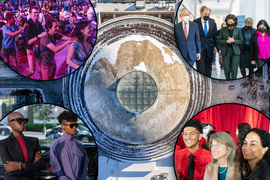
MIT community in 2022: A year in review
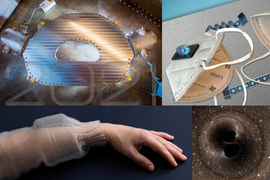
MIT’s top research stories of 2021

MIT community in 2021: A year in review
Previous item Next item
More MIT News
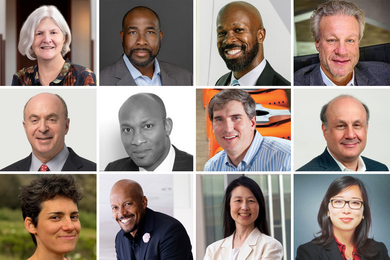
MIT Corporation elects 10 term members, two life members
Read full story →

Diane Hoskins ’79: How going off-track can lead new SA+P graduates to become integrators of ideas

Chancellor Melissa Nobles’ address to MIT’s undergraduate Class of 2024

Noubar Afeyan PhD ’87 gives new MIT graduates a special assignment

Commencement address by Noubar Afeyan PhD ’87

President Sally Kornbluth’s charge to the Class of 2024
- More news on MIT News homepage →
Massachusetts Institute of Technology 77 Massachusetts Avenue, Cambridge, MA, USA
- Map (opens in new window)
- Events (opens in new window)
- People (opens in new window)
- Careers (opens in new window)
- Accessibility
- Social Media Hub
- MIT on Facebook
- MIT on YouTube
- MIT on Instagram
Frontiers | Science News
- Science News
Research Topics
Top 10 research topics from 2022.

Find the answers to your biggest research questions from 2022. With collective views of over 3.2 million, researchers explored topics spanning from vaccine safety and psychedelic therapy to quaternary fossils and antiviral plants .
Research Topics:

1. Viral diseases
- 499,000 views
- 37 articles

2. Exploring sound
- 442,000 views
- 23 articles

3. Neurodegenerative diseases
- 387,000 views
- 19 articles

4. Psychedelic therapy
- 346,000 views
- 22 articles

5. Circadian rhythms
- 335,000 views

6. Covid-19 insights
- 320,000 views
- 84 articles

7. Vaccine safety
- 244,000 views
- 10 articles

8. Spirituality and healthcare
- 242,000 views
- 16 articles
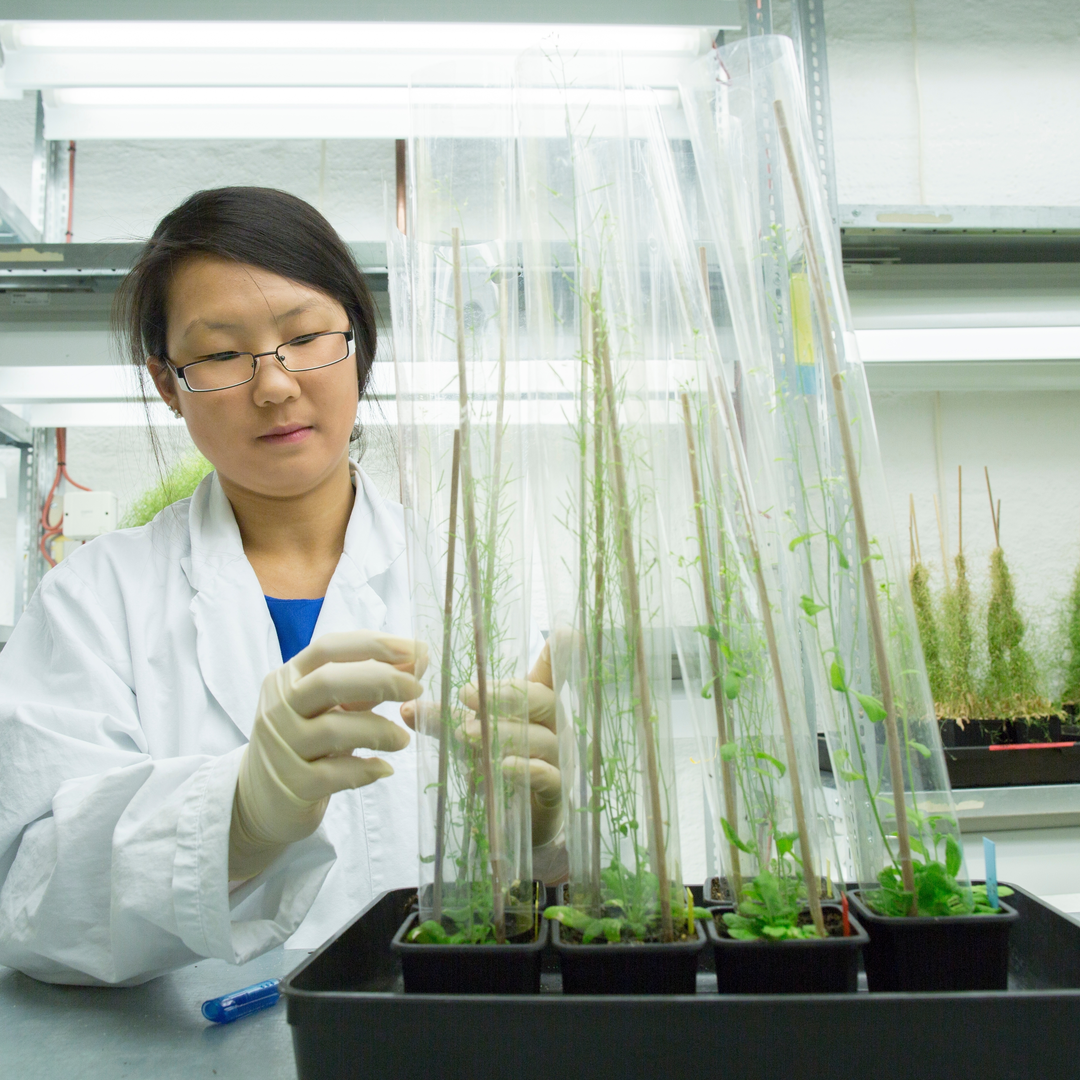
9. Antiviral plants
- 208,000 views
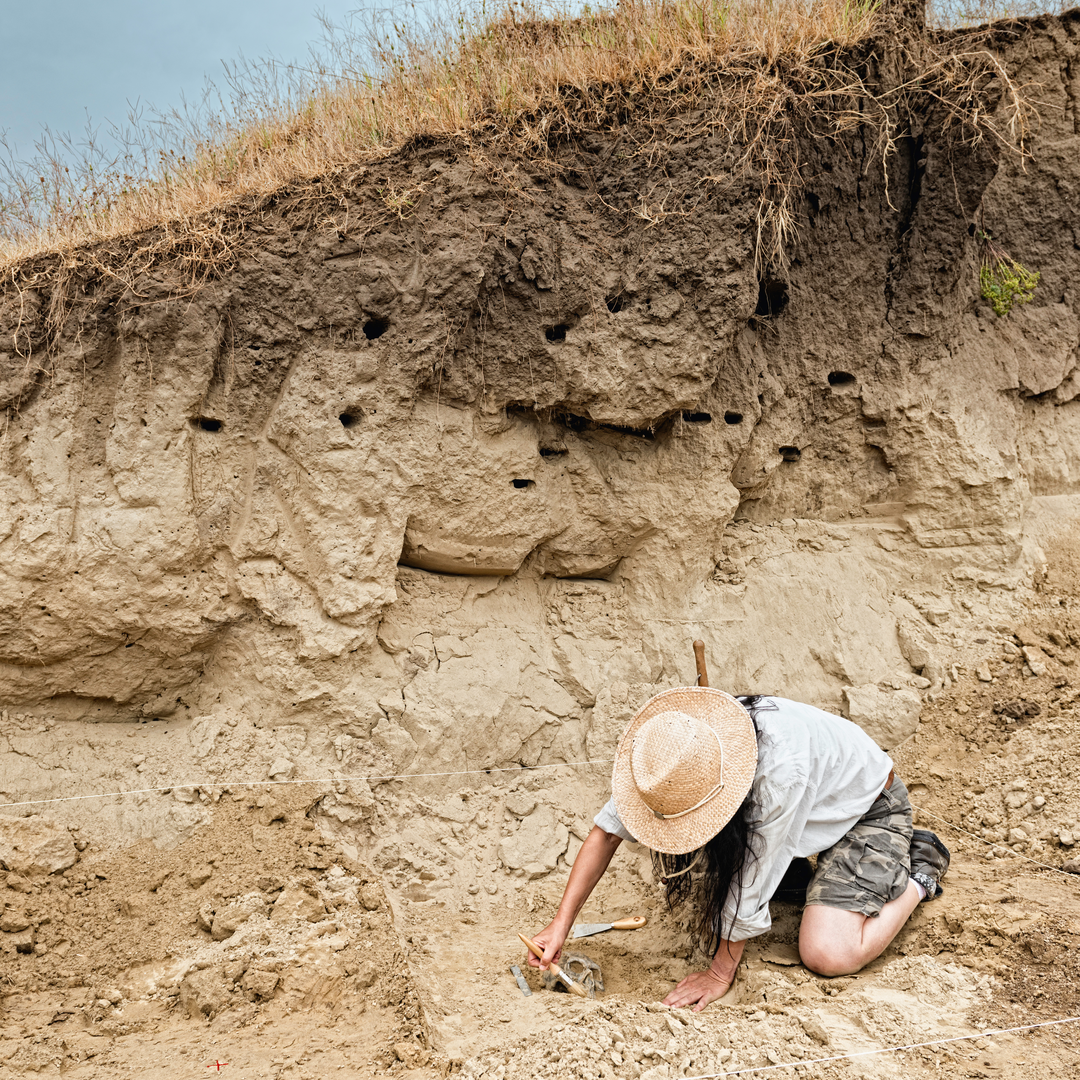
10. Quaternary fossils
- 144,000 views
Shape the future of your field
Become a guest editor for an article collection around your own research theme. Benefit from increased impact and discoverability, a dedicated platform and support team, and rigorous peer review for every paper.
Suggest your topic
Post related info
December 09, 2022

Frontiers Communications
Post categories, related subjects, research topics, related content.

Frontiers Research Topics has a new look
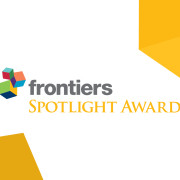
Second annual Frontiers Spotlight Award announced for 2018

What is a Frontiers Research Topic, and why should I participate in one?
Latest posts.
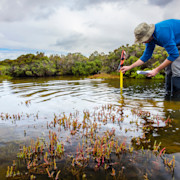
Frontiers ebook releases: May 2024

Clues to mysterious disappearance of North America’s large mammals 50,000 years ago found within ancient bone collagen

‘Extraordinary’ 4,000-year-old Egyptian skull may show signs of attempts to treat cancer

AI, open science, and the extreme weather pandemic: Takeaways from SXSW 2024
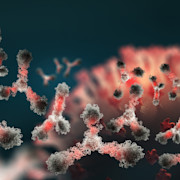
Big data, AI, and personalized medicine: scientists reveal playbook aiming to revolutionize healthcare
Technology Research Topics
Table of contents
- 1 What are Technology Research Topics?
- 2 Tips for Writing Technology Research Papers
- 3 Computer Science and Engineering Technology Research Topics
- 4 Energy and Power Technology Research Topics
- 5 Medical Devices & Diagnostics
- 6 Pharmaceutical Technology Research Topics
- 7 Food Technology Research Topic
- 8 Educational Technology Research Topic
- 9 Controversial Technology Research Topics
- 10 Transportation Technology Research Topics
- 11.1 Conclusion
Have you ever wondered what interesting technology topics for research papers mean? Then this article will provide you with the answer and topic examples that you can research and write on.
Have you ever wondered what interesting technology topics for research paper mean? Then this article will provide you with the answer and topic examples that you can research and write on.
Tech-related topics are among the vastest categories for college students, experts, and researchers. The field covers everything development majorly. The good thing about technology is that it cuts across every business sector and education field. It is important in Sciences, Socials and Fine Arts.
There have been many technology research topics about technology and development of sciences in the 21st century. This is due to the massive scope of this field. Researchers and thesis students have continued to research the foundation of every development. Triggering new findings that contribute to the overall improvement of the field. There have been many thesis papers on technologies, and there will still be more over the years. This is because the field has witnessed the highest and fastest growth among other disciplines and sciences.
This article seeks to take the research of technology and its concepts to a higher level. By considering very recent topics in line with the evolution and revolution of the field. The topics suggested in this article are divided into various categories to give readers a very good understanding of the latest technological concepts.
What are Technology Research Topics?
A technology research topic is a research or thesis title that gives a researcher or expert an idea of what to work on. While in certain instances, people who make technology research will have their topic scribbled out for them, most of the time, they will need to get a topic themselves. These topics make it easy for them to work on.
Generally, a topic based on the technological field will be very formal. It must contain researched data and facts. The topic must have a final aim of projecting a solution, answer, or knowledge to the targeted audience. With this being the case, getting a technology research title requires more than just picking any topic. What will pass on as the best topic for research title will be one that can be researched and provides a solution to a problem that the target audience needs. In certain instances, both the problem and the solution may be completely new to the target audience.
However, the ability of the writer to make their target audience know that there is a problem and a corresponding solution could do the thesis and project a pathway to ground-breaking research. Hence, a research title must open the researcher, thesis student, and expert to opportunities that could trigger landmark solutions.
Based on the importance of a research title to an entire technology thesis or research, a potential writer must ensure that they know what it takes to draft an excellent technology and scientific research paper title. The good thing is that tips are available to draft an excellent thesis topic.
Tips for Writing Technology Research Papers
There are very important steps that must be followed for a writer to make an excellent thesis topic. One major tip is that any topic selected must include at least one recent technology. A thesis topic that needs today’s basic technology as a roadmap has a higher probability of coming out much more successfully than one that does not include any current or new technology. It is also possible to buy a research paper based on technology to avoid all the processes of learning new technology concepts. Below are the top tips for writing excellent technology Research projects.
- Understand The Research Assignment This step is very important and will determine whether you need to purchase a research paper or not. You have to understand the assignment to be asked to research if you seek to give out great quality work. You need to ensure that you know the problem being projected to you and what is needed as a solution. The best research paper topics technology are those the writers fully understood and created.
- Get the Topic Idea You can only carve out a topic for an assignment that you understand. This is why the first step is imperative and why this one must follow. Understanding the topic that currently and comprehensively covers the assignment and its solution will help you develop a catching title. Even if you seek to purchase research papers for sale , you will need to fully understand the assignment and the relevant fitting topic before purchasing. You will get value for your money and wow your target audience.
- Choose a Scope to Research If you are writing your research yourself, you should know that getting a topic is not just enough. A topic may cut into very vast areas, and it would be impossible for you to research all of these areas before your submission deadline. So the best way to ensure that you give quality research assignments is by specifying the scope of your topic. Identify which questions you want to provide answers for and focus on them. That way, your effort will be concentrated with a better output.
- Get Good Links Knowing how to get great links for your work is very important as that will help you give out excellent work. Relying on established sources for important theories will help you establish a more convincing solution to the problem your research is about.
This article will consider major research topics on different technology research topics so that researchers and students planning to write a thesis or research paper can select from them and start their project immediately.
Computer Science and Engineering Technology Research Topics
Computer Science is one of the widest fields of Technology projects. As such, there are multiple writing topics to explore following the consistent and continuous development of the sector. As for Computer Science, there are many research works on computer engineering and more to explore. Thanks to the growth in better computer hardware and the more seamless management systems developed over time.
This section consists of 15 different research topics that thesis and college students can work on and get approval from their supervisors.
All the topics are recent and in line with global needs in 2023 and the next couple of years. They include:
- Blockchain technology and the banking industry
- The connection between human perception and virtual reality
- Computer-assisted education and the future
- High-dimensional data modeling and computer science
- Parallel computing Languages
- Imperative and declarative language in computer science
- The machine architecture and the efficiency of code
- The use of mesh generation for computational domains
- Persistent data structure optimization
- System programming language development
- Cyber-physical system vs sensor network
- Network economics and game theory
- Computational thinking and science
- Types of software security
- Programming language and floating-point

Energy and Power Technology Research Topics
Unlike many technology-related topics, Energy and Power is one that cuts into the spheres of politics, economics, and pure science. In the areas of Economics, Energy and Power are the second most arbitrated cases. It’s only behind Construction disputes.
However, energy and Power in Science and Practicality are not for the sake of disputes. In recent years, there has been more harmony between energy and other tech-related disciplines. This has triggered many research projects, and writing research assignments is not out of the equation.
So do you have an energy/Power research assignment to handle, then this section provides you with amazing topic ideas and scopes that you can choose and pick from? All the topics are very recent and in line with the needs of today’s assignments.
Get topics that focus on Cars, power industries, chemicals, and more.
- The use of fuel cells for stationary power generation
- Energy density
- Lithium-air and lithium-ion battery
- The better between gasoline and lithium-air batteries
- Renewable energy technologies
- The pros and cons of renewable energy usage
- Algae and biofuels
- Solar installations of India
- The use of robots in adjusting solar panels to weather
- Create energy and inertial confinement fusion
- Hydrogen energy and the future
- Alternative energy sources amidst gas price increase
- The application of energy transformation methods in respect to hydrogen energy
- AC systems and thermal storage
- Loading balance using smart grid
Medical Devices & Diagnostics
Medical devices and diagnostics are fast-growing fields with many opportunities for researchers to explore. There are thousands of devices that aid doctors in treating and managing patients. However, it cannot be emphatically stated that all of these devices offer the best results, where research assignments come into play.
As medical devices, medical diagnoses are also A very concentrated research area. Diagnostic research is highly related to medical devices because diagnoses are carried out with modern gadgets being produced by experts.
This section will consider top medical devices and diagnoses research titles in line with recent needs.
- Difference between Medical Devices and Drugs
- How Diagnostics helps treatment in 2023
- The Era of genetics Diagnostics and Discovery of Hidden Vulnerabilities
- How are Medical Smart Carts changing the game of Medicine?
- The Eventuality of AI in Smart Medical Devices
- The Regulation of Medical Devices
- Should Private Diagnoses Be Used for Making Critical Medical Decisions?
- Diagnostic Devices, Genetic Tests, and In Vitro Devices
- 3D & 4D Printing in Biomedicine
- Innovation in Minimally Invasive Therapies, Screening and Biosensing: Complex Networks, Data-driven Models
- Are medical Devices turning the Health Sector into a small interconnected powerhouse?
- Advances in Methods of Diagnostic & Therapeutic Devices
- What are Intra-Body Communication & Sensing?
- Smart Gadgets Data Collection in terms of Neuroscience
- The Contribution of Smartphone-Enabled Point-of-Care Diagnostic & Communication Systems

Pharmaceutical Technology Research Topics
Medicine has continued to improve, with technology in this area spiking in the last 20 years than it did centuries before. Pharmaceutical technology is one of the major flag bearers of this growth. As the COVID-19 pandemic revealed, the potential of pharmaceutical technology knows no bounds as long as there is continuous research in the field.
With that being the case, there are multiple research titles and projects available to take on in this field, with the opportunity almost endless. This section lists some of these topics to help research students get great topics that they can work on for the best effect. While they are only 15, they all cover a large scope of inexhaustible topics, leaving the researcher to make their choice.
- The technologies of pharmaceuticals and their specialty medications
- The technology and trend of prior electronic authorization in pharmacy
- Medication therapy management and its effectiveness
- Electronic prescription of a controlled substance as regards the issues of drug abuse
- Health information exchange and medication therapy management
- How efficient and effective is a drug prescription monitoring program?
- The script standard of NCPDP for specialty pharmacies
- The patient’s interest in real-time pharmacy
- AIDS: development of drugs and vaccines
- Pharmaceutical technologies and data security
- The DNA library technology: an overview
- The impact of cloud ERP in the pharmaceutical industry
- Cannabidiol medication in pain management and the future
- Pharmaceutical research with phenotypic screening
- The benefits of cloud technology for small pharmaceutical companies
Food Technology Research Topic
Food research assignments and thesis have been going on for decades and even centuries due to their importance to living organisms. In 2023, this trend is expected to continue with more research topics to explore. Here are some amazing topic ideas that you can choose from and offer a mind-blowing research assignment.
- The types of machines used in the food industry
- 3D printing and the food industry
- Micro packaging and the future
- The impacts of robots as regards safety in butchery
- Swallowing disorder: 3D printed food as a solution
- Food technology and food waste: what are the solutions
- Biofilms and cold plasma
- Drones and precision agriculture
- Food industry and the time-temperature indicators
- Preservatives, additives, and the human gut microbiome
- Hydroponic and conventional farming
- The elimination of byproducts in edible oil production
- The baking industry and the newest technology
- Electronic nose in agriculture and food industry
- Food safety
Educational Technology Research Topic
As far as college students are concerned, technology in education and its subsequent research is the biggest assignment and thesis they have to consider. Education technology has continued to grow, with many gadgets and smart equipment introduced to facilitate better learning.
This section will consider some of the major education research titles that technology students can pick and provide excellent research.
- How is computational thinking improving critical thinking among students
- The effect of professional learning for college student
- The impact of technology in educational research
- The relevance of technology in advancing scientific research
- Virtual reality and its role in helping student understand complex concepts
- Global learning through technology and how it affects education standards
- Data centers and their role in education
- Cultural competence and socio-emotional learning
- Artificial intelligence and educational system
- Is the development of sufficient national capacities related to science, technology, and innovation possible?
- How inclusive is the architecture of learning systems?
- Student-centered learning
- The impact of connectivity for schools and learning, especially in rural environments
- Energy sources: their technological relativity and use in education
- Community college: advantages and disadvantages
Controversial Technology Research Topics
As the name suggests, Controversial technology topics are among the most researched in science. How good is technology considering its effects on the global world and nature? This argument is the foundation of Controversial technology topics. See 15 different technology topics to choose from as you start your research assignment.
- Can Human Trials Improve Drugs and Medicines Faster?
- The Legality of Euthanasia and Assisted Killings in Medicine
- Why Kids should not be exposed to the Internet and Social Media Gadgets in Their Earlier Years
- How Is Technology Destroying the World’s Ecology?
- Is Technology Leading the Destruction of the World’s Climate?
- How Has Technology Increased Radiation and the Depletion of the World?
- Does Technology Increase Gang Initiation due to Internet Access?
- How Social Media Increases the Rate of Children and Young Adults Death?
- The Relationship Between Technology and Depression
- Clustered Regularly Interspaced Short Palindromic Repeats (CRISPR): Editing the Human Genome
- The Possible Devastation of World from High-Tech Military Weapons
- Space Colonization: How it is Good and Bad for Mother Earth
- Are Law Enforcement use of Hidden Cameras an Encroachment of Privacy?
- How Virtual Reality Can Become the New Reality If Developed?
- The Wins of Cochlear Implant Research
Transportation Technology Research Topics
Transportation technology research titles are among the hottest categories for students currently. See 15 best research topics for tech and science-related research to pick from.
- Are Computerized self-driving Cars Safe?
- The development and Advantages of hybrid cars and Electric cars
- How to Protect your smart car from hijackers and Car Thieves?
- Will the next-generation Cars Have Reliable GPS devices and Replace Drivers?
- The Evolution of High-speed rail networks and How They Change Rail Transport
- Driving and Using Cell phones: The Global Stats of Cell Phone Related Auto Accidents
- Is Teleportation an Impossible Physics?
- Will Gyroscopes be the new convenient solutions for public transportation?
- Will Logistics Companies be More Efficient With Electric Trucks?
- How Carbon fiber Serves as an optional material for unit load devices
- The Benefits of Advanced Transport Management Systems (TMS)?
- Can Solar Roadways Become More Cost-Effective?
- Does Technology Provide the Possibility of Water Powered Cars?
- How AI has Penetrated the Transport System and Make It More Effective
- Speed and Safety: How Technology Has Revolutionized Transport Systems
Information Communication Technologies (ITC) Research Topics
ICT is arguably the biggest field of technology, thanks to the amazing developments that have been achieved over the years in the field. ICT plays a major role in different areas of human life. This includes the area of TELECOMs, Education, Family, and Industries.
This section will consider 15 major technology titles on ICT to help students get topics to work on.
- How is technology improving Humans reading ability?
- Do online formats of readable information encourage readers to skim through instead of Understanding the Topics?
- How has technology made it extremely easy to get information in Seconds: a good or bad development?
- The Misconception of Gauging Intelligence?
- How are Internet Search Engines changing us?
- The introduction of ICT and new technologies in Education and How they improve Students’ learning
- Is it worrisome that schools and Colleges now educate students via iPads, social media, Smart Boards, and other new Applications?
- Did the Digital Age trigger any loss of information and Unique Intelligence that conventional and Traditional Learning and research methods provided in the Old era?
- Do Search Engines and Web2 Platforms censor information, leave users blindsided, and Keep them in the Dark?
- Should Encyclopedia sites such as Wikipedia be Regulated because of the High Risk of it Providing Wrong Information to the Public?
- Are Blogs and Online Websites Better than Books?
- The Importance of Traditional Researching and learning in a Highly Digital World
- Do PDFs and Other Electronic Books Promote Short Attention Span?
- Are Tech-Savvy generations dumber or Smarter?
- Should Schools Become Fully Digitalized?
This article shows that technology research papers require a good understanding of technological and scientific concepts. That way, people can easily understand the basis of an assignment. They know how to draft the topic and scope. They also get excellent resources for completing the projects.
This article explained what technological research papers are. It explained how to write them and listed many topic examples people can use for their projects. Therefore, if you follow all the information discussed in this article, you will get top technology ideas for research.
Readers also enjoyed
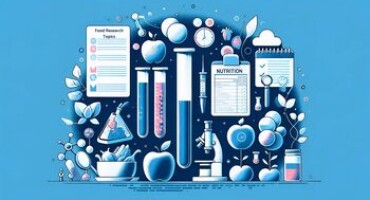
WHY WAIT? PLACE AN ORDER RIGHT NOW!
Just fill out the form, press the button, and have no worries!
We use cookies to give you the best experience possible. By continuing we’ll assume you board with our cookie policy.

- May 31, 2024 | Revolutionary Weight Loss: Largest Ever Obesity Study Showcases Semaglutide’s Promise
- May 31, 2024 | Witnessing Cosmic Dawn: Webb Captures Birth of Universe’s Earliest Galaxies for First Time
- May 31, 2024 | Ancient Roots, Modern Insights: New Study Reveals Age-Old Secrets of Camas Cultivation
- May 31, 2024 | Venus Erupts: Fresh Volcanic Activity Revealed in NASA’s Magellan Data
- May 31, 2024 | Rewriting the Rules of Power: Korean Researchers Develop Revolutionary New Lightweight Structure for Lithium Batteries
Technology News
Read the latest technology news on SciTechDaily, your comprehensive source for the latest breakthroughs, trends, and innovations shaping the world of technology. We bring you up-to-date insights on a wide array of topics, from cutting-edge advancements in artificial intelligence and robotics to the latest in green technologies, telecommunications, and more.
Our expertly curated content showcases the pioneering minds, revolutionary ideas, and transformative solutions that are driving the future of technology and its impact on our daily lives. Stay informed about the rapid evolution of the tech landscape, and join us as we explore the endless possibilities of the digital age.
Discover recent technology news articles on topics such as Nanotechnology , Artificial Intelligence , Biotechnology , Graphene , Green Tech , Battery Tech , Computer Tech , Engineering , and Fuel-cell Tech featuring research out of MIT , Cal Tech , Yale , Georgia Tech , Karlsruhe Tech , Vienna Tech , and Michigan Technological University . Discover the future of technology with SciTechDaily.

Technology May 31, 2024
Rewriting the Rules of Power: Korean Researchers Develop Revolutionary New Lightweight Structure for Lithium Batteries
A new three-dimensional polymeric structure developed by POSTECH and KIER researchers significantly enhances lithium ion transport and battery performance, showing great promise for future commercialization….
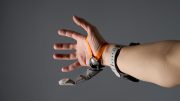
Cambridge Scientists Develop “Third Thumb” That Could Redefine Human Capability
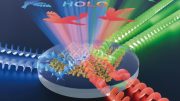
“Metaholograms” – Scientists Have Developed a New, Better Type of Hologram
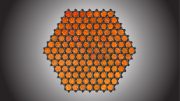
Unlocking Graphene’s Potential: Oxygen-Free Methods Revolutionize Production
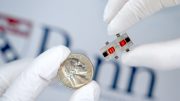
The Key to 6G: Penn Engineers Unlock the Next Generation of Wireless Communications

New Quantum Dot Technology Improves Solar Cell Efficiency
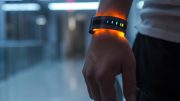
Sweat Smart: New Biomarker Tech Revolutionizes Health Monitoring

New Reactor System Converts Carbon Dioxide Into Usable Fuel

High Efficiency, Low Cost: New “All in One” Microcomb Lasers Could Transform Consumer Electronics

Technology May 27, 2024
NASA Unveils Game-Changing Infrared Cameras for Earth and Space Exploration
Innovative infrared sensors developed by NASA increase resolution for Earth and space imaging, promising advancements in environmental monitoring and planetary science. A newly developed infrared…

Technology May 25, 2024
Energy From the Sky: How Drones Can Generate Electricity
Dr. Duc H. Nguyen has received funding to research Airborne Wind Energy Systems, aiming to improve their safety and efficiency for potential commercialization and a…
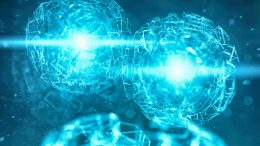
Revolutionary Qubit Technology Paves Way for Practical Quantum Computer
Advancements in qubit technology at the University of Basel show promise for scalable quantum computing, using electron and hole spins to achieve precise qubit control…

Synthetic Bones Designed by AI Set to Transform Orthopedic Surgery
Researchers have developed a bone-like synthetic material using machine learning and 3D printing, aimed at enhancing orthopedic treatments. This new material could potentially replace traditional…

Technology May 24, 2024
When Science Fiction Becomes Science Fact: The AI Dilemma
AI experts recommend significant investment in AI risk mitigation and stricter global regulations to prevent misuse and guide AI development safely. Researchers have warned about…
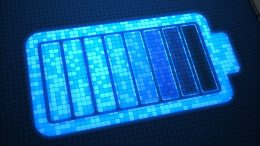
The Sodium Solution: Reducing Costs and Complexity in Batteries
Simulations of microstructures demonstrate a significant impact of elastic deformation on the charging characteristics of layered oxides employed as cathodes in sodium-ion batteries. Research is…
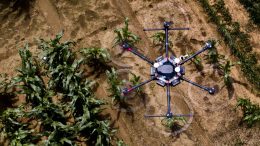
AI in the Fields: Revolutionizing Agriculture With Smart Technology
AI and robotics are transforming agriculture, making it more sustainable and efficient through targeted interventions in crop management. Researchers from the University of Bonn are…

“Electronic Spider Silk” Sensors: Revolutionizing Bioelectronics With Eco-Friendly Technology
Cambridge researchers have developed lightweight, eco-friendly sensors, inspired by spider silk, that seamlessly integrate with biological surfaces for diverse applications in health monitoring and virtual…

Technology May 23, 2024
New Study Reveals Shocking Gaps in AI Empathy
Conversational agents (CAs) like Amazon’s Alexa and Apple’s Siri are designed to answer questions, offer suggestions, and even display empathy. However, new research indicates that…
Take control of your money! Save, budget and navigate your finances easier with AARP Money Map.
- AARP Research
- Issues & Topics
- Work & Finances
- Health & Health Care
- Life & Leisure
- Long-Term Care
- Livable Communities
- Politics & Government
- State Resources
Older Adults Embrace Tech for Entertainment and Day-to-Day Living
2022 tech trends and the 50-plus.
by Brittne Kakulla, PhD, AARP Research , December 2021

Read the Detailed Findings
- 2022 Tech Trends and the 50-Plus (Report, PDF)
- Annotated Questionnaire (PDF)
- Methodology (PDF)
FACT SHEETS
- The Digital Home Has Arrived (PDF)
- A Look at 50+ Men and Women's Use of Technology (PDF)
- Tech Dependency Continues in 2021: Tech Ownership and Use (PDF)
- Technology and African Americans 50+ (PDF)
- Hispanic and Latino Adults 50+ Embrace Technology (PDF)
- Tech and Asian Americans 50+ (PDF)
- Age Is Just a Number When It Comes to Technology (PDF)
- Online Privacy Remains a Key Concern Among the 50-Plus (PDF)
- Improving Digital Literacy is a Shared Responsibility (PDF)
- Are the 50+ Ready for Tech of the Future? (PDF)
- Digital Entertainment Is a Mainstay (PDF)
- Tech Trends Among Urban, Rural and Suburban Adults 50+ (PDF)
- Tech Usage Among Women of All Ages (PDF)
- 2021 Tech Trends and the 50+
- 2020 Tech Trends and the 50+
- Is Your Brand Missing Out on the 50+ Market? (Data Story)
- More Reports from AARP Research
If a pandemic-driven acceleration of technology adoption among older adults characterized 2020, then 2021 in some sense can be seen as a year when tech introduction became tech habit.
Despite the year bringing a return to some level of normalcy for many people — with in-person socializing increasing, holiday gatherings resuming, and restaurants welcoming returning customers — older adults’ use of technology to help them stay connected with others remained a cornerstone of social interaction in 2021, AARP’s latest Tech Trends and the 50-Plus study found. Three in four people age 50-plus say they rely on technology to stay connected, with those in their 50s (76%), 60s (79%), and 70s (72%) all exceeding 70%.
Using Tech for Entertainment and Day-to-Day Living Ticks Up
In keeping with those trends, the survey results revealed year-over-year continued engagement in most forms of digital communication. Text remained steady at 92% in 2020 and 92% in 2021, video chat stayed fairly even from 70% in 2020 to 67% in 2021, and social media dropped slightly from 78% to 74%. An older communication option, email, remained more or less unchanged, from 90% to 89%.
Overall, older adults continue to reach for their devices. The significant rise in the use of smartphones and tablets recorded in 2020 for such activities as making online purchases, ordering groceries, banking, and engaging health services continued in 2021, as did the increased use of a multitude of apps.
In addition to wanting to stay connected — which was the top motivator for all older adults 50 to 70-plus — they have turned to technology to be entertained and manage day-to-day living, among other motivators. For the 50-plus overall, 66% use technology to connect with others, 59% use it for entertainment, and 47% find it helpful to manage responsibilities. Many also use technology to stay healthy (43%), to learn a new skill (38%), or to pursue a passion (36%). Unsurprisingly, embracing technology to maintain personal independence rises with age: 22% those 50–59, 29% for those 60-69, and 35% for people 70-plus.
As with any age group responding to the menu of ever-changing tech, adults 50-plus continue to adopt technology with an appetite to learn. Leading interests among the 50-plus include learning how to manage smart-home technology (23%), stream entertainment from sites like Hulu or Netflix (22%), and video chat with friends and family (22%).
Along with the burgeoning use of — and familiarity with — technology among older adults, they see shortcomings, specifically with regard to inclusivity. Two in five adults 50-plus don’t feel technology is designed with older adults in mind, citing the offerings’ complexity, poor user experience, and insufficient training materials. And the older a person is, the more inclined they are to feel that technology is not designed for them. Nearly one in four (39%) of those 50–59 don't feel technology is designed with people of all ages in mind, compared to 40% of those 60–69 and 45% of those 70-plus.
As for other challenges, older adults and those living in rural areas continue to have limited access to high-speed internet. And even among adults with internet access, more than half (56%) say cost is a problem.
Ready for More
Still, interest in technology among older adults continues to expand, and perhaps in new ways. Many, for instance, are not just playing catch-up on current technology but awaiting new advances, with 64% of 50-plus adults interested in at least one type of upcoming advancement. In addition, older adults continue to spend on technology. Most (70%), in fact, made a tech purchase in the past year. That's on par with the 72% purchase rate for 2020, when the pandemic-fueled acceleration kicked in, continuing to leave 2019's prepandemic benchmark of 51% far behind.
Meanwhile people’s spending on technology remains significantly higher than prepandemic levels, at $821 compared to $394 in 2019. By 2030, the 50-plus market is projected to swell to 132 million people who are expected to spend on average $108 billion annually on tech products.
To see how data from this study can help brands reframe aging, check out our data story, Is Your Brand Missing Out on the 50+ Market?
Methodology
The online survey of 3,025 adults age 18 and older (n= 2,063 50-plus) was conducted September 14–October 14, 2021 in English and Spanish using Foresight 50+ by AARP & NORC . The survey took about 19 minutes to complete and was weighted according to demographics for U.S. adults age 18–plus, 50-plus, and by generation.
For more information, please contact Brittne Kakulla at [email protected] . For media inquiries, please contact External Relations at [email protected] .
Suggested citation:
Kakulla, Brittne. 2022 Tech Trends and Adults 50-Plus. Washington, DC: AARP Research, December 2021. https://doi.org/10.26419/res.00493.001
Search AARP Research
Enter a keyword below to find answers to your AARP Research questions.
NEWS ALERTS: Sign up for a monthly newsletter of the latest AARP Research.

2021 Top Tech Trends of Older Adults
Tech spending in 2020 among adults 50+ is up 194% (from $394 to $1144) to modernize, update, or create a better experience online.

Social Media
AARP Research Facebook
Twitter: @AARPresearch
AARP Research Instagram
You are leaving AARP.org and going to the website of our trusted provider. The provider’s terms, conditions and policies apply. Please return to AARP.org to learn more about other benefits.
Your email address is now confirmed.
You'll start receiving the latest news, benefits, events, and programs related to AARP's mission to empower people to choose how they live as they age.
You can also manage your communication preferences by updating your account at anytime. You will be asked to register or log in.
In the next 24 hours, you will receive an email to confirm your subscription to receive emails related to AARP volunteering. Once you confirm that subscription, you will regularly receive communications related to AARP volunteering. In the meantime, please feel free to search for ways to make a difference in your community at www.aarp.org/volunteer
Javascript must be enabled to use this site. Please enable Javascript in your browser and try again.
- Become a Member
- Artificial Intelligence
- Computational Thinking
- Digital Citizenship
- Edtech Selection
- Global Collaborations
- STEAM in Education
- Teacher Preparation
- ISTE Certification
- School Partners
- Career Development
- ISTELive 24
- Solutions Summit
- Leadership Exchange
- 2024 ASCD Leadership Summit
- 2025 ASCD Annual Conference
- Edtech Product Database
- Solutions Network
- Sponsorship & Advertising
- Sponsorship & Advertising
- Learning Library
The Hottest Topics in Edtech for 2022!
- Education Leadership

For a few years now, we’ve shared on this blog the hottest edtech trends of the year based on the topics resonating with educators who submit proposals to present at the annual ISTE conference . The topics that presenters submit can tell us a lot about what educators are interested in — and experimenting with — in their schools and classrooms.
Often the topics don’t change much from year to year, but that hasn’t been the case the past two years.
Last year, after many months of remote learning under their belts, educators were eager to share their best practices about online learning, as well as how to build equity and boost social emotional learning, which were three of the hottest topics going into 2021.
While those topics made the list again this year, there were some surprises at the top of the list. Here are the eight hottest topics for 2022, starting with No 8.
8. Augmented, mixed and virtual reality
The ISTE community has been excited about this topic for years now, but it’s been elevated recently as tools for immersive learning become more affordable, accessible and easier for both teachers and students to use.
“Education has just started to tap into what it can bring,” says Camilla Gagliolo, a longtime educator and ISTE’s senior director of event content. “Personally, I’m really excited about the growth in AR/VR and in immersive learning.”
Augmented reality involves superimposing a computer-generated image on your view of the real world. Think Pokemon Go.
Virtual reality is a 3D, computer-generated environment that you can immerse yourself in. Using an Oculus or a similar headset, you can transport yourself to a another place or time and interact within it, whether it’s visiting the Great Pyramid of Giza or exploring the functions of the human body.
Some of the newer trends involve being able to interact with historical events that have been recreated in a virtual environment. So, you can show up at an event and actually be part of it — well, sort of.
The pandemic has caused a lot of educators to focus on how to better engage students in content online, and AR/VR is a sure-fire way to do that.
In addition to having students experience learning through AR/VR, many educators are helping students create their own experiences.
Look for sessions on how to do this and much more with AR/VR in your classroom when the ISTELive 22 program goes live in February.
7. Social-emotional learning
As soon as COVID-19 closed school buildings in 2020, it was immediately clear that educators would need to do far more than teach their students. Every single student was struggling with something in addition to trying to adapt to a new way of learning, and educators were on the front lines of helping students feel safe, secure, emotionally stable and ready to learn.
But many of their needs — like food, internet and medical care — were shared by the whole family, so educators realized they couldn’t help students in isolation. They had to work with families as a whole.
In a way, roles were reversed — or at least blurred: Educators helped families meet their basic needs by assisting them with finding resources like meals, child care and other services, while parents took over a lot of the teaching tasks.
What evolved was a whole-village approach to education, where, for the first time on a grand scale, teachers and schools were working in concert with students and families.
“When the parent community took over the teaching, the teachers had to help the parents help the children,” Gagliolo said. “There is a new role for parents, and I think this is going to change how we work with parents going forward.”
Many individual educators and school systems as a whole developed innovative ways of working with parents and are eager to share what they’ve learned at ISTELive 22 .
6. Equity and inclusion
Never has equity and inclusion seemed more urgent than in the past two years. The pandemic brought inequities — whether they were due to socio-economic status, special needs or the family circumstances of the student — into sharp focus.
The most immediate need was devices and bandwidth. Schools, government, the business sector and local communities combined forces to deliver devices and connectivity to nearly every household in the country, but that's not enough.
“ It took a pandemic to give every kid a device,” Gagliolo says. “Now the challenge is to get meaningful learning with these devices.”
Educators have been doing just that — experimenting with ways to make learning more engaging, student-centered and inclusive with technology tools.
“Even Zoom has become a tool of access,” Gagliolo says. “The pandemic actually brought to the forefront what tech can do to bridge equity and meet the need for tools, platforms and access.”
Although the learning curve was high, many educators discovered strategies and ideas for making learning more accessible to a range of learners using various tools. And they are eager to share what worked at ISTELive 22.
5. Online tools and apps
This topic has been a favorite of presenters and ISTE conference participants for years because it appeals to the tech geek in all of us. But this time around, there’s an emphasis on highlighting tools that — just like students and educators themselves — have made a big leap in what they are capable of because of the pandemic.
“There’s been so much improvement in tools and apps,” Gagliolo said. “They were forced to be much more stable. They can handle more interaction and have developed features for connecting students with teachers.”
A lot of what the newest versions of tools are offering allow students to learn — and share their learning — in a variety of ways, whether it’s being able to quickly upload a video, make a comment via a sound recording, or create and quickly upload an artifact.
Free creation tools like Adobe Spark as well as myriad video-creation tools have taken a big leap in terms of ease of use and accessibility.
4. Distance, online, blended learning
This was hands-down the hottest topic of 2021 as educators around the globe were still learning how to best transition their teaching to online formats. The biggest hurdle at first was how to use the tools. The learning curve was high as educators had to figure out everything from creating breakout groups in Zoom and Teams to establishing rules about cameras and appropriate backgrounds.
This year the topic is less about how to use the technology and more about how to best engage students.
And the stakes are high. Disengaged students can simply turn off their cameras when they are bored. But with the threat of learning loss looming, no educator wants any student to miss out on access to learning. So they’ve been coming up with lots of ways to stimulate collaboration and build community — online and in person.
“There are a lot of new strategies and new tools developed over the past two years that engage students at a high level,” Gagliolo says.
Although it’s not exactly new, she points to FlipGrid, as a tool that’s being used in diverse ways. It allows students to record comments, facilitates a connection between home and school, and lets students demonstrate their storytelling chops.
And speaking of tools, learning management systems, once the bane of educators’ existence, have enjoyed a resurgence. Educators in general have become more comfortable with these tools and are seeing the potential for communicating with students and parents in a much more streamlined way.
3. Computer science and computational thinking
Computer science and computational thinking have long been a favorite topic of teachers who love technology and see it as a gateway for their students to enter STEM careers. So it’s no surprise that it made it to the No. 3 spot on the list.
What is more surprising is the evolution of computer science (CS) and computational thinking (CT) as something strictly reserved for math and science class to a discipline that has infiltrated all subjects, from literature and art to music and dance.
“You think of CS and CT as being for math and science, but we’re seeing educators incorporating it into language learning and storytelling quite a bit,” Gagliolo says. “It’s taking different shapes and forms and not just in the traditional areas.”
Tools like Scratch, Snap, Tynker and KODU allow students to use programming to create stories. They develop their characters, or sprites, and build out their environments. “They can create their world and their scenario,” Gagliolo says.
2. Instructional design and delivery
Of all the topics on the list, this one is perhaps the most exciting because it illustrates a sophistication in how educators are thinking about educational technology, Gagliolo says. The focus is on educational strategies and instruction with technology for higher-order thinking — not tools and gadgets.
“The pedagogy and learning strategies are rising to the top more than the technology topics,” Gagliolo said. “It shows that awareness that learning comes first and tech tools are there to support.”
Instructional design and delivery covers an array of topics from designing content in online formats that is accessible to all learners to ensuring that the content is culturally relevant. It covers ways to encourage community and interaction among students and teachers as well as an awareness of research on how students learn and how online delivery differs from face to face.
This information is not just from educators who have the instructional designer title. Remote learning made educators of all subject areas and grade bands realize that they, too, were assuming the role of instructional designers.
1. Project-based learning
Also known as problem- and challenge-based learning, PBL is a model where students learn by actively engaging in real-world and personally meaningful projects.
While this model isn’t new to ISTE presenters, what’s astonishing is that it landed on the top, Gagliano said. What it shows is that as educators become more comfortable with various tools, they are focusing more on pedagogy and how to guide students to use tools to practice their personal passions and achieve their goals.
“It’s a level of maturity that ISTE has advocated for for a long time,” she said. "It’s more about the learning strategy than the tool.”
Many of the conference proposals related to PBL are for poster sessions, which means these are from educators eager to show a project their students have taken on. What that shows is that PBL has moved from the theoretical to the practical. These are projects that have been tested in classrooms around the world.
Many of them, Gagliolo says, are related to design thinking. Students are coming up with problems and solutions, prototyping and iterating.
Diana Fingal is ISTE's director of editorial content.
- artificial intelligence
- Architecture and Design
- Asian and Pacific Studies
- Business and Economics
- Classical and Ancient Near Eastern Studies
- Computer Sciences
- Cultural Studies
- Engineering
- General Interest
- Geosciences
- Industrial Chemistry
- Islamic and Middle Eastern Studies
- Jewish Studies
- Library and Information Science, Book Studies
- Life Sciences
- Linguistics and Semiotics
- Literary Studies
- Materials Sciences
- Mathematics
- Social Sciences
- Sports and Recreation
- Theology and Religion
- Publish your article
- The role of authors
- Promoting your article
- Abstracting & indexing
- Publishing Ethics
- Why publish with De Gruyter
- How to publish with De Gruyter
- Our book series
- Our subject areas
- Your digital product at De Gruyter
- Contribute to our reference works
- Product information
- Tools & resources
- Product Information
- Promotional Materials
- Orders and Inquiries
- FAQ for Library Suppliers and Book Sellers
- Repository Policy
- Free access policy
- Open Access agreements
- Database portals
- For Authors
- Customer service
- People + Culture
- Journal Management
- How to join us
- Working at De Gruyter
- Mission & Vision
- De Gruyter Foundation
- De Gruyter Ebound
- Our Responsibility
- Partner publishers

Your purchase has been completed. Your documents are now available to view.
IUPAC Top Ten Emerging Technologies in Chemistry 2022
Discover the innovations that will transform energy, health, and materials science, to tackle the most urgent societal challenges and catalyse sustainable development..
- Fernando Gomollón-Bel
In 2019, IUPAC launched the “Top Ten Emerging Technologies in Chemistry Initiative.” [ 1 ] This project, nowadays consolidated and recognised by experts worldwide, highlights the value of chemical sciences in the transition to a green economy and a more sustainable world, in line with the United Nations’ Sustainable Development Goals (SDGs) [ 2 ]. Moreover, in 2022 we join the celebration of the International Year of Basic Sciences for Sustainable Development (IYBSSD), a United Nations (UN) resolution to reaffirm and emphasise the importance of basic sciences, chemistry among them, to attain the ambitious SDGs by 2030.
According to the UN, basic sciences will help us attain sustainable development and improve quality of life. In fact, this very UN document stresses the importance of emerging technologies, since they “respond to the needs of humankind […] increasing the health and well-being of individuals, communities and societies” [ 3 ]. Last year, the world faced the consequences of the climate crisis in an unprecedented way—deadly heatwaves devastated India and Pakistan in spring, and Europe faced similar challenges during the hottest summer on record. Moreover, we’re still enduring the COVID-19 pandemic and new contagious variants, as well as the consequences of war in Ukraine—among them oil prices skyrocketing. Therefore, this year’s technologies delve into innovative medical solutions and efficient energy sources. The panel of experts convened by IUPAC has examined a pool of recommendations from chemists around the world and selected the most promising proposals. As usual, these emerging technologies hover between experimental endeavours and commercial realities, but all hold great promise to transform our world.
Sodium-ion batteries
An abundant, affordable alternative to lithium
We need better and more affordable batteries. Without inexpensive energy storage, renewable sources of energy, such as solar and wind, will never become mainstream. That’s why, already in previous editions of this selection, IUPAC had identified battery technologies beyond the ubiquitous, Nobel-winning lithium-ion batteries, which, interestingly, were first conceptualised during another oil crisis. This year, IUPAC experts wanted to highlight the potential of another alkaline metal—sodium. It presents several advantages. First, it is a more abundant element, and therefore reduces our reliance on depleted lithium reserves. Additionally, sodium-ion batteries do not rely on cobalt, commonly considered a conflict mineral because of the high-risk mining practices in Congo [ 4 ]. Instead, their cathodes contain iron and manganese, both bountiful first-row metals.
Although sodium-ion solutions still suffer when compared to lithium in terms of shelf life and energy density, they offer interesting opportunities in terms of sustainability and circular economy, since their materials and components are easily disassembled, reconditioned, and recycled [ 5 ]. Moreover, economic analyses have envisioned the advantages of sodium-batteries, especially in scenarios of scarcity of cobalt and lithium minerals. Most of these arise from adopting aluminium, not sodium itself. Aluminium replaces copper in the anode, offering a cheaper, lighter, and more resistant alternative. Aluminium also avoids the problems derived from excessive discharge, associated with oxidation and eventually thermal runaway and flammability in lithium-ion batteries. Overall, sodium-ion batteries seem safer, thus reducing the costs and dangers of transportation and storage [ 6 ]. An interesting approach towards the design of more efficient sodium-ion batteries comes from computational chemistry. The development of cost-effective quantum chemistry models, machine learning, and the surge of supercomputers have pushed materials discovery forward. In the field of batteries, these computational methods have helped design new mixtures for electrodes and electrolytes, as well as contributed to a better understanding of the materials’ behaviour and the prediction of properties. Researchers expect these techniques will accelerate applications [ 7 ].

Sodium-ion batteries are already attracting industrial interest. In fact, the world’s biggest manufacturers of lithium-ion batteries, Chinese company CATL, recently unveiled their first-generation commercial battery based on sodium, and aims at hybrid sodium-lithium solutions to revolutionise the electric vehicle sector. Other companies, such as HiNa Battery and Faration, have attracted investments and developed working prototypes and products, while Natron Energy and Altris, based in the US, will launch massive manufacturing plants in 2023. Definitely, sodium-ion is another alternative towards efficient energy storage, another tool in the chemists’ kit to tackle the climate crisis.
Combining the power of natural and artificial catalysis
Nanotechnology was key to the development of COVID-19 vaccines. The possibilities of the nano-world for healthcare and biomedicine have become evident, and many other technologies have attracted the attention of researchers and our experts at IUPAC. Among them are nanozymes, nanomaterials with the characteristics of natural enzymes, and some supplementary properties. Because nanozymes are human-made and designed in the lab on-demand, they present several advantages in terms of stability, recyclability, and cost. Unlike natural enzymes, which only operate at specific ranges of temperature and pH, nanozymes withstand combative conditions and allow durable, secure, and stable storage.
The field of nanozymes emerged almost twenty years ago. In 2004, Italian researchers functionalised gold nanoparticles to catalyse phosphorylation reactions and, a few years later, Chinese investigators discovered that certain nanoparticles naturally exhibit enzyme-like activity [ 8 ]. Both events triggered the exponential growth of a whole new field, which has since achieved very significant progress, including some pioneering commercial ventures in the US, Europe, and Asia. Another advantage of nanozymes comes from the possibilities in customization. Chemists attach all sorts of molecules to modify the properties of nanozymes beyond classic catalysis capabilities. The nano-world offers unique possibilities in terms of surface area, and allows multi-functionalisation—with applications in bioanalysis, diagnostics, therapy, sensing, water treatment, and much more [ 9 ]. One of the most attractive approaches in the nanozymes arena is the development of novel point-of-care diagnostics with the potential to fulfil the most critical calls from the World Health Organisation (WHO). For WHO, point-of-care devices should address the ASSURED criteria—Affordable, Sensitive, Specific, User-friendly, Rapid, Equipment- free and Delivered. Nanozymes could provide these properties for many different testing techniques, including electrochemical, fluorescent, colorimetric, and immunological assays. Furthermore, they ensure miniaturisation and long-term stability, both important improvements when compared to current state-of-the-art technologies. Moreover, nanozymes have shown good biocompatibility, which ensures safe integration in healthcare applications—including bioimaging and the detection of pathogens [ 10 ].

Additionally, nanozymes have found uses in therapeutics, mainly because they catalyse the elimination of reactive oxygen and nitrogen species—linked with aging, inflammation, infertility, neurodegenerative diseases, and cancer. In some preliminary studies, nanozymes have shown protective properties against all these problems, and also have promoted the growth of stem cells, which is useful for tissue engineering and other therapies. Besides biomedicine, nanozymes have materialised as useful solutions for water treatment and pollution removal, in line with the United Nations’ SDGs 6, 14, and 15, all related to cleaner environments. An interesting aspect of this particular application is the recyclability of iron-based nanozymes, derived from their magnetic properties. After decontaminating polluted media, it is easy to extract the nanozymes back from the solution with magnets, for subsequent treatment and reutilisation. Researchers have also designed logic gates based on gold, cerium, platinum, and mercury nanozymes—all of which could catalyse the miniaturisation of computers [ 11 ]. By solving some of the issues of both natural and artificial enzymes, and providing some promising new features, nanozymes could soon become an attractive alternative in many different applications.

Image courtesy of NASA
The lightest materials for thermal insulation
Aerogels are ultralight porous materials. They are derived from gels, but the traditional liquid component—the dispersed phase—has been replaced by gas, nevertheless keeping a stable structure. Although technically the first report of aerogels dates back to 1932, a more thorough work on these materials started in the 1980s, when researchers developed new synthetic methods to accelerate their production. Ever since, the publications on aerogels have grown almost exponentially [ 12 ].
Aerogels are amongst the lightest solids known, however polymer-based aerogels have great strength and tear resistance. Another key property derives from their low density and porosity—they are very good thermal insulators, therefore have found many interesting applications in aerospace technology. In fact, NASA counts on a dedicated research team investigating this type of materials, and already tested some of them as thermal insulators in their Mars rovers, among other spacecraft [ 13 ]. Aerogels provide outstanding thermal insultation with half the thickness of conventional insulating materials.
Perhaps unsurprisingly, such space technologies have led to more down-to-Earth applications of aerogels. And many align with the goals of the IYBSSD and the SDGs—including efficient catalysts, supercapacitors, drug delivery systems, and water purification. The latter—and other applications in environmental remediation—have been extensively explored and have shown great promise. In particular, aerogels successfully remove pollutants, such as volatile organic compounds (VOCs) from the air, as well as toxic substances from water. With different processes, chemists tailor the surface of the aerogels to modify their sorption capabilities, and tune their selectivity. Among the most attractive applications are the removal of heavy metal ions from wastewaters and the effective cleaning and treatment of oil spills. Additionally, some researchers have suggested using the vast surface areas of aerogels to tackle one of the most challenging environmental problems of our generation—the high concentration of atmospheric carbon dioxide. They compete with other porous materials, such as zeolites and metal-organic frameworks (MOFs), in terms of capacity and working temperature, and therefore some adsorbent aerogels have already been commercialised for this purpose [ 14 ].
Furthermore, the tuneability of the aerogels’ surface has led to ground-breaking applications in biomedical technologies and sensing. And the combination is even more interesting. For example, aerogels biocompatibility could lead to implantable devices to monitor physiological constants. Biocompatibility and biodegradability have triggered uses in energy generation and storage, providing greener solutions than other available alternatives. Made of glucose, cellulose, graphene, and other environmentally-friendly materials, aerogels have improved the properties of batteries, supercapacitors, and even flexible electronics. But maybe the most interesting application comes, once again, from aerogels’ thermal properties. Different studies have demonstrated how aerogels improve the efficiency of solar thermal plants, ie. energy harvesting platforms that concentrate the sun’s heat to generate steam, move turbines, and generate electricity. Thus, aerogels also provide interesting tools to fight the ongoing energy crisis [ 15 ].
Film-based fluorescent sensors
A tuneable, versatile alternative for miniaturised detectors
Fluorescence is a fundamental tool in chemical and biological sensing, mostly due to its sensitivity and selectivity. Because of their tuneability and versatility, film-based fluorescent sensors have become a widespread tool. In these devices, fluorescent molecules are immobilised on suitable surfaces, forming either 2D or 3D films that react upon external stimuli. One advantage is portability; Film-based fluorescent sensors have sizes under one centimetre, which allows the miniaturisation of analytical tools. Film-based fluorescent sensors have interesting properties beyond the small size, such as power efficiency and easy operation. In the past few years, different Film-based fluorescent sensors have been developed to detect diverse species, particularly contaminant gases such as ammonia, NOx and VOCs. Moreover, these films also detect more complex chemicals, including pesticides, nerve agents, and explosives such as trinitrotoluene (TNT) [ 16 ].
More recently, researchers designed an film-based fluorescent sensor-based “chemical nose” to detect nicotine with extremely high sensitivity [ 17 ]. These results hint at the vast possibilities of Film-based fluorescent sensors in environmental remediation applications, since they could play a key role in the detection, identification, and quantification of different pollutants. More recently, researchers have demonstrated the potential of Film-based fluorescent sensors to detect pathogens, in particular foodborne Listeria monocytogenes , the deadly bacteria behind many food poisoning cases [ 18 ]. All this, combined with recent advances in ultraviolet-range laser technologies, could lead to miniaturised pollution detection devices and biomedical devices, with many possibilities in the deployment of interconnected monitoring networks—through the internet-of-things, for example—and applications in the field of wearable electronics and portable sensors [ 19 ].

Despite their great promise in the lab, film-based fluorescent devices still await commercialisation; so far only conceptual detectors and prototypes have been reported. The films provide a great platform for sensing, but other developments need to follow to implement them into real-life devices. Maybe modern manufacturing will bridge the gap between academia and industry. Some of these sensors allow roll-to-roll fabrication, which enables the combination of different functionalities in single arrays, as well as high-throughput production. This, combined with sensitivity, selectivity, miniaturisation, and reusability, could provide the right push to this emerging technology [ 20 ].
Nanoparticle megalibraries
High-throughput synthesis and screening arrive to the nano-world
Big-data and high-throughput screening have driven the discovery of new chemicals for years. Nanoparticle megalibraries somehow translate these techniques into the materials’ world. By creating arrays with millions of nanoparticles, which vary in composition and structure, scientists have devised a powerful tool to personalise properties and applications.
Researchers build these megalibraries using a nanoparticle deposition technique known as polymer pen lithography. Different metal salts are dissolved into polymeric inks, which are carefully deposited onto a surface using thousands of microscopic soft tips—the force and pressure determine the size of the droplet, thus the scale of the particles. Afterwards, applying heat eliminates the polymers and reduces the salts, leaving the metal nanoparticles ready to catalyse chemical reactions [ 21 ]. It is equivalent to manufacturing millions of tiny reactors, condensed onto a simple microscope slide [ 22 ].
Although very new, this technology has already led to interesting discoveries. For example, in 2018, nanoparticle megalibraries were used to identify potential catalysts for the formation of single-walled carbon nanotubes (SWNTs). From hundreds of thousands of different nanoparticles, with varying proportions of gold and copper, Raman spectroscopy studies determined the ideal recipe to manufacture SWNTs – Au 3 Cu, an alloy that hadn’t been previously identified as an active catalyst for this reaction. In a single experiment, they produced more inorganic nanoparticles than had ever been made before, researchers explained [ 23 ]. Further studies have explored the potential of different metal combinations as heterogeneous catalysts for industrially-relevant reactions, such as the reduction of carbon dioxide and water splitting—closely related to SDGs 7, 12, and 13, and important tools to tackle the climate crisis.
Such a deep understanding of metal nanoparticles and their properties could lead to the discovery of the so-called “materials genome.” This map could help chemists and materials scientists better understand how unique atomic compositions affect the properties of matter at the nanoscale, and potentially envision new applications in many different fields. Because of the vast amounts of data generated with nanoparticle megalibraries, researchers have started using Machine Learning algorithms to accelerate the analysis, even help identify new catalytic combinations beyond the experimental enclave [ 24 ]. Computational chemistry also helps expand the possibilities of synthesis, and the study of more complex combinations. Nowadays, companies such as TERA-print and Stoicheia in the US, look into commercialisation opportunities for both the synthesis of nanoparticles megalibraries, and their analysis using Artificial Intelligence. They share an ambitious goal: finding new materials faster than anybody else.

Fibre batteries
A new form of energy storage, ready for wearables
As mentioned before, the world needs better batteries to tackle the energy crisis. And it is surprisingly hard to store energy efficiently with current technologies. Indeed, running your household electrics on battery power would triple your energy bill and take up tremendous amounts of space, according to estimations from the US Energy Information Administration [ 25 ]. Fibre batteries provide yet another interesting solution, and at the same time open up possibilities in the world of wearable electronics.
The configuration of fibre batteries is totally different from traditional alternatives, usually based on stacked electrodes and components—much like the original design by Italian chemist Alessandro Volta. Instead, fibre batteries exhibit an almost one-dimensional design, with intertwined wires as electrodes. The structure is protected with a polymeric coating, which also seals the electrolyte within the battery. Similarly, a modified version of this design yields supercapacitors—energy storage solutions that deliver their charge quickly, for example in photographic flashes [ 26 ]. Overall, fibre batteries present a series of advantages over other solutions; they are flexible, robust, and safe. Moreover, woven fibres lead to battery “fabrics,” adaptable to many different shapes and applications. Some studies suggest that battery fabrics are soft and breathable, thus ideal for applications in wearable electronics. They also appear to withstand washing without any loss in energy density [ 27 ]. Other methods, such as thermal drawing, allow the fabrication of fibre batteries from electroactive gels, while simultaneously the electrodes get protected with flexible, waterproof cladding. This strategy has achieved the continuous production of fibres up to one hundred forty metres long and showcase similar discharge capacities [ 28 ].
More recently, researchers developed new methods to produce high-performance woven fibre batteries, based on lithium-ion technology. The energy density of these devices is eighty times better than the first fibre battery prototypes; furthermore, they retain 90% of their capacity after five hundred recharge cycles, which is comparable to most commercial cells. Among the proof-of-concept applications, scientists studied the possibilities to charge smartphones wirelessly, as well as the integration of the woven battery with a textile display and an interactive jacket, used to monitor different bodily constants. The process is also scalable, as it is optimised to work with standard industrial equipment, including widespread machinery in the textile industry such as rapier looms. In ideal settings, the batteries could cost less than 0.05 US dollars per metre [ 29 ]. Companies such as Samsung and Huawei are investigating the potential of fibre batteries, a market that’s expected to grow alongside products like wearable devices and printed electronics.
Liquid solar fuels
A strategy to “bottle renewables” and make greener chemicals
Plants use photosynthesis to convert carbon dioxide and sunlight into glucose. Similarly, chemists created “artificial photosynthesis” to mimic this process, and produce energy-rich substances, with applications as fuels. Normally, researchers seek carbon-based molecules, such as alcohols and low-molecular weight hydrocarbons, to replace the ubiquitous oil-derived fuels with a less pollutant alternative. However, some classifications also include fuels such as hydrogen, ammonia and hydrazine, as long as the main source of energy used in their fabrication is fully-renewable—mostly solar and wind [ 30 ]. Like batteries, solar fuels provide new opportunities to store intermittent energy. That is why some experts call this strategy “bottling renewables” [ 31 ].
Nowadays, pilot solar fuel factories have started emerging around the world, and funding bodies in the US, Europe and Asia push strongly towards the establishment of consortia and collaborations in this field. In the meantime, researchers focus on solving some of the hurdles ahead. For example, although copper catalysts catalyse the formation of small hydrocarbons, it is still challenging to synthesise longer chains. Now, nickel electrocatalysts seems to offer an interesting alternative. Although the proportion of long-chain hydrocarbons is limited, initial results suggest further modifications could extend the synthetic scope of sustainable fuels [ 32 ].
Photocatalysis also offers great opportunities. By directly using sunlight to activate and accelerate reactions, chemists save steps and simplify the overall process. Many consider photocatalysis the ideal method to convert solar energy into energy-rich products, such as fuels. Currently, many groups worldwide are working towards solving the problems of this process. Even plants, after billions of years of evolution, only manage maximums of 4% efficiency in energy conversion. Some of these solutions come from pairing human-made catalysts with natural structures, such as enzymes or even bacteria. Among other advantages, these coupled systems provide access to interesting commodity chemicals, such as acetic acid [ 33 ]. Other groups dream about photocatalytic processes that work at night, and have connected catalysts to capacitors and batteries, which store energy during illumination and start releasing it in the evening. The concept of “persistent photocatalysis” could curtail intermittence, improving the process’ performance [ 34 ].

Moreover, many efforts focus on the design of devices for industrial implementation. Among them, some tackle an all-in-one approach, directly combining the light-harvesting technologies with electrolysers to minimise losses. Now, further investments should stimulate the scalability of solar fuel synthesis [ 35 ]. It is the first step towards the decarbonisation of our economy and, in the future, it could provide access to commodity chemicals without the need for oil and gas.
Textile displays
Fibre-based light-emitting diodes for flexible screens
Screens have become omnipresent in our lives. Moreover, it’s estimated that 80% of our external environmental perception comes directly through our eyes, making vision the most crucial and complex sense of all. Now, with the emergence of high-speed communications and connected devices, namely the internet-of-things, researchers are starting to explore the field of textile displays. Such devices will transform our daily electronics, as well as how we interact with them, and catalyse the commercialisation of new wearable devices and smart fabrics.
Traditionally, wearables have relied on thin-film displays, stuck onto the surface of fabrics and textiles. The approach of textile displays is utterly different, in fact, it is quite similar to the abovementioned fibre batteries. Researchers directly develop fibres capable of emitting light, and then intertwine them to form flexible fabrics as displays. This strategy solves many problems: first, it increases the breathability, which traditional screens would hinder; second, it makes wearables softer, more similar to actual clothes; and third, fibres flex freely; deformations don’t affect emission as much as in thin-film screens [ 36 ].

Researchers have investigated many different materials to manufacture textile displays. For example, organic light-emitting diodes (OLEDs)—usually planar, sandwiched structures—have been reshaped into coaxial fibres. Alternatively, polymer light-emitting diodes (PLEDs) increase flexibility. The polymers used have electroluminescent properties, and support popular production processes. Because some combine little bits of OLEDs with PLEDs, a new nomenclature has emerged to define these light-emitting devices: fibre LEDs (FLEDs). Other approaches use light-emitting electrochemical cells, which combine cathode and anode materials with electrolytes, or dispersions of powdered luminescent materials (usually sulfide salts) into fibres. The former has enabled novelties such as colour tuneability, while the latter, despite its lower brightness, shows advantages from the production point-of-view, because fabrication allows traditional weaving processes, thus enabling metre-long fibres and high-surface displays [ 37 ].
In this sense, researchers now explore the possibilities of large-scale textile displays. While normally applications focus on wearable devices, big screens could find spaces in the homes of the future, as well as uses in advertising and promotion. Recently, engineers demonstrated the fabrication of a forty-six inch (117cm) smart textile display with many possibilities beyond its size. For example, it’s easily coupled with touch sensors and wireless power transmitters, which provides new ideas for interaction and, potentially, powerful possibilities within the interconnected world of the internet-of-things. This brings the applications of this emerging technology even closer and we could enjoy textile displays sooner than originally expected [ 38 ].
Rational vaccines with SNA
Spherical nucleic acids to reshape and restructure vaccine technology
The COVID-19 pandemic has emphasised the importance of vaccines. In fact, the IUPAC “Top Ten” initiative has also repeteadly recognised the value of emerging and established technologies in this field, such as mRNA vaccines and the scalable synthesis of nucleic acids [ 39 ]. Now, in this edition, our experts elected yet another interesting innovation in vaccinology: spherical nucleic acids, usually abbreviated simply as SNAs. Originally developed in 1996, these structures star strands of nucleic acids attached to different kind of nanostructures. First came gold nanoparticles, but other materials—silica, polymers, proteins, micelles, MOFs— soon followed, providing a powerful versatility [ 40 ].

The chemical and biological properties of SNAs differ from linear nucleic acids, even when they share the same sequence of nucleotides. The three-dimensional arrangement promotes passage into the cells, which happens more rapidly and in higher quantities. Additionally, such an organisation yields properties that the individual components lack separately. Indeed, initial studies suggest therapeutic antigens and adjuvants that previously failed in clinical trials could showcase an increased activity when incorporated into nano-engineered SNA treatments [ 41 ].
SNA vaccines have proven useful protecting against infectious pathogens such as SARS-CoV-2, the coronavirus that causes COVID-19. When challenged with a lethal dose of the virus, mice that had previously received the vaccine survived, which demonstrates the protective potential of SNA generating good immune responses. It is remarkable how this particular design did not need the whole structure of the spike protein to work. The DNA-covered liposomes enclosed smaller antigens of the receptor binding domain, simplifying both the synthesis and adaptability of this type of vaccine. Moreover, SNA formulations remain stable at room temperature, which could facilitate access to vaccines in remote locations, in line with SDGs 1, 3, and 10 [ 42 ].
Spherical nucleic acids have also shown promise in cancer immunotherapy, in particular against melanoma, ovarian and prostate cancers. In one study, the treatment with SNA vaccines successfully eliminated tumours from 30% of the mice, which motivated transition to human clinical trials [ 43 ]. In fact, currently six human clinical trials test SNA-related products for immunotherapy and gene regulation. Biotechnology company Exicure seeks approval and commercialisation of SNA-therapies, and has already started collaborations with Allergan, Dermelix and Ipsen to develop different drugs. Definitely an emerging technology, SNA will likely change how we tackle diseases in the future [ 44 ].
VR-enabled interactive modelling
Computational chemistry connects in the metaverse
In the year of the metaverse, IUPAC “Top Ten” ventures into virtual reality (VR). Through virtual spaces, researchers explore interactive collaborations that enhance the possibilities of computational chemistry and molecular dynamics. Thanks to these innovative interactions with molecules, researchers reinforce their special reasoning, as well as improve their understanding of quantum chemistry.
Instead of interacting with computers through keyboards and mice, VR-enabled platforms allow researchers to enter an imaginary room populated with giant molecules, and “touch” them thanks to synchronised wireless controllers in their hands. Once in there, they poke atoms, move them, introduce modifications and functional groups—all while the virtual molecule is simulated and rendered in real time by external computers. Since intermolecular interactions are intrinsically three-dimensional, working in these virtual spaces improves our understanding of chemical reactions. The immersive experience, vastly used in other settings such as surgery rooms and animation studios, accelerates results and reduces errors. When working with VR, chemists complete molecular modelling tasks up to ten times quicker than using traditional interfaces [ 45 ].
Far from fantasy, this strategy has already offered real-life results. For example, VR-settings helped researchers generate protein-ligand docking poses efficiently, using both experts and non-experts to explore diverse positional possibilities. This model worked to design different antiviral drugs, which included modifications implemented by users “on-the-fly,” as they identified atoms and functional groups that could better bind the proteins’ active sites [ 46 ]. Furthermore, researchers used a similar strategy to design inhibitors for one of the main targets of SARS-CoV-2, a protease called Mpro. All of these studies were run under an open-source framework, Narupa, which runs with most commodity VR sets in the market [ 47 ]. Another perk of these studies comes from the comprehensive collection of data during the demonstrations. After proper processing, this information instructs Machine Learning algorithms and neural networks, which predict the properties of molecules more accurately than alternative approaches.

VR-modelling also creates new possibilities in chemical education, in line with SDG 4 and the core values of IUPAC. The students’ feedback when using these VR-enhanced tools, in particular a programme dubbed Manta, is much more positive than traditional techniques. The students’ understanding of macroscopic and microscophic phenomena seems to be as well, thanks to direct observation of atoms and molecules. Moreover, digital tools open possibilities for remote education, thus enabling teachers to share their lessons with virtually anybody, anywhere, provided they have an internet connection and access to VR-sets [ 49 ].
Some VR-based chemistry platforms have already reached the market: Nanome is a US company that commercialises this technology [ 50 ]. Among other selling points, they highlight the huge opportunities of VR for remote and cross-country collaboration. Nanome has also explored the educational potential of their platform in education, both in undergraduate classrooms and commercial company settings. The latter, a partnership with Novartis, demonstrated immersive environments helped researchers better understand the structural features and chemical properties of drugs and targets [ 51 ]. Often overlooked, VR brings some advantages to the chemical sciences, and could become a basic tool in all laboratories.
An established initiative
Present and future of the IUPAC “Top Ten Emerging Technologies in Chemistry”

Acknowledgements
Michael Dröscher (Chair), Jorge Alegre Cebollada, Javier García Martínez, Ehud Keinan, Rai Kookana, Christine Luscombe, Zhigang Shuai, Natalia P. Tarasova, and Bernard West. Many thanks to Bonnie Lawlor, for her detailed proof reading of this manuscript.
1. F. Gomollón-Bel. Chem. Int. 2019, 41 (2), 12, https://doi.org/10.1515/ci-2019-0203. 10.1515/ci-2019-0203 Search in Google Scholar
2. United Nations (2015). “Sustainable Development Goals”. https://sdgs.un.org/goals Search in Google Scholar
3. United Nations (2021). “Resolution adopted by the General Assembly on 2 December 2021.” https://bit.ly/3b6AM1x Search in Google Scholar
4. (a) T.C. Frankel. “The Cobalt Pipeline”. Washington Post, 30 September 2016. https://www.washingtonpost.com/graphics/business/batteries/congo-cobalt-mining-for-lithium-ion-battery/ (b) N. Niarchos. “The dark side of Congo’s cobalt rush”. The New Yorker, 24 May 2021. https://www.newyorker.com/magazine/2021/05/31/the-dark-side-of-congos-cobalt-rush Search in Google Scholar
5. N. Tapia-Ruiz et al. JPhys Energy , 2021, 3, 031503, https://doi.org/10.1088/2515-7655/ac01ef. 10.1088/2515-7655/ac01ef Search in Google Scholar
6. C. Vaalma et al. Nat. Rev. Mater . 2018, 3, 18013, https://doi.org/10.1038/natrevmats.2018.13. 10.1038/natrevmats.2018.13 Search in Google Scholar
7. Y. Liu et al. Energy Storage Mater . 2020, 31, 434, https://doi.org/10.1016/j.ensm.2020.06.033. 10.1016/j.ensm.2020.06.033 Search in Google Scholar
8. (a) F. Manea et al. Angew. Chem. Int. Ed . 2004, 43 (45), 6165, https://doi.org/10.1002/anie.200460649. (b) L. Gao et al. Nat. Nanotech. 2007, 2, 577, https://doi.org/10.1038/nnano.2007.260. 10.1002/anie.200460649 Search in Google Scholar PubMed
9. M. Liang and X. Yan. Acc. Chem. Res . 2019, 52 (8), 2190, Https://doi.org/10.1021/acs.accounts.9b00140. 10.1021/acs.accounts.9b00140 Search in Google Scholar PubMed
10. B. Das et al. Nano-Micro Lett . 2021, 13, 193, https://doi.org/10.1007/s40820-021-00717-0. 10.1007/s40820-021-00717-0 Search in Google Scholar PubMed PubMed Central
11. K. Wang et al. Inorg. Chem. Front . 2016, 3, 41, https://doi.org/10.1039/C5QI00240K. 10.1039/C5QI00240K Search in Google Scholar
12. A. Du et al. Mater. 2013, 6 (3), 941, https://doi.org/10.3390/ma6030941. 10.3390/ma6030941 Search in Google Scholar PubMed PubMed Central
13. NASA (2011). “Aerogels: Thinner, Lighter, Stronger.” https://go.nasa.gov/3J3Qozi. Search in Google Scholar
14. H. Maleki. Chem. Eng. J . 2016, 300, 98, https://doi.org/10.1016/j.cej.2016.04.098. 10.1016/j.cej.2016.04.098 Search in Google Scholar
15. M.T. Noman et al. Gels , 2021, 7 (4), 264, https://doi.org/10.3390/gels7040264. 10.3390/gels7040264 Search in Google Scholar PubMed PubMed Central
16. R. Miao et al. Mol. Syst. Des. Eng . 2016, 1 (3), 242, https://doi.org/10.1039/C6ME00039H. 10.1039/C6ME00039H Search in Google Scholar
17. K. Liu et al. ChemComm , 2019, 55, 12679, https://doi.org/10.1039/C9CC06771J. 10.1039/C9CC06771J Search in Google Scholar
18. R. Huang et al. Aggregate , 2022, e203, https://doi.org/10.1002/agt2.203. 10.1002/agt2.203 Search in Google Scholar
19. Y.-H. Shin et al. J. Electrochem. Soc . 2021, 168, 017502, https://doi.org/10.1149/1945-7111/abd494. 10.1149/1945-7111/abd494 Search in Google Scholar
20. Q. Liu et al. Sens. Diagn . 2022, 1, 120, https://doi.org/10.1039/D1SD00016K. 10.1039/D1SD00016K Search in Google Scholar
21. F. Huo et al. Science 2008, 321 (5896), 1658, https://doi.org/10.1126/science.116219. 10.1126/science.1162193 Search in Google Scholar PubMed PubMed Central
22. P. Patel: “Episode 11: Nanoparticle megalibraries enable materials discovery”. MRS Bulletin Materials News Podcast, 12 June 2019. https://mrsbulletin.buzzsprout.com/244633/1269643 Search in Google Scholar
23. (a) E.J. Kluender et al. Proc. Natl. Acad. Sc i. 2018, 116 (1), 40, https://doi.org/10.1073/pnas.1815358116. (b) G. Graziano. Nat. Rev. Chem . 2019, 3, 66, Https://doi.org/10.1038/s41570-019-0075-5. 10.1073/pnas.1815358116 Search in Google Scholar PubMed PubMed Central
24. C.B. Wahl et al. Sci. Adv. 2021, 7, 52, https://doi.org/10.1126/sciadv.abj5505 10.1126/sciadv.abj5505 Search in Google Scholar PubMed PubMed Central
25. B. Gates: “It is surprisingly hard to store energy.” Gates Notes, 22 February 2016. https://www.gatesnotes.com/energy/it-is-surprisingly-hard-to-store-energy Search in Google Scholar
26. J. Ren et al. Adv. Mater . 2012, 25 (8), 1155, https://doi.org/10.1002/adma.201203445. 10.1002/adma.201203445 Search in Google Scholar PubMed
27. Y. Zhang. Pure Appl. Chem. 2019, 92 (5), 767, https://doi.org/10.1515/pac-2019-1003. 10.1515/pac-2019-1003 Search in Google Scholar
28. T. Khudiyev et al. Mater. Today , 2022, 52, 80, https://doi.org/10.1016/j.mattod.2021.11.020. 10.1016/j.mattod.2021.11.020 Search in Google Scholar
29. J. He et al. Nature , 2021, 597, 57, https://doi.org/10.1038/s41586-021-03772-0. 10.1038/s41586-021-03772-0 Search in Google Scholar PubMed
30. Department of Energy (n.d.). “DOE Explains...Solar Fuels.” https://bit.ly/3S30jcG. Search in Google Scholar
31. Bottling renewables. Nat. Energy, 2019, 4, 721, https://doi.org/10.1038/s41560-019-0473-4. 10.1038/s41560-019-0473-4 Search in Google Scholar
32. Y. Zhou et al. Nat. Catal . 2022, 5, 545, https://doi.org/10.1038/s41929-022-00803-5. 10.1038/s41929-022-00803-5 Search in Google Scholar
33. (a) K.P. Sokol et al. Nat. Energy . 2018, 3, 944, https://doi.org/10.1038/s41560-018-0232-y. (b) Q. Wang et al. Nat. Catal . 2022, 5, 633, Https://doi.org/10.1038/s41929-022-00817-z. 10.1038/s41560-018-0232-y Search in Google Scholar
34. (a) J.Y.Y. Loh et al. Nat. Sustain . 2021, 4, 466, https://doi.org/10.1038/s41893-021-00681-y. (b) X. Yang and D. Wang. ACS Appl. Energy Mater . 2018, 1 (12), 6657, https://doi.org/10.1021/acsaem.8b01345. 10.1038/s41893-021-00681-y Search in Google Scholar
35. T.N. Huan et al. Proc. Natl. Acad. Sci . 2019, 116 (20), 9735, https://doi.org/10.1073/pnas.1815412116. 10.1073/pnas.1815412116 Search in Google Scholar PubMed PubMed Central
36. Z. Wang et al. Natl. Sci. Rev . 2022, nwac113, https://doi.org/10.1093/nsr/nwac113. 10.1093/nsr/nwac113 Search in Google Scholar
37. (a) H. Yang et al. ACS Nano , 2012, 6 (1), 622, Https://doi.org/10.1021/nn204055t. (b) X. Shi et al. Nature , 2021, 591, 240, https://doi.org/10.1038/s41586-021-03295-8. (c) Z. Zhang et al. Nat. Photon . 2015, 9, 233, https://doi.org/10.1038/nphoton.2015.37. 10.1021/nn204055t Search in Google Scholar PubMed
38. H.W. Choi et al. Nat. Commun . 2022, 13, 814, https://doi.org/10.1038/s41467-022-28459-6. 10.1038/s41467-022-28459-6 Search in Google Scholar PubMed PubMed Central
39. (a) F. Gomollón-Bel. Chem. Int. 2021, 43 (4), 13, https://doi.org/10.1515/ci-2021-0404. (b) F. Gomollón-Bel. Chem. Int. 2020, 42 (2), 3, https://doi.org/10.1515/ci-2020-0402. 10.1515/ci-2021-0404 Search in Google Scholar
40. Northwestern University (n.d.) “Mirkin Research Group: Nanomedicine”. https://bit.ly/3vlnQMh Search in Google Scholar
41. M. Teplensky et al. Adv. Healthc. Mater . 2021, 10, 2101262, https://doi.org/10.1002/adhm.202101262. 10.1002/adhm.202101262 Search in Google Scholar PubMed PubMed Central
42. M.H. Teplensky et al. Proc. Natl. Acad. Sci . 2022, 119 (14), e2119093119, https://doi.org/10.1073/pnas.2119093119. 10.1073/pnas.2119093119 Search in Google Scholar PubMed PubMed Central
43. (a) S. Wang et al. Proc. Natl. Acad. Sci ., 2019, 116 (21), 10473, Https://doi.org/10.1073/pnas.1902805116. (b) L. Qin et al. Front. Immunol. 2020, 11, 1333, https://doi.org/10.3389/fimmu.2020.01333. 10.1073/pnas.1902805116 Search in Google Scholar PubMed PubMed Central
44. Z. Huang et al. ACS Cent. Sci. 2022, 8 (6), 692, https://doi.org/10.1021/acscentsci.2c00227. 10.1021/acscentsci.2c00227 Search in Google Scholar PubMed PubMed Central
45. M.B. O’Connor et al. J. Chem. Phys ., 2019, 150, 220901, https://doi.org/10.1063/1.5092590. 10.1063/1.5092590 Search in Google Scholar PubMed
46. H.M. Deeks et al. PLoS ONE , 2020, 15 (3), e0228461, https://doi.org/10.1371/journal.pone.0228461. 10.1371/journal.pone.0228461 Search in Google Scholar PubMed PubMed Central
47. H.M. Deeks et al. J. Chem. Inf. Model ., 2020, 60 (12), 5803, https://doi.org/10.1021/acs.jcim.0c01030. 10.1021/acs.jcim.0c01030 Search in Google Scholar PubMed PubMed Central
48. S. Amabilino et al. J. Chem. Phys. 2020, 153, 154105, https://doi.org/10.1063/5.0015950. 10.1063/5.0015950 Search in Google Scholar PubMed
49. R. Zhao et al. J. Chem. Ed. 2022, 99 (4), 1635, https://doi.org/10.1021/acs.jchemed.1c01040. 10.1021/acs.jchemed.1c01040 Search in Google Scholar
50. S. Lemonick: “Getting up close and personal with molecules in virtual reality.” Chemical and Engineering News, 12 July 2021. https://cen.acs.org/physical-chemistry/computational-chemistry/Video-Getting-up-close-and-personal-with-molecules-in-virtual-reality/99/web/2021/07 10.47287/cen-09926-scicon7 Search in Google Scholar
51. L.J. Kingsley et al. J. Mol. Graph. Model . 2019, 89, 234, https://doi.org/10.1016/j.jmgm.2019.03.010. 10.1016/j.jmgm.2019.03.010 Search in Google Scholar PubMed
52. F. Gomollón-Bel and J. García-Martínez. Nat. Chem. 2022, 14, 113, https://doi.org/10.1038/s41557-021-00887-9. 10.1038/s41557-021-00887-9 Search in Google Scholar PubMed
©2022 IUPAC & De Gruyter. This work is licensed under a Creative Commons Attribution-NonCommercial-NoDerivatives 4.0 International License. For more information, please visit: http://creativecommons.org/licenses/by-nc-nd/4.0/
- X / Twitter
Supplementary Materials
Please login or register with De Gruyter to order this product.
Journal and Issue
Articles in the same issue.
Thank you for visiting nature.com. You are using a browser version with limited support for CSS. To obtain the best experience, we recommend you use a more up to date browser (or turn off compatibility mode in Internet Explorer). In the meantime, to ensure continued support, we are displaying the site without styles and JavaScript.
- View all journals
Electrical and electronic engineering articles from across Nature Portfolio
Electrical and electronic engineering is the branch of engineering that makes use of electricity. Electrical engineering concentrates on systems for generating and transmitting large electrical currents and converting them into other forms of energy, such as mechanical motion. Electronic engineering focusses on lower energy currents for processing and communicating information.
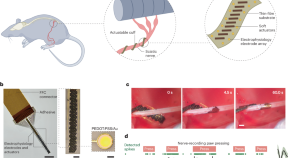
A gentle nerve wrapper
Integrating electrochemically actuated soft robotics with ultra-flexible microelectrodes enables reversible and gentle wrapping around nerves for high-quality recordings.
- Klas Tybrandt
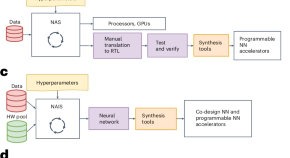
Tiny classifier circuits as accelerators for classification of tabular data
A methodology — called auto tiny classifiers — is proposed to directly generate predictor circuits for the classification of tabular data, searching over the space of combinational logic using an evolutionary algorithm to maximize training prediction accuracy. Prediction performance is comparable to typical machine learning methods, but substantially fewer hardware resources and power are required.
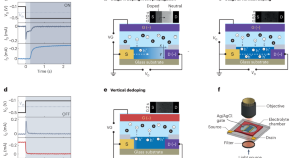
Slow on, fast off
The slow turn-on speed in accumulation-mode organic electrochemical transistors is explained by asymmetric ion transport in switching kinetics.
- Jenny Nelson
Latest Research and Reviews
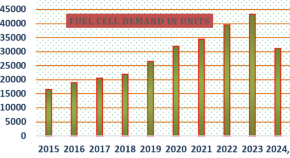
A comprehensive performance analysis of advanced hybrid MPPT controllers for fuel cell systems
- Ezzeddine Touti
- Shaik Rafikiran
- S. Senthilkumar

Autonomous mining through cooperative driving and operations enabled by parallel intelligence
Long Chen and colleagues show a fully autonomous open-pit mine. Heterogenous machinery and tasks are coordinated using parallel learning and digital twins.
- Fei-Yue Wang
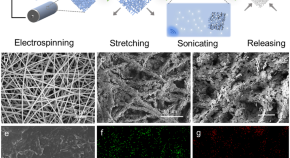
Flexible yet impermeable composites with wrinkle structured BNNSs assembling for high-performance thermal management
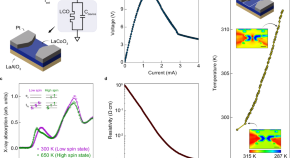
True random number generation using the spin crossover in LaCoO 3
Probabilistic computing demands low power and high quality random number generation. Woo et al. demonstrate the use of a spin crossover in LaCoO3 to generate random numbers that outperform software-generated random numbers in probabilistic computing.
- Kyung Seok Woo
- Suhas Kumar
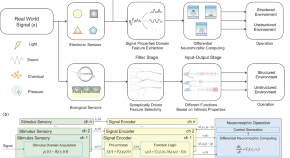
Memristor-based adaptive neuromorphic perception in unstructured environments
Perception methods that enable control systems to understand and adapt to unstructured environments are desired. Wang et. al. develop a memristor-based differential neuromorphic computing, perceptual signal processing, and online adaptation method providing neuromorphic style adaptation to external sensory stimuli.
- Shengbo Wang
- Luigi Giuseppe Occhipinti
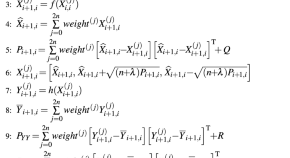
An interpretable online prediction method for remaining useful life of lithium-ion batteries
- Shengyu Shen
- Aigang Zhen
News and Comment
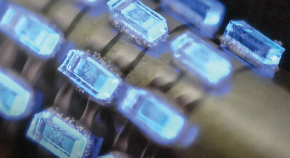
Stretching visions of display technology
Next-generation optoelectronic devices — including quantum dot and perovskite light-emitting diodes — could be used to build stretchable and multifunctional displays.
Unlocking net-zero in semiconductor manufacturing
Driven by trends such as GenAI, Automation and E-mobility, the global semiconductor demand is surging, consequently increasing the industry’s emissions. Given the increasing pressure for decarbonization — for example, from customers such as Apple, Google and Microsoft — semiconductor players need to increase their decarbonization efforts.
- Mark Nikolka
- Sebastian Göke
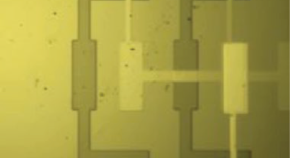
A complementary oxide semiconductor
- Stuart Thomas
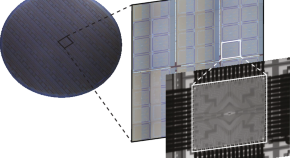
Wafer-scale probing of spin qubits
- Katharina Zeissler
Towards interdisciplinary integration of electrical engineering and earth science
The inherent differences in epistemologies and research methods in electrical engineering and earth science hinder interdisciplinary collaboration. In the context of climate change, this divide affects the shift towards long-term sustainability in global energy systems, prompting dialogue between the disciplines to enable effective interdisciplinary collaborations.
Towards prosthetic limbs and assistive devices controlled via the myokinetic interface
Current human–machine interfaces for controlling assistive devices fail to offer direct, arbitrary control over multiple degrees of freedom. Based on the implantation and tracking of small magnets in the residual muscles, the myokinetic interface could enable biomimetic, direct, independent and parallel control of artificial limbs.
- Christian Cipriani
Quick links
- Explore articles by subject
- Guide to authors
- Editorial policies
Numbers, Facts and Trends Shaping Your World
Read our research on:
Full Topic List
Regions & Countries
Publications
- Our Methods
- Short Reads
- Tools & Resources
Read Our Research On:
Smartphones
How teens and parents approach screen time.
Most teens at least sometimes feel happy and peaceful when they don’t have their phone, but 44% say this makes them anxious. Half of parents say they have looked through their teen’s phone.
Americans’ Use of Mobile Technology and Home Broadband
Most U.S. adults today say they use the internet (95%), have a smartphone (90%) or subscribe to high-speed internet at home (80%). About four-in-ten report being online almost constantly.
Teens and Internet, Device Access Fact Sheet
Today, nearly all U.S. teens (96%) say they use the internet every day. And the share of teens who report being online “almost constantly” has roughly doubled since 2014-2015 (24% vs. 46%).
Social Media Seen as Mostly Good for Democracy Across Many Nations, But U.S. is a Major Outlier
Most think social media has made it easier to manipulate and divide people, but they also say it informs and raises awareness.
For shopping, phones are common and influencers have become a factor – especially for young adults
Social media is an important tool for consumers, with some Americans – particularly younger adults – turning to influencer recommendations.
Share of those 65 and older who are tech users has grown in the past decade
Adoption of key technologies by those in the oldest age group has grown markedly since about a decade ago.
Some digital divides persist between rural, urban and suburban America
Rural adults are less likely than suburban adults to have home broadband and less likely than urban adults to own a smartphone, tablet or computer.
Home broadband adoption, computer ownership vary by race, ethnicity in the U.S.
Black and Hispanic Americans remain less likely than White adults to say they own a traditional computer or have high-speed internet at home.
Online harassment occurs most often on social media, but strikes in other places, too
Three-quarters of U.S. adults who have recently faced some kind of online harassment say it happened on social media.
More than eight-in-ten Americans get news from digital devices
More than eight-in-ten U.S. adults say they get news from a smartphone, computer or tablet “often” or “sometimes.”
REFINE YOUR SELECTION
Research teams.
1615 L St. NW, Suite 800 Washington, DC 20036 USA (+1) 202-419-4300 | Main (+1) 202-857-8562 | Fax (+1) 202-419-4372 | Media Inquiries
Research Topics
- Email Newsletters
ABOUT PEW RESEARCH CENTER Pew Research Center is a nonpartisan fact tank that informs the public about the issues, attitudes and trends shaping the world. It conducts public opinion polling, demographic research, media content analysis and other empirical social science research. Pew Research Center does not take policy positions. It is a subsidiary of The Pew Charitable Trusts .
© 2024 Pew Research Center
A systematic literature review of empirical research on ChatGPT in education
- Open access
- Published: 26 May 2024
- Volume 3 , article number 60 , ( 2024 )
Cite this article
You have full access to this open access article

- Yazid Albadarin ORCID: orcid.org/0009-0005-8068-8902 1 ,
- Mohammed Saqr 1 ,
- Nicolas Pope 1 &
- Markku Tukiainen 1
237 Accesses
Explore all metrics
Over the last four decades, studies have investigated the incorporation of Artificial Intelligence (AI) into education. A recent prominent AI-powered technology that has impacted the education sector is ChatGPT. This article provides a systematic review of 14 empirical studies incorporating ChatGPT into various educational settings, published in 2022 and before the 10th of April 2023—the date of conducting the search process. It carefully followed the essential steps outlined in the Preferred Reporting Items for Systematic Reviews and Meta-Analyses (PRISMA 2020) guidelines, as well as Okoli’s (Okoli in Commun Assoc Inf Syst, 2015) steps for conducting a rigorous and transparent systematic review. In this review, we aimed to explore how students and teachers have utilized ChatGPT in various educational settings, as well as the primary findings of those studies. By employing Creswell’s (Creswell in Educational research: planning, conducting, and evaluating quantitative and qualitative research [Ebook], Pearson Education, London, 2015) coding techniques for data extraction and interpretation, we sought to gain insight into their initial attempts at ChatGPT incorporation into education. This approach also enabled us to extract insights and considerations that can facilitate its effective and responsible use in future educational contexts. The results of this review show that learners have utilized ChatGPT as a virtual intelligent assistant, where it offered instant feedback, on-demand answers, and explanations of complex topics. Additionally, learners have used it to enhance their writing and language skills by generating ideas, composing essays, summarizing, translating, paraphrasing texts, or checking grammar. Moreover, learners turned to it as an aiding tool to facilitate their directed and personalized learning by assisting in understanding concepts and homework, providing structured learning plans, and clarifying assignments and tasks. However, the results of specific studies (n = 3, 21.4%) show that overuse of ChatGPT may negatively impact innovative capacities and collaborative learning competencies among learners. Educators, on the other hand, have utilized ChatGPT to create lesson plans, generate quizzes, and provide additional resources, which helped them enhance their productivity and efficiency and promote different teaching methodologies. Despite these benefits, the majority of the reviewed studies recommend the importance of conducting structured training, support, and clear guidelines for both learners and educators to mitigate the drawbacks. This includes developing critical evaluation skills to assess the accuracy and relevance of information provided by ChatGPT, as well as strategies for integrating human interaction and collaboration into learning activities that involve AI tools. Furthermore, they also recommend ongoing research and proactive dialogue with policymakers, stakeholders, and educational practitioners to refine and enhance the use of AI in learning environments. This review could serve as an insightful resource for practitioners who seek to integrate ChatGPT into education and stimulate further research in the field.
Similar content being viewed by others

Empowering learners with ChatGPT: insights from a systematic literature exploration

Incorporating AI in foreign language education: An investigation into ChatGPT’s effect on foreign language learners

Large language models in education: A focus on the complementary relationship between human teachers and ChatGPT
Avoid common mistakes on your manuscript.
1 Introduction
Educational technology, a rapidly evolving field, plays a crucial role in reshaping the landscape of teaching and learning [ 82 ]. One of the most transformative technological innovations of our era that has influenced the field of education is Artificial Intelligence (AI) [ 50 ]. Over the last four decades, AI in education (AIEd) has gained remarkable attention for its potential to make significant advancements in learning, instructional methods, and administrative tasks within educational settings [ 11 ]. In particular, a large language model (LLM), a type of AI algorithm that applies artificial neural networks (ANNs) and uses massively large data sets to understand, summarize, generate, and predict new content that is almost difficult to differentiate from human creations [ 79 ], has opened up novel possibilities for enhancing various aspects of education, from content creation to personalized instruction [ 35 ]. Chatbots that leverage the capabilities of LLMs to understand and generate human-like responses have also presented the capacity to enhance student learning and educational outcomes by engaging students, offering timely support, and fostering interactive learning experiences [ 46 ].
The ongoing and remarkable technological advancements in chatbots have made their use more convenient, increasingly natural and effortless, and have expanded their potential for deployment across various domains [ 70 ]. One prominent example of chatbot applications is the Chat Generative Pre-Trained Transformer, known as ChatGPT, which was introduced by OpenAI, a leading AI research lab, on November 30th, 2022. ChatGPT employs a variety of deep learning techniques to generate human-like text, with a particular focus on recurrent neural networks (RNNs). Long short-term memory (LSTM) allows it to grasp the context of the text being processed and retain information from previous inputs. Also, the transformer architecture, a neural network architecture based on the self-attention mechanism, allows it to analyze specific parts of the input, thereby enabling it to produce more natural-sounding and coherent output. Additionally, the unsupervised generative pre-training and the fine-tuning methods allow ChatGPT to generate more relevant and accurate text for specific tasks [ 31 , 62 ]. Furthermore, reinforcement learning from human feedback (RLHF), a machine learning approach that combines reinforcement learning techniques with human-provided feedback, has helped improve ChatGPT’s model by accelerating the learning process and making it significantly more efficient.
This cutting-edge natural language processing (NLP) tool is widely recognized as one of today's most advanced LLMs-based chatbots [ 70 ], allowing users to ask questions and receive detailed, coherent, systematic, personalized, convincing, and informative human-like responses [ 55 ], even within complex and ambiguous contexts [ 63 , 77 ]. ChatGPT is considered the fastest-growing technology in history: in just three months following its public launch, it amassed an estimated 120 million monthly active users [ 16 ] with an estimated 13 million daily queries [ 49 ], surpassing all other applications [ 64 ]. This remarkable growth can be attributed to the unique features and user-friendly interface that ChatGPT offers. Its intuitive design allows users to interact seamlessly with the technology, making it accessible to a diverse range of individuals, regardless of their technical expertise [ 78 ]. Additionally, its exceptional performance results from a combination of advanced algorithms, continuous enhancements, and extensive training on a diverse dataset that includes various text sources such as books, articles, websites, and online forums [ 63 ], have contributed to a more engaging and satisfying user experience [ 62 ]. These factors collectively explain its remarkable global growth and set it apart from predecessors like Bard, Bing Chat, ERNIE, and others.
In this context, several studies have explored the technological advancements of chatbots. One noteworthy recent research effort, conducted by Schöbel et al. [ 70 ], stands out for its comprehensive analysis of more than 5,000 studies on communication agents. This study offered a comprehensive overview of the historical progression and future prospects of communication agents, including ChatGPT. Moreover, other studies have focused on making comparisons, particularly between ChatGPT and alternative chatbots like Bard, Bing Chat, ERNIE, LaMDA, BlenderBot, and various others. For example, O’Leary [ 53 ] compared two chatbots, LaMDA and BlenderBot, with ChatGPT and revealed that ChatGPT outperformed both. This superiority arises from ChatGPT’s capacity to handle a wider range of questions and generate slightly varied perspectives within specific contexts. Similarly, ChatGPT exhibited an impressive ability to formulate interpretable responses that were easily understood when compared with Google's feature snippet [ 34 ]. Additionally, ChatGPT was compared to other LLMs-based chatbots, including Bard and BERT, as well as ERNIE. The findings indicated that ChatGPT exhibited strong performance in the given tasks, often outperforming the other models [ 59 ].
Furthermore, in the education context, a comprehensive study systematically compared a range of the most promising chatbots, including Bard, Bing Chat, ChatGPT, and Ernie across a multidisciplinary test that required higher-order thinking. The study revealed that ChatGPT achieved the highest score, surpassing Bing Chat and Bard [ 64 ]. Similarly, a comparative analysis was conducted to compare ChatGPT with Bard in answering a set of 30 mathematical questions and logic problems, grouped into two question sets. Set (A) is unavailable online, while Set (B) is available online. The results revealed ChatGPT's superiority in Set (A) over Bard. Nevertheless, Bard's advantage emerged in Set (B) due to its capacity to access the internet directly and retrieve answers, a capability that ChatGPT does not possess [ 57 ]. However, through these varied assessments, ChatGPT consistently highlights its exceptional prowess compared to various alternatives in the ever-evolving chatbot technology.
The widespread adoption of chatbots, especially ChatGPT, by millions of students and educators, has sparked extensive discussions regarding its incorporation into the education sector [ 64 ]. Accordingly, many scholars have contributed to the discourse, expressing both optimism and pessimism regarding the incorporation of ChatGPT into education. For example, ChatGPT has been highlighted for its capabilities in enriching the learning and teaching experience through its ability to support different learning approaches, including adaptive learning, personalized learning, and self-directed learning [ 58 , 60 , 91 ]), deliver summative and formative feedback to students and provide real-time responses to questions, increase the accessibility of information [ 22 , 40 , 43 ], foster students’ performance, engagement and motivation [ 14 , 44 , 58 ], and enhance teaching practices [ 17 , 18 , 64 , 74 ].
On the other hand, concerns have been also raised regarding its potential negative effects on learning and teaching. These include the dissemination of false information and references [ 12 , 23 , 61 , 85 ], biased reinforcement [ 47 , 50 ], compromised academic integrity [ 18 , 40 , 66 , 74 ], and the potential decline in students' skills [ 43 , 61 , 64 , 74 ]. As a result, ChatGPT has been banned in multiple countries, including Russia, China, Venezuela, Belarus, and Iran, as well as in various educational institutions in India, Italy, Western Australia, France, and the United States [ 52 , 90 ].
Clearly, the advent of chatbots, especially ChatGPT, has provoked significant controversy due to their potential impact on learning and teaching. This indicates the necessity for further exploration to gain a deeper understanding of this technology and carefully evaluate its potential benefits, limitations, challenges, and threats to education [ 79 ]. Therefore, conducting a systematic literature review will provide valuable insights into the potential prospects and obstacles linked to its incorporation into education. This systematic literature review will primarily focus on ChatGPT, driven by the aforementioned key factors outlined above.
However, the existing literature lacks a systematic literature review of empirical studies. Thus, this systematic literature review aims to address this gap by synthesizing the existing empirical studies conducted on chatbots, particularly ChatGPT, in the field of education, highlighting how ChatGPT has been utilized in educational settings, and identifying any existing gaps. This review may be particularly useful for researchers in the field and educators who are contemplating the integration of ChatGPT or any chatbot into education. The following research questions will guide this study:
What are students' and teachers' initial attempts at utilizing ChatGPT in education?
What are the main findings derived from empirical studies that have incorporated ChatGPT into learning and teaching?
2 Methodology
To conduct this study, the authors followed the essential steps of the Preferred Reporting Items for Systematic Reviews and Meta-Analyses (PRISMA 2020) and Okoli’s [ 54 ] steps for conducting a systematic review. These included identifying the study’s purpose, drafting a protocol, applying a practical screening process, searching the literature, extracting relevant data, evaluating the quality of the included studies, synthesizing the studies, and ultimately writing the review. The subsequent section provides an extensive explanation of how these steps were carried out in this study.
2.1 Identify the purpose
Given the widespread adoption of ChatGPT by students and teachers for various educational purposes, often without a thorough understanding of responsible and effective use or a clear recognition of its potential impact on learning and teaching, the authors recognized the need for further exploration of ChatGPT's impact on education in this early stage. Therefore, they have chosen to conduct a systematic literature review of existing empirical studies that incorporate ChatGPT into educational settings. Despite the limited number of empirical studies due to the novelty of the topic, their goal is to gain a deeper understanding of this technology and proactively evaluate its potential benefits, limitations, challenges, and threats to education. This effort could help to understand initial reactions and attempts at incorporating ChatGPT into education and bring out insights and considerations that can inform the future development of education.
2.2 Draft the protocol
The next step is formulating the protocol. This protocol serves to outline the study process in a rigorous and transparent manner, mitigating researcher bias in study selection and data extraction [ 88 ]. The protocol will include the following steps: generating the research question, predefining a literature search strategy, identifying search locations, establishing selection criteria, assessing the studies, developing a data extraction strategy, and creating a timeline.
2.3 Apply practical screen
The screening step aims to accurately filter the articles resulting from the searching step and select the empirical studies that have incorporated ChatGPT into educational contexts, which will guide us in answering the research questions and achieving the objectives of this study. To ensure the rigorous execution of this step, our inclusion and exclusion criteria were determined based on the authors' experience and informed by previous successful systematic reviews [ 21 ]. Table 1 summarizes the inclusion and exclusion criteria for study selection.
2.4 Literature search
We conducted a thorough literature search to identify articles that explored, examined, and addressed the use of ChatGPT in Educational contexts. We utilized two research databases: Dimensions.ai, which provides access to a large number of research publications, and lens.org, which offers access to over 300 million articles, patents, and other research outputs from diverse sources. Additionally, we included three databases, Scopus, Web of Knowledge, and ERIC, which contain relevant research on the topic that addresses our research questions. To browse and identify relevant articles, we used the following search formula: ("ChatGPT" AND "Education"), which included the Boolean operator "AND" to get more specific results. The subject area in the Scopus and ERIC databases were narrowed to "ChatGPT" and "Education" keywords, and in the WoS database was limited to the "Education" category. The search was conducted between the 3rd and 10th of April 2023, which resulted in 276 articles from all selected databases (111 articles from Dimensions.ai, 65 from Scopus, 28 from Web of Science, 14 from ERIC, and 58 from Lens.org). These articles were imported into the Rayyan web-based system for analysis. The duplicates were identified automatically by the system. Subsequently, the first author manually reviewed the duplicated articles ensured that they had the same content, and then removed them, leaving us with 135 unique articles. Afterward, the titles, abstracts, and keywords of the first 40 manuscripts were scanned and reviewed by the first author and were discussed with the second and third authors to resolve any disagreements. Subsequently, the first author proceeded with the filtering process for all articles and carefully applied the inclusion and exclusion criteria as presented in Table 1 . Articles that met any one of the exclusion criteria were eliminated, resulting in 26 articles. Afterward, the authors met to carefully scan and discuss them. The authors agreed to eliminate any empirical studies solely focused on checking ChatGPT capabilities, as these studies do not guide us in addressing the research questions and achieving the study's objectives. This resulted in 14 articles eligible for analysis.
2.5 Quality appraisal
The examination and evaluation of the quality of the extracted articles is a vital step [ 9 ]. Therefore, the extracted articles were carefully evaluated for quality using Fink’s [ 24 ] standards, which emphasize the necessity for detailed descriptions of methodology, results, conclusions, strengths, and limitations. The process began with a thorough assessment of each study's design, data collection, and analysis methods to ensure their appropriateness and comprehensive execution. The clarity, consistency, and logical progression from data to results and conclusions were also critically examined. Potential biases and recognized limitations within the studies were also scrutinized. Ultimately, two articles were excluded for failing to meet Fink’s criteria, particularly in providing sufficient detail on methodology, results, conclusions, strengths, or limitations. The review process is illustrated in Fig. 1 .

The study selection process
2.6 Data extraction
The next step is data extraction, the process of capturing the key information and categories from the included studies. To improve efficiency, reduce variation among authors, and minimize errors in data analysis, the coding categories were constructed using Creswell's [ 15 ] coding techniques for data extraction and interpretation. The coding process involves three sequential steps. The initial stage encompasses open coding , where the researcher examines the data, generates codes to describe and categorize it, and gains a deeper understanding without preconceived ideas. Following open coding is axial coding , where the interrelationships between codes from open coding are analyzed to establish more comprehensive categories or themes. The process concludes with selective coding , refining and integrating categories or themes to identify core concepts emerging from the data. The first coder performed the coding process, then engaged in discussions with the second and third authors to finalize the coding categories for the first five articles. The first coder then proceeded to code all studies and engaged again in discussions with the other authors to ensure the finalization of the coding process. After a comprehensive analysis and capturing of the key information from the included studies, the data extraction and interpretation process yielded several themes. These themes have been categorized and are presented in Table 2 . It is important to note that open coding results were removed from Table 2 for aesthetic reasons, as it included many generic aspects, such as words, short phrases, or sentences mentioned in the studies.
2.7 Synthesize studies
In this stage, we will gather, discuss, and analyze the key findings that emerged from the selected studies. The synthesis stage is considered a transition from an author-centric to a concept-centric focus, enabling us to map all the provided information to achieve the most effective evaluation of the data [ 87 ]. Initially, the authors extracted data that included general information about the selected studies, including the author(s)' names, study titles, years of publication, educational levels, research methodologies, sample sizes, participants, main aims or objectives, raw data sources, and analysis methods. Following that, all key information and significant results from the selected studies were compiled using Creswell’s [ 15 ] coding techniques for data extraction and interpretation to identify core concepts and themes emerging from the data, focusing on those that directly contributed to our research questions and objectives, such as the initial utilization of ChatGPT in learning and teaching, learners' and educators' familiarity with ChatGPT, and the main findings of each study. Finally, the data related to each selected study were extracted into an Excel spreadsheet for data processing. The Excel spreadsheet was reviewed by the authors, including a series of discussions to ensure the finalization of this process and prepare it for further analysis. Afterward, the final result being analyzed and presented in various types of charts and graphs. Table 4 presents the extracted data from the selected studies, with each study labeled with a capital 'S' followed by a number.
This section consists of two main parts. The first part provides a descriptive analysis of the data compiled from the reviewed studies. The second part presents the answers to the research questions and the main findings of these studies.
3.1 Part 1: descriptive analysis
This section will provide a descriptive analysis of the reviewed studies, including educational levels and fields, participants distribution, country contribution, research methodologies, study sample size, study population, publication year, list of journals, familiarity with ChatGPT, source of data, and the main aims and objectives of the studies. Table 4 presents a comprehensive overview of the extracted data from the selected studies.
3.1.1 The number of the reviewed studies and publication years
The total number of the reviewed studies was 14. All studies were empirical studies and published in different journals focusing on Education and Technology. One study was published in 2022 [S1], while the remaining were published in 2023 [S2]-[S14]. Table 3 illustrates the year of publication, the names of the journals, and the number of reviewed studies published in each journal for the studies reviewed.
3.1.2 Educational levels and fields
The majority of the reviewed studies, 11 studies, were conducted in higher education institutions [S1]-[S10] and [S13]. Two studies did not specify the educational level of the population [S12] and [S14], while one study focused on elementary education [S11]. However, the reviewed studies covered various fields of education. Three studies focused on Arts and Humanities Education [S8], [S11], and [S14], specifically English Education. Two studies focused on Engineering Education, with one in Computer Engineering [S2] and the other in Construction Education [S3]. Two studies focused on Mathematics Education [S5] and [S12]. One study focused on Social Science Education [S13]. One study focused on Early Education [S4]. One study focused on Journalism Education [S9]. Finally, three studies did not specify the field of education [S1], [S6], and [S7]. Figure 2 represents the educational levels in the reviewed studies, while Fig. 3 represents the context of the reviewed studies.

Educational levels in the reviewed studies

Context of the reviewed studies
3.1.3 Participants distribution and countries contribution
The reviewed studies have been conducted across different geographic regions, providing a diverse representation of the studies. The majority of the studies, 10 in total, [S1]-[S3], [S5]-[S9], [S11], and [S14], primarily focused on participants from single countries such as Pakistan, the United Arab Emirates, China, Indonesia, Poland, Saudi Arabia, South Korea, Spain, Tajikistan, and the United States. In contrast, four studies, [S4], [S10], [S12], and [S13], involved participants from multiple countries, including China and the United States [S4], China, the United Kingdom, and the United States [S10], the United Arab Emirates, Oman, Saudi Arabia, and Jordan [S12], Turkey, Sweden, Canada, and Australia [ 13 ]. Figures 4 and 5 illustrate the distribution of participants, whether from single or multiple countries, and the contribution of each country in the reviewed studies, respectively.

The reviewed studies conducted in single or multiple countries

The Contribution of each country in the studies
3.1.4 Study population and sample size
Four study populations were included: university students, university teachers, university teachers and students, and elementary school teachers. Six studies involved university students [S2], [S3], [S5] and [S6]-[S8]. Three studies focused on university teachers [S1], [S4], and [S6], while one study specifically targeted elementary school teachers [S11]. Additionally, four studies included both university teachers and students [S10] and [ 12 , 13 , 14 ], and among them, study [S13] specifically included postgraduate students. In terms of the sample size of the reviewed studies, nine studies included a small sample size of less than 50 participants [S1], [S3], [S6], [S8], and [S10]-[S13]. Three studies had 50–100 participants [S2], [S9], and [S14]. Only one study had more than 100 participants [S7]. It is worth mentioning that study [S4] adopted a mixed methods approach, including 10 participants for qualitative analysis and 110 participants for quantitative analysis.
3.1.5 Participants’ familiarity with using ChatGPT
The reviewed studies recruited a diverse range of participants with varying levels of familiarity with ChatGPT. Five studies [S2], [S4], [S6], [S8], and [S12] involved participants already familiar with ChatGPT, while eight studies [S1], [S3], [S5], [S7], [S9], [S10], [S13] and [S14] included individuals with differing levels of familiarity. Notably, one study [S11] had participants who were entirely unfamiliar with ChatGPT. It is important to note that four studies [S3], [S5], [S9], and [S11] provided training or guidance to their participants before conducting their studies, while ten studies [S1], [S2], [S4], [S6]-[S8], [S10], and [S12]-[S14] did not provide training due to the participants' existing familiarity with ChatGPT.
3.1.6 Research methodology approaches and source(S) of data
The reviewed studies adopted various research methodology approaches. Seven studies adopted qualitative research methodology [S1], [S4], [S6], [S8], [S10], [S11], and [S12], while three studies adopted quantitative research methodology [S3], [S7], and [S14], and four studies employed mixed-methods, which involved a combination of both the strengths of qualitative and quantitative methods [S2], [S5], [S9], and [S13].
In terms of the source(s) of data, the reviewed studies obtained their data from various sources, such as interviews, questionnaires, and pre-and post-tests. Six studies relied on interviews as their primary source of data collection [S1], [S4], [S6], [S10], [S11], and [S12], four studies relied on questionnaires [S2], [S7], [S13], and [S14], two studies combined the use of pre-and post-tests and questionnaires for data collection [S3] and [S9], while two studies combined the use of questionnaires and interviews to obtain the data [S5] and [S8]. It is important to note that six of the reviewed studies were quasi-experimental [S3], [S5], [S8], [S9], [S12], and [S14], while the remaining ones were experimental studies [S1], [S2], [S4], [S6], [S7], [S10], [S11], and [S13]. Figures 6 and 7 illustrate the research methodologies and the source (s) of data used in the reviewed studies, respectively.

Research methodologies in the reviewed studies

Source of data in the reviewed studies
3.1.7 The aim and objectives of the studies
The reviewed studies encompassed a diverse set of aims, with several of them incorporating multiple primary objectives. Six studies [S3], [S6], [S7], [S8], [S11], and [S12] examined the integration of ChatGPT in educational contexts, and four studies [S4], [S5], [S13], and [S14] investigated the various implications of its use in education, while three studies [S2], [S9], and [S10] aimed to explore both its integration and implications in education. Additionally, seven studies explicitly explored attitudes and perceptions of students [S2] and [S3], educators [S1] and [S6], or both [S10], [S12], and [S13] regarding the utilization of ChatGPT in educational settings.
3.2 Part 2: research questions and main findings of the reviewed studies
This part will present the answers to the research questions and the main findings of the reviewed studies, classified into two main categories (learning and teaching) according to AI Education classification by [ 36 ]. Figure 8 summarizes the main findings of the reviewed studies in a visually informative diagram. Table 4 provides a detailed list of the key information extracted from the selected studies that led to generating these themes.

The main findings in the reviewed studies
4 Students' initial attempts at utilizing ChatGPT in learning and main findings from students' perspective
4.1 virtual intelligent assistant.
Nine studies demonstrated that ChatGPT has been utilized by students as an intelligent assistant to enhance and support their learning. Students employed it for various purposes, such as answering on-demand questions [S2]-[S5], [S8], [S10], and [S12], providing valuable information and learning resources [S2]-[S5], [S6], and [S8], as well as receiving immediate feedback [S2], [S4], [S9], [S10], and [S12]. In this regard, students generally were confident in the accuracy of ChatGPT's responses, considering them relevant, reliable, and detailed [S3], [S4], [S5], and [S8]. However, some students indicated the need for improvement, as they found that answers are not always accurate [S2], and that misleading information may have been provided or that it may not always align with their expectations [S6] and [S10]. It was also observed by the students that the accuracy of ChatGPT is dependent on several factors, including the quality and specificity of the user's input, the complexity of the question or topic, and the scope and relevance of its training data [S12]. Many students felt that ChatGPT's answers were not always accurate and most of them believed that it requires good background knowledge to work with.
4.2 Writing and language proficiency assistant
Six of the reviewed studies highlighted that ChatGPT has been utilized by students as a valuable assistant tool to improve their academic writing skills and language proficiency. Among these studies, three mainly focused on English education, demonstrating that students showed sufficient mastery in using ChatGPT for generating ideas, summarizing, paraphrasing texts, and completing writing essays [S8], [S11], and [S14]. Furthermore, ChatGPT helped them in writing by making students active investigators rather than passive knowledge recipients and facilitated the development of their writing skills [S11] and [S14]. Similarly, ChatGPT allowed students to generate unique ideas and perspectives, leading to deeper analysis and reflection on their journalism writing [S9]. In terms of language proficiency, ChatGPT allowed participants to translate content into their home languages, making it more accessible and relevant to their context [S4]. It also enabled them to request changes in linguistic tones or flavors [S8]. Moreover, participants used it to check grammar or as a dictionary [S11].
4.3 Valuable resource for learning approaches
Five studies demonstrated that students used ChatGPT as a valuable complementary resource for self-directed learning. It provided learning resources and guidance on diverse educational topics and created a supportive home learning environment [S2] and [S4]. Moreover, it offered step-by-step guidance to grasp concepts at their own pace and enhance their understanding [S5], streamlined task and project completion carried out independently [S7], provided comprehensive and easy-to-understand explanations on various subjects [S10], and assisted in studying geometry operations, thereby empowering them to explore geometry operations at their own pace [S12]. Three studies showed that students used ChatGPT as a valuable learning resource for personalized learning. It delivered age-appropriate conversations and tailored teaching based on a child's interests [S4], acted as a personalized learning assistant, adapted to their needs and pace, which assisted them in understanding mathematical concepts [S12], and enabled personalized learning experiences in social sciences by adapting to students' needs and learning styles [S13]. On the other hand, it is important to note that, according to one study [S5], students suggested that using ChatGPT may negatively affect collaborative learning competencies between students.
4.4 Enhancing students' competencies
Six of the reviewed studies have shown that ChatGPT is a valuable tool for improving a wide range of skills among students. Two studies have provided evidence that ChatGPT led to improvements in students' critical thinking, reasoning skills, and hazard recognition competencies through engaging them in interactive conversations or activities and providing responses related to their disciplines in journalism [S5] and construction education [S9]. Furthermore, two studies focused on mathematical education have shown the positive impact of ChatGPT on students' problem-solving abilities in unraveling problem-solving questions [S12] and enhancing the students' understanding of the problem-solving process [S5]. Lastly, one study indicated that ChatGPT effectively contributed to the enhancement of conversational social skills [S4].
4.5 Supporting students' academic success
Seven of the reviewed studies highlighted that students found ChatGPT to be beneficial for learning as it enhanced learning efficiency and improved the learning experience. It has been observed to improve students' efficiency in computer engineering studies by providing well-structured responses and good explanations [S2]. Additionally, students found it extremely useful for hazard reporting [S3], and it also enhanced their efficiency in solving mathematics problems and capabilities [S5] and [S12]. Furthermore, by finding information, generating ideas, translating texts, and providing alternative questions, ChatGPT aided students in deepening their understanding of various subjects [S6]. It contributed to an increase in students' overall productivity [S7] and improved efficiency in composing written tasks [S8]. Regarding learning experiences, ChatGPT was instrumental in assisting students in identifying hazards that they might have otherwise overlooked [S3]. It also improved students' learning experiences in solving mathematics problems and developing abilities [S5] and [S12]. Moreover, it increased students' successful completion of important tasks in their studies [S7], particularly those involving average difficulty writing tasks [S8]. Additionally, ChatGPT increased the chances of educational success by providing students with baseline knowledge on various topics [S10].
5 Teachers' initial attempts at utilizing ChatGPT in teaching and main findings from teachers' perspective
5.1 valuable resource for teaching.
The reviewed studies showed that teachers have employed ChatGPT to recommend, modify, and generate diverse, creative, organized, and engaging educational contents, teaching materials, and testing resources more rapidly [S4], [S6], [S10] and [S11]. Additionally, teachers experienced increased productivity as ChatGPT facilitated quick and accurate responses to questions, fact-checking, and information searches [S1]. It also proved valuable in constructing new knowledge [S6] and providing timely answers to students' questions in classrooms [S11]. Moreover, ChatGPT enhanced teachers' efficiency by generating new ideas for activities and preplanning activities for their students [S4] and [S6], including interactive language game partners [S11].
5.2 Improving productivity and efficiency
The reviewed studies showed that participants' productivity and work efficiency have been significantly enhanced by using ChatGPT as it enabled them to allocate more time to other tasks and reduce their overall workloads [S6], [S10], [S11], [S13], and [S14]. However, three studies [S1], [S4], and [S11], indicated a negative perception and attitude among teachers toward using ChatGPT. This negativity stemmed from a lack of necessary skills to use it effectively [S1], a limited familiarity with it [S4], and occasional inaccuracies in the content provided by it [S10].
5.3 Catalyzing new teaching methodologies
Five of the reviewed studies highlighted that educators found the necessity of redefining their teaching profession with the assistance of ChatGPT [S11], developing new effective learning strategies [S4], and adapting teaching strategies and methodologies to ensure the development of essential skills for future engineers [S5]. They also emphasized the importance of adopting new educational philosophies and approaches that can evolve with the introduction of ChatGPT into the classroom [S12]. Furthermore, updating curricula to focus on improving human-specific features, such as emotional intelligence, creativity, and philosophical perspectives [S13], was found to be essential.
5.4 Effective utilization of CHATGPT in teaching
According to the reviewed studies, effective utilization of ChatGPT in education requires providing teachers with well-structured training, support, and adequate background on how to use ChatGPT responsibly [S1], [S3], [S11], and [S12]. Establishing clear rules and regulations regarding its usage is essential to ensure it positively impacts the teaching and learning processes, including students' skills [S1], [S4], [S5], [S8], [S9], and [S11]-[S14]. Moreover, conducting further research and engaging in discussions with policymakers and stakeholders is indeed crucial for the successful integration of ChatGPT in education and to maximize the benefits for both educators and students [S1], [S6]-[S10], and [S12]-[S14].
6 Discussion
The purpose of this review is to conduct a systematic review of empirical studies that have explored the utilization of ChatGPT, one of today’s most advanced LLM-based chatbots, in education. The findings of the reviewed studies showed several ways of ChatGPT utilization in different learning and teaching practices as well as it provided insights and considerations that can facilitate its effective and responsible use in future educational contexts. The results of the reviewed studies came from diverse fields of education, which helped us avoid a biased review that is limited to a specific field. Similarly, the reviewed studies have been conducted across different geographic regions. This kind of variety in geographic representation enriched the findings of this review.
In response to RQ1 , "What are students' and teachers' initial attempts at utilizing ChatGPT in education?", the findings from this review provide comprehensive insights. Chatbots, including ChatGPT, play a crucial role in supporting student learning, enhancing their learning experiences, and facilitating diverse learning approaches [ 42 , 43 ]. This review found that this tool, ChatGPT, has been instrumental in enhancing students' learning experiences by serving as a virtual intelligent assistant, providing immediate feedback, on-demand answers, and engaging in educational conversations. Additionally, students have benefited from ChatGPT’s ability to generate ideas, compose essays, and perform tasks like summarizing, translating, paraphrasing texts, or checking grammar, thereby enhancing their writing and language competencies. Furthermore, students have turned to ChatGPT for assistance in understanding concepts and homework, providing structured learning plans, and clarifying assignments and tasks, which fosters a supportive home learning environment, allowing them to take responsibility for their own learning and cultivate the skills and approaches essential for supportive home learning environment [ 26 , 27 , 28 ]. This finding aligns with the study of Saqr et al. [ 68 , 69 ] who highlighted that, when students actively engage in their own learning process, it yields additional advantages, such as heightened motivation, enhanced achievement, and the cultivation of enthusiasm, turning them into advocates for their own learning.
Moreover, students have utilized ChatGPT for tailored teaching and step-by-step guidance on diverse educational topics, streamlining task and project completion, and generating and recommending educational content. This personalization enhances the learning environment, leading to increased academic success. This finding aligns with other recent studies [ 26 , 27 , 28 , 60 , 66 ] which revealed that ChatGPT has the potential to offer personalized learning experiences and support an effective learning process by providing students with customized feedback and explanations tailored to their needs and abilities. Ultimately, fostering students' performance, engagement, and motivation, leading to increase students' academic success [ 14 , 44 , 58 ]. This ultimate outcome is in line with the findings of Saqr et al. [ 68 , 69 ], which emphasized that learning strategies are important catalysts of students' learning, as students who utilize effective learning strategies are more likely to have better academic achievement.
Teachers, too, have capitalized on ChatGPT's capabilities to enhance productivity and efficiency, using it for creating lesson plans, generating quizzes, providing additional resources, generating and preplanning new ideas for activities, and aiding in answering students’ questions. This adoption of technology introduces new opportunities to support teaching and learning practices, enhancing teacher productivity. This finding aligns with those of Day [ 17 ], De Castro [ 18 ], and Su and Yang [ 74 ] as well as with those of Valtonen et al. [ 82 ], who revealed that emerging technological advancements have opened up novel opportunities and means to support teaching and learning practices, and enhance teachers’ productivity.
In response to RQ2 , "What are the main findings derived from empirical studies that have incorporated ChatGPT into learning and teaching?", the findings from this review provide profound insights and raise significant concerns. Starting with the insights, chatbots, including ChatGPT, have demonstrated the potential to reshape and revolutionize education, creating new, novel opportunities for enhancing the learning process and outcomes [ 83 ], facilitating different learning approaches, and offering a range of pedagogical benefits [ 19 , 43 , 72 ]. In this context, this review found that ChatGPT could open avenues for educators to adopt or develop new effective learning and teaching strategies that can evolve with the introduction of ChatGPT into the classroom. Nonetheless, there is an evident lack of research understanding regarding the potential impact of generative machine learning models within diverse educational settings [ 83 ]. This necessitates teachers to attain a high level of proficiency in incorporating chatbots, such as ChatGPT, into their classrooms to create inventive, well-structured, and captivating learning strategies. In the same vein, the review also found that teachers without the requisite skills to utilize ChatGPT realized that it did not contribute positively to their work and could potentially have adverse effects [ 37 ]. This concern could lead to inequity of access to the benefits of chatbots, including ChatGPT, as individuals who lack the necessary expertise may not be able to harness their full potential, resulting in disparities in educational outcomes and opportunities. Therefore, immediate action is needed to address these potential issues. A potential solution is offering training, support, and competency development for teachers to ensure that all of them can leverage chatbots, including ChatGPT, effectively and equitably in their educational practices [ 5 , 28 , 80 ], which could enhance accessibility and inclusivity, and potentially result in innovative outcomes [ 82 , 83 ].
Additionally, chatbots, including ChatGPT, have the potential to significantly impact students' thinking abilities, including retention, reasoning, analysis skills [ 19 , 45 ], and foster innovation and creativity capabilities [ 83 ]. This review found that ChatGPT could contribute to improving a wide range of skills among students. However, it found that frequent use of ChatGPT may result in a decrease in innovative capacities, collaborative skills and cognitive capacities, and students' motivation to attend classes, as well as could lead to reduced higher-order thinking skills among students [ 22 , 29 ]. Therefore, immediate action is needed to carefully examine the long-term impact of chatbots such as ChatGPT, on learning outcomes as well as to explore its incorporation into educational settings as a supportive tool without compromising students' cognitive development and critical thinking abilities. In the same vein, the review also found that it is challenging to draw a consistent conclusion regarding the potential of ChatGPT to aid self-directed learning approach. This finding aligns with the recent study of Baskara [ 8 ]. Therefore, further research is needed to explore the potential of ChatGPT for self-directed learning. One potential solution involves utilizing learning analytics as a novel approach to examine various aspects of students' learning and support them in their individual endeavors [ 32 ]. This approach can bridge this gap by facilitating an in-depth analysis of how learners engage with ChatGPT, identifying trends in self-directed learning behavior, and assessing its influence on their outcomes.
Turning to the significant concerns, on the other hand, a fundamental challenge with LLM-based chatbots, including ChatGPT, is the accuracy and quality of the provided information and responses, as they provide false information as truth—a phenomenon often referred to as "hallucination" [ 3 , 49 ]. In this context, this review found that the provided information was not entirely satisfactory. Consequently, the utilization of chatbots presents potential concerns, such as generating and providing inaccurate or misleading information, especially for students who utilize it to support their learning. This finding aligns with other findings [ 6 , 30 , 35 , 40 ] which revealed that incorporating chatbots such as ChatGPT, into education presents challenges related to its accuracy and reliability due to its training on a large corpus of data, which may contain inaccuracies and the way users formulate or ask ChatGPT. Therefore, immediate action is needed to address these potential issues. One possible solution is to equip students with the necessary skills and competencies, which include a background understanding of how to use it effectively and the ability to assess and evaluate the information it generates, as the accuracy and the quality of the provided information depend on the input, its complexity, the topic, and the relevance of its training data [ 28 , 49 , 86 ]. However, it's also essential to examine how learners can be educated about how these models operate, the data used in their training, and how to recognize their limitations, challenges, and issues [ 79 ].
Furthermore, chatbots present a substantial challenge concerning maintaining academic integrity [ 20 , 56 ] and copyright violations [ 83 ], which are significant concerns in education. The review found that the potential misuse of ChatGPT might foster cheating, facilitate plagiarism, and threaten academic integrity. This issue is also affirmed by the research conducted by Basic et al. [ 7 ], who presented evidence that students who utilized ChatGPT in their writing assignments had more plagiarism cases than those who did not. These findings align with the conclusions drawn by Cotton et al. [ 13 ], Hisan and Amri [ 33 ] and Sullivan et al. [ 75 ], who revealed that the integration of chatbots such as ChatGPT into education poses a significant challenge to the preservation of academic integrity. Moreover, chatbots, including ChatGPT, have increased the difficulty in identifying plagiarism [ 47 , 67 , 76 ]. The findings from previous studies [ 1 , 84 ] indicate that AI-generated text often went undetected by plagiarism software, such as Turnitin. However, Turnitin and other similar plagiarism detection tools, such as ZeroGPT, GPTZero, and Copyleaks, have since evolved, incorporating enhanced techniques to detect AI-generated text, despite the possibility of false positives, as noted in different studies that have found these tools still not yet fully ready to accurately and reliably identify AI-generated text [ 10 , 51 ], and new novel detection methods may need to be created and implemented for AI-generated text detection [ 4 ]. This potential issue could lead to another concern, which is the difficulty of accurately evaluating student performance when they utilize chatbots such as ChatGPT assistance in their assignments. Consequently, the most LLM-driven chatbots present a substantial challenge to traditional assessments [ 64 ]. The findings from previous studies indicate the importance of rethinking, improving, and redesigning innovative assessment methods in the era of chatbots [ 14 , 20 , 64 , 75 ]. These methods should prioritize the process of evaluating students' ability to apply knowledge to complex cases and demonstrate comprehension, rather than solely focusing on the final product for assessment. Therefore, immediate action is needed to address these potential issues. One possible solution would be the development of clear guidelines, regulatory policies, and pedagogical guidance. These measures would help regulate the proper and ethical utilization of chatbots, such as ChatGPT, and must be established before their introduction to students [ 35 , 38 , 39 , 41 , 89 ].
In summary, our review has delved into the utilization of ChatGPT, a prominent example of chatbots, in education, addressing the question of how ChatGPT has been utilized in education. However, there remain significant gaps, which necessitate further research to shed light on this area.
7 Conclusions
This systematic review has shed light on the varied initial attempts at incorporating ChatGPT into education by both learners and educators, while also offering insights and considerations that can facilitate its effective and responsible use in future educational contexts. From the analysis of 14 selected studies, the review revealed the dual-edged impact of ChatGPT in educational settings. On the positive side, ChatGPT significantly aided the learning process in various ways. Learners have used it as a virtual intelligent assistant, benefiting from its ability to provide immediate feedback, on-demand answers, and easy access to educational resources. Additionally, it was clear that learners have used it to enhance their writing and language skills, engaging in practices such as generating ideas, composing essays, and performing tasks like summarizing, translating, paraphrasing texts, or checking grammar. Importantly, other learners have utilized it in supporting and facilitating their directed and personalized learning on a broad range of educational topics, assisting in understanding concepts and homework, providing structured learning plans, and clarifying assignments and tasks. Educators, on the other hand, found ChatGPT beneficial for enhancing productivity and efficiency. They used it for creating lesson plans, generating quizzes, providing additional resources, and answers learners' questions, which saved time and allowed for more dynamic and engaging teaching strategies and methodologies.
However, the review also pointed out negative impacts. The results revealed that overuse of ChatGPT could decrease innovative capacities and collaborative learning among learners. Specifically, relying too much on ChatGPT for quick answers can inhibit learners' critical thinking and problem-solving skills. Learners might not engage deeply with the material or consider multiple solutions to a problem. This tendency was particularly evident in group projects, where learners preferred consulting ChatGPT individually for solutions over brainstorming and collaborating with peers, which negatively affected their teamwork abilities. On a broader level, integrating ChatGPT into education has also raised several concerns, including the potential for providing inaccurate or misleading information, issues of inequity in access, challenges related to academic integrity, and the possibility of misusing the technology.
Accordingly, this review emphasizes the urgency of developing clear rules, policies, and regulations to ensure ChatGPT's effective and responsible use in educational settings, alongside other chatbots, by both learners and educators. This requires providing well-structured training to educate them on responsible usage and understanding its limitations, along with offering sufficient background information. Moreover, it highlights the importance of rethinking, improving, and redesigning innovative teaching and assessment methods in the era of ChatGPT. Furthermore, conducting further research and engaging in discussions with policymakers and stakeholders are essential steps to maximize the benefits for both educators and learners and ensure academic integrity.
It is important to acknowledge that this review has certain limitations. Firstly, the limited inclusion of reviewed studies can be attributed to several reasons, including the novelty of the technology, as new technologies often face initial skepticism and cautious adoption; the lack of clear guidelines or best practices for leveraging this technology for educational purposes; and institutional or governmental policies affecting the utilization of this technology in educational contexts. These factors, in turn, have affected the number of studies available for review. Secondly, the utilization of the original version of ChatGPT, based on GPT-3 or GPT-3.5, implies that new studies utilizing the updated version, GPT-4 may lead to different findings. Therefore, conducting follow-up systematic reviews is essential once more empirical studies on ChatGPT are published. Additionally, long-term studies are necessary to thoroughly examine and assess the impact of ChatGPT on various educational practices.
Despite these limitations, this systematic review has highlighted the transformative potential of ChatGPT in education, revealing its diverse utilization by learners and educators alike and summarized the benefits of incorporating it into education, as well as the forefront critical concerns and challenges that must be addressed to facilitate its effective and responsible use in future educational contexts. This review could serve as an insightful resource for practitioners who seek to integrate ChatGPT into education and stimulate further research in the field.
Data availability
The data supporting our findings are available upon request.
Abbreviations
- Artificial intelligence
AI in education
Large language model
Artificial neural networks
Chat Generative Pre-Trained Transformer
Recurrent neural networks
Long short-term memory
Reinforcement learning from human feedback
Natural language processing
Preferred Reporting Items for Systematic Reviews and Meta-Analyses
AlAfnan MA, Dishari S, Jovic M, Lomidze K. ChatGPT as an educational tool: opportunities, challenges, and recommendations for communication, business writing, and composition courses. J Artif Intell Technol. 2023. https://doi.org/10.37965/jait.2023.0184 .
Article Google Scholar
Ali JKM, Shamsan MAA, Hezam TA, Mohammed AAQ. Impact of ChatGPT on learning motivation. J Engl Stud Arabia Felix. 2023;2(1):41–9. https://doi.org/10.56540/jesaf.v2i1.51 .
Alkaissi H, McFarlane SI. Artificial hallucinations in ChatGPT: implications in scientific writing. Cureus. 2023. https://doi.org/10.7759/cureus.35179 .
Anderson N, Belavý DL, Perle SM, Hendricks S, Hespanhol L, Verhagen E, Memon AR. AI did not write this manuscript, or did it? Can we trick the AI text detector into generated texts? The potential future of ChatGPT and AI in sports & exercise medicine manuscript generation. BMJ Open Sport Exerc Med. 2023;9(1): e001568. https://doi.org/10.1136/bmjsem-2023-001568 .
Ausat AMA, Massang B, Efendi M, Nofirman N, Riady Y. Can chat GPT replace the role of the teacher in the classroom: a fundamental analysis. J Educ. 2023;5(4):16100–6.
Google Scholar
Baidoo-Anu D, Ansah L. Education in the Era of generative artificial intelligence (AI): understanding the potential benefits of ChatGPT in promoting teaching and learning. Soc Sci Res Netw. 2023. https://doi.org/10.2139/ssrn.4337484 .
Basic Z, Banovac A, Kruzic I, Jerkovic I. Better by you, better than me, chatgpt3 as writing assistance in students essays. 2023. arXiv preprint arXiv:2302.04536 .
Baskara FR. The promises and pitfalls of using chat GPT for self-determined learning in higher education: an argumentative review. Prosiding Seminar Nasional Fakultas Tarbiyah dan Ilmu Keguruan IAIM Sinjai. 2023;2:95–101. https://doi.org/10.47435/sentikjar.v2i0.1825 .
Behera RK, Bala PK, Dhir A. The emerging role of cognitive computing in healthcare: a systematic literature review. Int J Med Inform. 2019;129:154–66. https://doi.org/10.1016/j.ijmedinf.2019.04.024 .
Chaka C. Detecting AI content in responses generated by ChatGPT, YouChat, and Chatsonic: the case of five AI content detection tools. J Appl Learn Teach. 2023. https://doi.org/10.37074/jalt.2023.6.2.12 .
Chiu TKF, Xia Q, Zhou X, Chai CS, Cheng M. Systematic literature review on opportunities, challenges, and future research recommendations of artificial intelligence in education. Comput Educ Artif Intell. 2023;4:100118. https://doi.org/10.1016/j.caeai.2022.100118 .
Choi EPH, Lee JJ, Ho M, Kwok JYY, Lok KYW. Chatting or cheating? The impacts of ChatGPT and other artificial intelligence language models on nurse education. Nurse Educ Today. 2023;125:105796. https://doi.org/10.1016/j.nedt.2023.105796 .
Cotton D, Cotton PA, Shipway JR. Chatting and cheating: ensuring academic integrity in the era of ChatGPT. Innov Educ Teach Int. 2023. https://doi.org/10.1080/14703297.2023.2190148 .
Crawford J, Cowling M, Allen K. Leadership is needed for ethical ChatGPT: Character, assessment, and learning using artificial intelligence (AI). J Univ Teach Learn Pract. 2023. https://doi.org/10.53761/1.20.3.02 .
Creswell JW. Educational research: planning, conducting, and evaluating quantitative and qualitative research [Ebook]. 4th ed. London: Pearson Education; 2015.
Curry D. ChatGPT Revenue and Usage Statistics (2023)—Business of Apps. 2023. https://www.businessofapps.com/data/chatgpt-statistics/
Day T. A preliminary investigation of fake peer-reviewed citations and references generated by ChatGPT. Prof Geogr. 2023. https://doi.org/10.1080/00330124.2023.2190373 .
De Castro CA. A Discussion about the Impact of ChatGPT in education: benefits and concerns. J Bus Theor Pract. 2023;11(2):p28. https://doi.org/10.22158/jbtp.v11n2p28 .
Deng X, Yu Z. A meta-analysis and systematic review of the effect of Chatbot technology use in sustainable education. Sustainability. 2023;15(4):2940. https://doi.org/10.3390/su15042940 .
Eke DO. ChatGPT and the rise of generative AI: threat to academic integrity? J Responsib Technol. 2023;13:100060. https://doi.org/10.1016/j.jrt.2023.100060 .
Elmoazen R, Saqr M, Tedre M, Hirsto L. A systematic literature review of empirical research on epistemic network analysis in education. IEEE Access. 2022;10:17330–48. https://doi.org/10.1109/access.2022.3149812 .
Farrokhnia M, Banihashem SK, Noroozi O, Wals AEJ. A SWOT analysis of ChatGPT: implications for educational practice and research. Innov Educ Teach Int. 2023. https://doi.org/10.1080/14703297.2023.2195846 .
Fergus S, Botha M, Ostovar M. Evaluating academic answers generated using ChatGPT. J Chem Educ. 2023;100(4):1672–5. https://doi.org/10.1021/acs.jchemed.3c00087 .
Fink A. Conducting research literature reviews: from the Internet to Paper. Incorporated: SAGE Publications; 2010.
Firaina R, Sulisworo D. Exploring the usage of ChatGPT in higher education: frequency and impact on productivity. Buletin Edukasi Indonesia (BEI). 2023;2(01):39–46. https://doi.org/10.56741/bei.v2i01.310 .
Firat, M. (2023). How chat GPT can transform autodidactic experiences and open education. Department of Distance Education, Open Education Faculty, Anadolu Unive . https://orcid.org/0000-0001-8707-5918
Firat M. What ChatGPT means for universities: perceptions of scholars and students. J Appl Learn Teach. 2023. https://doi.org/10.37074/jalt.2023.6.1.22 .
Fuchs K. Exploring the opportunities and challenges of NLP models in higher education: is Chat GPT a blessing or a curse? Front Educ. 2023. https://doi.org/10.3389/feduc.2023.1166682 .
García-Peñalvo FJ. La percepción de la inteligencia artificial en contextos educativos tras el lanzamiento de ChatGPT: disrupción o pánico. Educ Knowl Soc. 2023;24: e31279. https://doi.org/10.14201/eks.31279 .
Gilson A, Safranek CW, Huang T, Socrates V, Chi L, Taylor A, Chartash D. How does ChatGPT perform on the United States medical Licensing examination? The implications of large language models for medical education and knowledge assessment. JMIR Med Educ. 2023;9: e45312. https://doi.org/10.2196/45312 .
Hashana AJ, Brundha P, Ayoobkhan MUA, Fazila S. Deep Learning in ChatGPT—A Survey. In 2023 7th international conference on trends in electronics and informatics (ICOEI) . 2023. (pp. 1001–1005). IEEE. https://doi.org/10.1109/icoei56765.2023.10125852
Hirsto L, Saqr M, López-Pernas S, Valtonen T. (2022). A systematic narrative review of learning analytics research in K-12 and schools. Proceedings . https://ceur-ws.org/Vol-3383/FLAIEC22_paper_9536.pdf
Hisan UK, Amri MM. ChatGPT and medical education: a double-edged sword. J Pedag Educ Sci. 2023;2(01):71–89. https://doi.org/10.13140/RG.2.2.31280.23043/1 .
Hopkins AM, Logan JM, Kichenadasse G, Sorich MJ. Artificial intelligence chatbots will revolutionize how cancer patients access information: ChatGPT represents a paradigm-shift. JNCI Cancer Spectr. 2023. https://doi.org/10.1093/jncics/pkad010 .
Househ M, AlSaad R, Alhuwail D, Ahmed A, Healy MG, Latifi S, Sheikh J. Large Language models in medical education: opportunities, challenges, and future directions. JMIR Med Educ. 2023;9: e48291. https://doi.org/10.2196/48291 .
Ilkka T. The impact of artificial intelligence on learning, teaching, and education. Minist de Educ. 2018. https://doi.org/10.2760/12297 .
Iqbal N, Ahmed H, Azhar KA. Exploring teachers’ attitudes towards using CHATGPT. Globa J Manag Adm Sci. 2022;3(4):97–111. https://doi.org/10.46568/gjmas.v3i4.163 .
Irfan M, Murray L, Ali S. Integration of Artificial intelligence in academia: a case study of critical teaching and learning in Higher education. Globa Soc Sci Rev. 2023;8(1):352–64. https://doi.org/10.31703/gssr.2023(viii-i).32 .
Jeon JH, Lee S. Large language models in education: a focus on the complementary relationship between human teachers and ChatGPT. Educ Inf Technol. 2023. https://doi.org/10.1007/s10639-023-11834-1 .
Khan RA, Jawaid M, Khan AR, Sajjad M. ChatGPT—Reshaping medical education and clinical management. Pak J Med Sci. 2023. https://doi.org/10.12669/pjms.39.2.7653 .
King MR. A conversation on artificial intelligence, Chatbots, and plagiarism in higher education. Cell Mol Bioeng. 2023;16(1):1–2. https://doi.org/10.1007/s12195-022-00754-8 .
Kooli C. Chatbots in education and research: a critical examination of ethical implications and solutions. Sustainability. 2023;15(7):5614. https://doi.org/10.3390/su15075614 .
Kuhail MA, Alturki N, Alramlawi S, Alhejori K. Interacting with educational chatbots: a systematic review. Educ Inf Technol. 2022;28(1):973–1018. https://doi.org/10.1007/s10639-022-11177-3 .
Lee H. The rise of ChatGPT: exploring its potential in medical education. Anat Sci Educ. 2023. https://doi.org/10.1002/ase.2270 .
Li L, Subbareddy R, Raghavendra CG. AI intelligence Chatbot to improve students learning in the higher education platform. J Interconnect Netw. 2022. https://doi.org/10.1142/s0219265921430325 .
Limna P. A Review of Artificial Intelligence (AI) in Education during the Digital Era. 2022. https://ssrn.com/abstract=4160798
Lo CK. What is the impact of ChatGPT on education? A rapid review of the literature. Educ Sci. 2023;13(4):410. https://doi.org/10.3390/educsci13040410 .
Luo W, He H, Liu J, Berson IR, Berson MJ, Zhou Y, Li H. Aladdin’s genie or pandora’s box For early childhood education? Experts chat on the roles, challenges, and developments of ChatGPT. Early Educ Dev. 2023. https://doi.org/10.1080/10409289.2023.2214181 .
Meyer JG, Urbanowicz RJ, Martin P, O’Connor K, Li R, Peng P, Moore JH. ChatGPT and large language models in academia: opportunities and challenges. Biodata Min. 2023. https://doi.org/10.1186/s13040-023-00339-9 .
Mhlanga D. Open AI in education, the responsible and ethical use of ChatGPT towards lifelong learning. Soc Sci Res Netw. 2023. https://doi.org/10.2139/ssrn.4354422 .
Neumann, M., Rauschenberger, M., & Schön, E. M. (2023). “We Need To Talk About ChatGPT”: The Future of AI and Higher Education. https://doi.org/10.1109/seeng59157.2023.00010
Nolan B. Here are the schools and colleges that have banned the use of ChatGPT over plagiarism and misinformation fears. Business Insider . 2023. https://www.businessinsider.com
O’Leary DE. An analysis of three chatbots: BlenderBot, ChatGPT and LaMDA. Int J Intell Syst Account, Financ Manag. 2023;30(1):41–54. https://doi.org/10.1002/isaf.1531 .
Okoli C. A guide to conducting a standalone systematic literature review. Commun Assoc Inf Syst. 2015. https://doi.org/10.17705/1cais.03743 .
OpenAI. (2023). https://openai.com/blog/chatgpt
Perkins M. Academic integrity considerations of AI large language models in the post-pandemic era: ChatGPT and beyond. J Univ Teach Learn Pract. 2023. https://doi.org/10.53761/1.20.02.07 .
Plevris V, Papazafeiropoulos G, Rios AJ. Chatbots put to the test in math and logic problems: A preliminary comparison and assessment of ChatGPT-3.5, ChatGPT-4, and Google Bard. arXiv (Cornell University) . 2023. https://doi.org/10.48550/arxiv.2305.18618
Rahman MM, Watanobe Y (2023) ChatGPT for education and research: opportunities, threats, and strategies. Appl Sci 13(9):5783. https://doi.org/10.3390/app13095783
Ram B, Verma P. Artificial intelligence AI-based Chatbot study of ChatGPT, google AI bard and baidu AI. World J Adv Eng Technol Sci. 2023;8(1):258–61. https://doi.org/10.30574/wjaets.2023.8.1.0045 .
Rasul T, Nair S, Kalendra D, Robin M, de Oliveira Santini F, Ladeira WJ, Heathcote L. The role of ChatGPT in higher education: benefits, challenges, and future research directions. J Appl Learn Teach. 2023. https://doi.org/10.37074/jalt.2023.6.1.29 .
Ratnam M, Sharm B, Tomer A. ChatGPT: educational artificial intelligence. Int J Adv Trends Comput Sci Eng. 2023;12(2):84–91. https://doi.org/10.30534/ijatcse/2023/091222023 .
Ray PP. ChatGPT: a comprehensive review on background, applications, key challenges, bias, ethics, limitations and future scope. Internet Things Cyber-Phys Syst. 2023;3:121–54. https://doi.org/10.1016/j.iotcps.2023.04.003 .
Roumeliotis KI, Tselikas ND. ChatGPT and Open-AI models: a preliminary review. Future Internet. 2023;15(6):192. https://doi.org/10.3390/fi15060192 .
Rudolph J, Tan S, Tan S. War of the chatbots: Bard, Bing Chat, ChatGPT, Ernie and beyond. The new AI gold rush and its impact on higher education. J Appl Learn Teach. 2023. https://doi.org/10.37074/jalt.2023.6.1.23 .
Ruiz LMS, Moll-López S, Nuñez-Pérez A, Moraño J, Vega-Fleitas E. ChatGPT challenges blended learning methodologies in engineering education: a case study in mathematics. Appl Sci. 2023;13(10):6039. https://doi.org/10.3390/app13106039 .
Sallam M, Salim NA, Barakat M, Al-Tammemi AB. ChatGPT applications in medical, dental, pharmacy, and public health education: a descriptive study highlighting the advantages and limitations. Narra J. 2023;3(1): e103. https://doi.org/10.52225/narra.v3i1.103 .
Salvagno M, Taccone FS, Gerli AG. Can artificial intelligence help for scientific writing? Crit Care. 2023. https://doi.org/10.1186/s13054-023-04380-2 .
Saqr M, López-Pernas S, Helske S, Hrastinski S. The longitudinal association between engagement and achievement varies by time, students’ profiles, and achievement state: a full program study. Comput Educ. 2023;199:104787. https://doi.org/10.1016/j.compedu.2023.104787 .
Saqr M, Matcha W, Uzir N, Jovanović J, Gašević D, López-Pernas S. Transferring effective learning strategies across learning contexts matters: a study in problem-based learning. Australas J Educ Technol. 2023;39(3):9.
Schöbel S, Schmitt A, Benner D, Saqr M, Janson A, Leimeister JM. Charting the evolution and future of conversational agents: a research agenda along five waves and new frontiers. Inf Syst Front. 2023. https://doi.org/10.1007/s10796-023-10375-9 .
Shoufan A. Exploring students’ perceptions of CHATGPT: thematic analysis and follow-up survey. IEEE Access. 2023. https://doi.org/10.1109/access.2023.3268224 .
Sonderegger S, Seufert S. Chatbot-mediated learning: conceptual framework for the design of Chatbot use cases in education. Gallen: Institute for Educational Management and Technologies, University of St; 2022. https://doi.org/10.5220/0010999200003182 .
Book Google Scholar
Strzelecki A. To use or not to use ChatGPT in higher education? A study of students’ acceptance and use of technology. Interact Learn Environ. 2023. https://doi.org/10.1080/10494820.2023.2209881 .
Su J, Yang W. Unlocking the power of ChatGPT: a framework for applying generative AI in education. ECNU Rev Educ. 2023. https://doi.org/10.1177/20965311231168423 .
Sullivan M, Kelly A, McLaughlan P. ChatGPT in higher education: Considerations for academic integrity and student learning. J ApplLearn Teach. 2023;6(1):1–10. https://doi.org/10.37074/jalt.2023.6.1.17 .
Szabo A. ChatGPT is a breakthrough in science and education but fails a test in sports and exercise psychology. Balt J Sport Health Sci. 2023;1(128):25–40. https://doi.org/10.33607/bjshs.v127i4.1233 .
Taecharungroj V. “What can ChatGPT do?” analyzing early reactions to the innovative AI chatbot on Twitter. Big Data Cognit Comput. 2023;7(1):35. https://doi.org/10.3390/bdcc7010035 .
Tam S, Said RB. User preferences for ChatGPT-powered conversational interfaces versus traditional methods. Biomed Eng Soc. 2023. https://doi.org/10.58496/mjcsc/2023/004 .
Tedre M, Kahila J, Vartiainen H. (2023). Exploration on how co-designing with AI facilitates critical evaluation of ethics of AI in craft education. In: Langran E, Christensen P, Sanson J (Eds). Proceedings of Society for Information Technology and Teacher Education International Conference . 2023. pp. 2289–2296.
Tlili A, Shehata B, Adarkwah MA, Bozkurt A, Hickey DT, Huang R, Agyemang B. What if the devil is my guardian angel: ChatGPT as a case study of using chatbots in education. Smart Learn Environ. 2023. https://doi.org/10.1186/s40561-023-00237-x .
Uddin SMJ, Albert A, Ovid A, Alsharef A. Leveraging CHATGPT to aid construction hazard recognition and support safety education and training. Sustainability. 2023;15(9):7121. https://doi.org/10.3390/su15097121 .
Valtonen T, López-Pernas S, Saqr M, Vartiainen H, Sointu E, Tedre M. The nature and building blocks of educational technology research. Comput Hum Behav. 2022;128:107123. https://doi.org/10.1016/j.chb.2021.107123 .
Vartiainen H, Tedre M. Using artificial intelligence in craft education: crafting with text-to-image generative models. Digit Creat. 2023;34(1):1–21. https://doi.org/10.1080/14626268.2023.2174557 .
Ventayen RJM. OpenAI ChatGPT generated results: similarity index of artificial intelligence-based contents. Soc Sci Res Netw. 2023. https://doi.org/10.2139/ssrn.4332664 .
Wagner MW, Ertl-Wagner BB. Accuracy of information and references using ChatGPT-3 for retrieval of clinical radiological information. Can Assoc Radiol J. 2023. https://doi.org/10.1177/08465371231171125 .
Wardat Y, Tashtoush MA, AlAli R, Jarrah AM. ChatGPT: a revolutionary tool for teaching and learning mathematics. Eurasia J Math, Sci Technol Educ. 2023;19(7):em2286. https://doi.org/10.29333/ejmste/13272 .
Webster J, Watson RT. Analyzing the past to prepare for the future: writing a literature review. Manag Inf Syst Quart. 2002;26(2):3.
Xiao Y, Watson ME. Guidance on conducting a systematic literature review. J Plan Educ Res. 2017;39(1):93–112. https://doi.org/10.1177/0739456x17723971 .
Yan D. Impact of ChatGPT on learners in a L2 writing practicum: an exploratory investigation. Educ Inf Technol. 2023. https://doi.org/10.1007/s10639-023-11742-4 .
Yu H. Reflection on whether Chat GPT should be banned by academia from the perspective of education and teaching. Front Psychol. 2023;14:1181712. https://doi.org/10.3389/fpsyg.2023.1181712 .
Zhu C, Sun M, Luo J, Li T, Wang M. How to harness the potential of ChatGPT in education? Knowl Manag ELearn. 2023;15(2):133–52. https://doi.org/10.34105/j.kmel.2023.15.008 .
Download references
The paper is co-funded by the Academy of Finland (Suomen Akatemia) Research Council for Natural Sciences and Engineering for the project Towards precision education: Idiographic learning analytics (TOPEILA), Decision Number 350560.
Author information
Authors and affiliations.
School of Computing, University of Eastern Finland, 80100, Joensuu, Finland
Yazid Albadarin, Mohammed Saqr, Nicolas Pope & Markku Tukiainen
You can also search for this author in PubMed Google Scholar
Contributions
YA contributed to the literature search, data analysis, discussion, and conclusion. Additionally, YA contributed to the manuscript’s writing, editing, and finalization. MS contributed to the study’s design, conceptualization, acquisition of funding, project administration, allocation of resources, supervision, validation, literature search, and analysis of results. Furthermore, MS contributed to the manuscript's writing, revising, and approving it in its finalized state. NP contributed to the results, and discussions, and provided supervision. NP also contributed to the writing process, revisions, and the final approval of the manuscript in its finalized state. MT contributed to the study's conceptualization, resource management, supervision, writing, revising the manuscript, and approving it.
Corresponding author
Correspondence to Yazid Albadarin .
Ethics declarations
Competing interests.
The authors declare no competing interests.
Additional information
Publisher's note.
Springer Nature remains neutral with regard to jurisdictional claims in published maps and institutional affiliations.
See Table 4
The process of synthesizing the data presented in Table 4 involved identifying the relevant studies through a search process of databases (ERIC, Scopus, Web of Knowledge, Dimensions.ai, and lens.org) using specific keywords "ChatGPT" and "education". Following this, inclusion/exclusion criteria were applied, and data extraction was performed using Creswell's [ 15 ] coding techniques to capture key information and identify common themes across the included studies.
Rights and permissions
Open Access This article is licensed under a Creative Commons Attribution 4.0 International License, which permits use, sharing, adaptation, distribution and reproduction in any medium or format, as long as you give appropriate credit to the original author(s) and the source, provide a link to the Creative Commons licence, and indicate if changes were made. The images or other third party material in this article are included in the article's Creative Commons licence, unless indicated otherwise in a credit line to the material. If material is not included in the article's Creative Commons licence and your intended use is not permitted by statutory regulation or exceeds the permitted use, you will need to obtain permission directly from the copyright holder. To view a copy of this licence, visit http://creativecommons.org/licenses/by/4.0/ .
Reprints and permissions
About this article
Albadarin, Y., Saqr, M., Pope, N. et al. A systematic literature review of empirical research on ChatGPT in education. Discov Educ 3 , 60 (2024). https://doi.org/10.1007/s44217-024-00138-2
Download citation
Received : 22 October 2023
Accepted : 10 May 2024
Published : 26 May 2024
DOI : https://doi.org/10.1007/s44217-024-00138-2
Share this article
Anyone you share the following link with will be able to read this content:
Sorry, a shareable link is not currently available for this article.
Provided by the Springer Nature SharedIt content-sharing initiative
- Large language models
- Educational technology
- Systematic review
Advertisement
- Find a journal
- Publish with us
- Track your research
TechRepublic

8 Best Data Science Tools and Software
Apache Spark and Hadoop, Microsoft Power BI, Jupyter Notebook and Alteryx are among the top data science tools for finding business insights. Compare their features, pros and cons.

EU’s AI Act: Europe’s New Rules for Artificial Intelligence
Europe's AI legislation, adopted March 13, attempts to strike a tricky balance between promoting innovation and protecting citizens' rights.

10 Best Predictive Analytics Tools and Software for 2024
Tableau, TIBCO Data Science, IBM and Sisense are among the best software for predictive analytics. Explore their features, pricing, pros and cons to find the best option for your organization.

Tableau Review: Features, Pricing, Pros and Cons
Tableau has three pricing tiers that cater to all kinds of data teams, with capabilities like accelerators and real-time analytics. And if Tableau doesn’t meet your needs, it has a few alternatives worth noting.

Top 6 Enterprise Data Storage Solutions for 2024
Amazon, IDrive, IBM, Google, NetApp and Wasabi offer some of the top enterprise data storage solutions. Explore their features and benefits, and find the right solution for your organization's needs.
Latest Articles

What is the EU’s AI Office? New Body Formed to Oversee the Rollout of General Purpose Models and AI Act
The AI Office will be responsible for enforcing the rules of the AI Act, ensuring its implementation across Member States, funding AI and robotics innovation and more.

Top Tech Conferences & Events to Add to Your Calendar in 2024
A great way to stay current with the latest technology trends and innovations is by attending conferences. Read and bookmark our 2024 tech events guide.
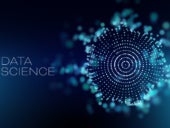
What is Data Science? Benefits, Techniques and Use Cases
Data science involves extracting valuable insights from complex datasets. While this process can be technically challenging and time-consuming, it can lead to better business decision-making.

Gartner’s 7 Predictions for the Future of Australian & Global Cloud Computing
An explosion in AI computing, a big shift in workloads to the cloud, and difficulties in gaining value from hybrid cloud strategies are among the trends Australian cloud professionals will see to 2028.

OpenAI Adds PwC as Its First Resale Partner for the ChatGPT Enterprise Tier
PwC employees have 100,000 ChatGPT Enterprise seats. Plus, OpenAI forms a new safety and security committee in their quest for more powerful AI, and seals media deals.

What Is Contact Management? Importance, Benefits and Tools
Contact management ensures accurate, organized and accessible information for effective communication and relationship building.

How to Use Tableau: A Step-by-Step Tutorial for Beginners
Learn how to use Tableau with this guide. From creating visualizations to analyzing data, this guide will help you master the essentials of Tableau.
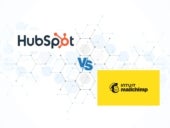
HubSpot CRM vs. Mailchimp (2024): Which Tool Is Right for You?
HubSpot and Mailchimp can do a lot of the same things. In most cases, though, one will likely be a better choice than the other for a given use case.

Top 5 Cloud Trends U.K. Businesses Should Watch in 2024
TechRepublic identified the top five emerging cloud technology trends that businesses in the U.K. should be aware of this year.

Pipedrive vs. monday.com (2024): CRM Comparison
Find out which CRM platform is best for your business by comparing Pipedrive and Monday.com. Learn about their features, pricing and more.

Celoxis: Project Management Software Is Changing Due to Complexity and New Ways of Working
More remote work and a focus on resource planning are two trends driving changes in project management software in APAC and around the globe. Celoxis’ Ratnakar Gore explains how PM vendors are responding to fast-paced change.

SAP vs. Oracle (2024): Which ERP Solution Is Best for You?
Explore the key differences between SAP and Oracle with this in-depth comparison to determine which one is the right choice for your business needs.

How to Create Effective CRM Strategy in 8 Steps
Learn how to create an effective CRM strategy that will help you build stronger customer relationships, improve sales and increase customer satisfaction.

CISOs in Australia Urged to Take a Closer Look at Data Breach Risks
A leading cyber expert in Australia has warned CISOs and other IT leaders their organisations and careers could be at stake if they do not understand data risk and data governance practices.

Snowflake Arctic, a New AI LLM for Enterprise Tasks, is Coming to APAC
Data cloud company Snowflake’s Arctic is promising to provide APAC businesses with a true open source large language model they can use to train their own custom enterprise LLMs and inference more economically.
Create a TechRepublic Account
Get the web's best business technology news, tutorials, reviews, trends, and analysis—in your inbox. Let's start with the basics.
* - indicates required fields
Sign in to TechRepublic
Lost your password? Request a new password
Reset Password
Please enter your email adress. You will receive an email message with instructions on how to reset your password.
Check your email for a password reset link. If you didn't receive an email don't forgot to check your spam folder, otherwise contact support .
Welcome. Tell us a little bit about you.
This will help us provide you with customized content.
Want to receive more TechRepublic news?
You're all set.
Thanks for signing up! Keep an eye out for a confirmation email from our team. To ensure any newsletters you subscribed to hit your inbox, make sure to add [email protected] to your contacts list.
share this!
May 29, 2024
This article has been reviewed according to Science X's editorial process and policies . Editors have highlighted the following attributes while ensuring the content's credibility:
fact-checked
peer-reviewed publication
trusted source
To what extent are pharmaceutical and illicit drugs contaminating city rivers?

In research published in Environmental Toxicology & Chemistry , investigators sampled water from 19 locations across the Hudson and East Rivers in 2021 and 2022 to identify and quantify the prescribed pharmaceuticals and drugs of abuse that are making their way into New York City's rivers and to determine the source of these pollutants.
Metoprolol and atenolol ( blood pressure medications ), benzoylecgonine (the main metabolite of cocaine), methamphetamine (a stimulant), and methadone (an opioid) were the most prevalent drugs, present in more than 60% of water samples .
More drugs and higher concentrations were detected in water contaminated by Enterococci (bacteria that live in the intestinal tract) and after rainfall, indicating an impact from sewer overflow. However, the presence of drugs in clean water and during periods of dry weather indicated that wastewater treatment plant discharge may also contribute to the presence of drugs in rivers.
"This study shows how pharmaceuticals and drugs of abuse enter the New York City aquatic environment , highlighting the necessity of improving the current water management system," said corresponding author Marta Concheiro-Guisan, PharmD, Ph.D., of the John Jay College of Criminal Justice.
Journal information: Environmental Toxicology and Chemistry
Provided by Wiley
Explore further
Feedback to editors

Greener, more effective termite control: Natural compound attracts wood eaters
25 minutes ago

Shear genius: Researchers find way to scale up wonder material, which could do wonders for the Earth
29 minutes ago

New vestiges of the first life on Earth discovered in Saudi Arabia
14 hours ago

Mussels downstream of wastewater treatment plant contain radium, study reports
16 hours ago

A new way to see viruses in action: Super-resolution microscopy provides a nano-scale look

Martian meteorites deliver a trove of information on red planet's structure

New imager acquires amplitude and phase information without digital processing
17 hours ago

AI helps scientists understand cosmic explosions

'Forever chemical' discovery can aid drinking water treatment

Mountain building linked to major extinction event half a billion years ago
Relevant physicsforums posts, iceland warming up again - quakes swarming.
18 hours ago
Mount Ibu, Indonesia erupts
Adirondack mountains and earthquakes.
May 23, 2024
The Secrets of Prof. Verschure's Rosetta Stones
Mt. vesuvius 1944 eruption light show -- static electricity.
May 22, 2024
Can a glass of water be filled to its edge?
May 21, 2024
More from Earth Sciences
Related Stories

Bacterial genes responsible for breaking down metformin in sewer water discovered
Mar 4, 2024

Opioids and cocaine are a deadly combination, and 'polydrug' deaths are rising
Aug 1, 2023

Crackdown on illicit drugs detects rise in 'designer' drug substitutes
Mar 25, 2024

River sampling study shows impact of COVID-19 pandemic on London's waterways
Sep 20, 2023

Medicinal drugs pollute the St. Lawrence River, presenting possible risk to aquatic organisms: Study
Jan 31, 2024

More than 50 chemicals discovered in water off Hampshire and West Sussex coasts
Jun 9, 2023
Recommended for you

No new fossil fuel projects needed in the transition to Net Zero, researchers say
19 hours ago

Study of radioiodine sorption and transport could help protect groundwater

Reduced sulfur content in shipping fuel associated with increased maritime atmospheric warming
May 30, 2024

A local bright spot among melting glaciers: 2,000 km of Antarctic ice-covered coastline has been stable for 85 years
Let us know if there is a problem with our content.
Use this form if you have come across a typo, inaccuracy or would like to send an edit request for the content on this page. For general inquiries, please use our contact form . For general feedback, use the public comments section below (please adhere to guidelines ).
Please select the most appropriate category to facilitate processing of your request
Thank you for taking time to provide your feedback to the editors.
Your feedback is important to us. However, we do not guarantee individual replies due to the high volume of messages.
E-mail the story
Your email address is used only to let the recipient know who sent the email. Neither your address nor the recipient's address will be used for any other purpose. The information you enter will appear in your e-mail message and is not retained by Phys.org in any form.
Newsletter sign up
Get weekly and/or daily updates delivered to your inbox. You can unsubscribe at any time and we'll never share your details to third parties.
More information Privacy policy
Donate and enjoy an ad-free experience
We keep our content available to everyone. Consider supporting Science X's mission by getting a premium account.
E-mail newsletter

IMAGES
VIDEO
COMMENTS
Artificial intelligence technology research topics. We started 2023 with M3GAN's box office success, and now we're fascinated (or horrified) with ChatGPT, voice cloning, and deepfakes. While people have discussed artificial intelligence for ages, recent advances have really pushed this topic to the front of our minds.
Founded at the Massachusetts Institute of Technology in 1899, MIT Technology Review is a world-renowned, independent media company whose insight, analysis, reviews, interviews and live events ...
177 of the Finest Technology Research Topics in 2023. We live in a technological era, and you can be sure of being asked to write a technology-oriented paper. Despite the contrary opinion that this is one of the most complicated tasks, students can comfortably develop a professional topic about technology for writing a research paper.
Seven technologies to watch in 2022. Our fifth annual round-up of the tools that look set to shake up science this year. The Telomere-to-Telomere Consortium is sequencing whole chromosomes. Credit ...
This editorial continues our annual effort to identify and catalog trends and popular topics in the field of educational technology. Continuing our approach from previous years (Kimmons, 2020; Kimmons et al., 2021), we use public internet data mining methods (Kimmons & Veletsianos, 2018) to extract and analyze data from three large data sources: the Scopus research article database, the ...
Finding and choosing a strong research topic is the critical first step when it comes to crafting a high-quality dissertation, thesis or research project. If you've landed on this post, chances are you're looking for a computer science-related research topic, but aren't sure where to start.Here, we'll explore a variety of CompSci & IT-related research ideas and topic thought-starters ...
This study builds on the trend research we shared last year, ... compared with other topics and are also attracting significant investments ($2 billion minimum in 2021). 1The innovation score combines the 0-1 scores for ... Technology Trends Outlook 2022. 2 technology. 20 ...
By 2022, multicore will be everywhere, from wearable systems and smartphones to cameras, games, automobiles, cloud servers, and exa-scale supercomputers. Photonics. Silicon photonics will be a fundamental technology to address the bandwidth, latency, and energy challenges in the fabric of high-end systems. Networking and Interconnectivity.
The dizzying pace of research and innovation at MIT can make it hard to keep up. To mark the end of the year, MIT News is looking back at 10 of the research stories that generated the most excitement in 2022. We've also rounded up the year's top MIT community-related stories. Designing a heat engine with no moving parts. In April, engineers ...
The technology relies on Bayesian inference to reduce the training time for complex tasks. Research Highlight 22 Dec 2022. Where baby birds thrive: plush but precarious hangouts.
Find the answers to your biggest research questions from 2022. With collective views of over 3.2 million, researchers explored topics spanning from vaccine safe
This article will consider major research topics on different technology research topics so that researchers and students planning to write a thesis or research paper can select from them and start their project immediately. ... Apr 20, 2022. 10 min read. Technology and Computer Science Research Topics. Read more. Browse all.
Technology News. Read the latest technology news on SciTechDaily, your comprehensive source for the latest breakthroughs, trends, and innovations shaping the world of technology. We bring you up-to-date insights on a wide array of topics, from cutting-edge advancements in artificial intelligence and robotics to the latest in green technologies ...
Information technology is the design and implementation of computer networks for data processing and communication. This includes designing the hardware for processing information and connecting ...
For the 50-plus overall, 66% use technology to connect with others, 59% use it for entertainment, and 47% find it helpful to manage responsibilities. Many also use technology to stay healthy (43%), to learn a new skill (38%), or to pursue a passion (36%). Unsurprisingly, embracing technology to maintain personal independence rises with age: 22% ...
Here are the eight hottest topics for 2022, starting with No 8. 8. Augmented, mixed and virtual reality ... "The pedagogy and learning strategies are rising to the top more than the technology topics," Gagliolo said. ... It covers ways to encourage community and interaction among students and teachers as well as an awareness of research on ...
Americans' Views of Technology Companies. Most Americans are wary of social media's role in politics and its overall impact on the country, and these concerns are ticking up among Democrats. Still, Republicans stand out on several measures, with a majority believing major technology companies are biased toward liberals. short readsApr 3, 2024.
Published online: 23 February 2022. Association for Educational Communications & Technology 2022. This editorial continues our annual efort to identify and catalog trends and popular topics in the ield of educational technology. Continuing our approach from previous years (Kimmons, 2020; Kimmons et al., 2021), we use public internet data mining ...
It is a critical venue for exchanging information about crucial topics these days. ... (2022), pp. 227-261. CrossRef Google Scholar [30] B.E. Penprase. The fourth industrial revolution and higher education. Higher education in the era of the fourth industrial revolution, 10 (2018 ... Educational Technology Research and Development, 69 (2) (2021 ...
The top strategic technology trends for 2022 are: Generative Artificial Intelligence (AI) One of the most visible and powerful AI techniques coming to market is generative AI - machine learning methods that learn about content or objects from their data, and use it to generate brand-new, completely original, realistic artifacts.
In 2019, IUPAC launched the "Top Ten Emerging Technologies in Chemistry Initiative." [1] This project, nowadays consolidated and recognised by experts worldwide, highlights the value of chemical sciences in the transition to a green economy and a more sustainable world, in line with the United Nations' Sustainable Development Goals (SDGs) [2]. Moreover, in 2022 we join the celebration of ...
Electrical and electronic engineering is the branch of engineering that makes use of electricity. Electrical engineering concentrates on systems for generating and transmitting large electrical ...
Americans' Use of Mobile Technology and Home Broadband. Most U.S. adults today say they use the internet (95%), have a smartphone (90%) or subscribe to high-speed internet at home (80%). About four-in-ten report being online almost constantly. fact sheetJan 5, 2024.
Over the last four decades, studies have investigated the incorporation of Artificial Intelligence (AI) into education. A recent prominent AI-powered technology that has impacted the education sector is ChatGPT. This article provides a systematic review of 14 empirical studies incorporating ChatGPT into various educational settings, published in 2022 and before the 10th of April 2023—the ...
Risk Analysis is an international journal publishing new developments, empirical research and commentaries on a wide range of topics in the field of risk analysis. Abstract The ups and downs of climate policy uncertainty (CPU) cast a captivating shadow over the budgets allocated to renewable energy (RE) technologies, where strategic choices and ...
Apache Spark and Hadoop, Microsoft Power BI, Jupyter Notebook and Alteryx are among the top data science tools for finding business insights. Compare their features, pros and cons. By Aminu ...
Eighty-two percent use thought leadership e-books/white papers, 81% use long articles/posts, 63% use data visualizations/visual content, 62% use product/technical data sheets, and 56% use research reports. Less than half of technology marketers use brochures (45%), interactive content (35%), livestreaming content (34%), and audio content (31%).
In research published in Environmental Toxicology & Chemistry, investigators sampled water from 19 locations across the Hudson and East Rivers in 2021 and 2022 to identify and quantify the ...